Paul van Yperen's Blog
October 2, 2025
Animal Crackers
Tomorrow, 4 October 2025, it is World Animal Day for the 100th time. The World Animal Day 2025 theme is… 'Save Animals, Save the Planet!' For the occasion, we selected 18 postcards with different animals and film stars. And some of the animals were film stars too!

German postcard by Ross Verlag, no. 669/1, 1919-1924. Photo: Transocean-Film-Co., Berlin. A cow with Jackie Coogan in Daddy (1923).
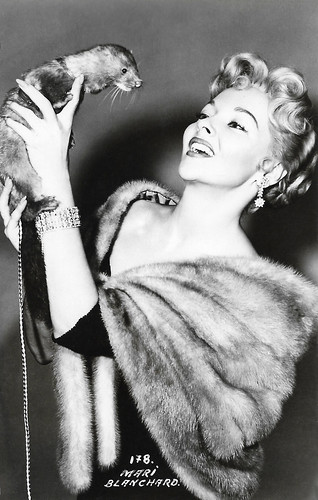
Spanish postcard, no. 178. A Mink with Mari Blanchard .
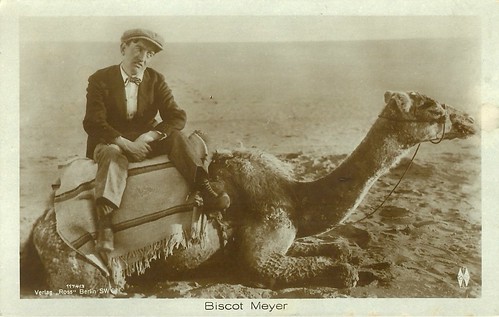
German postcard by Ross Verlag, Berlin, no. 1174/3, 1927-1928. A Dromedary and Georges Biscot , presented in Germany as 'Biscot Meyer', in L'orpheline / The orphan (Louis Feuillade, 1921).
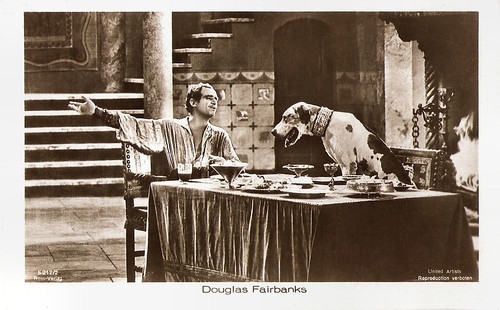
German postcard by Ross-Verlag, no. 5212/2, 1930-1931. Photo: K.O. Rahmn (Knut Olaf Rahmn) / United Artists. A Great Dane and Douglas Fairbanks in The Taming of the Shrew (Sam Taylor, 1930).
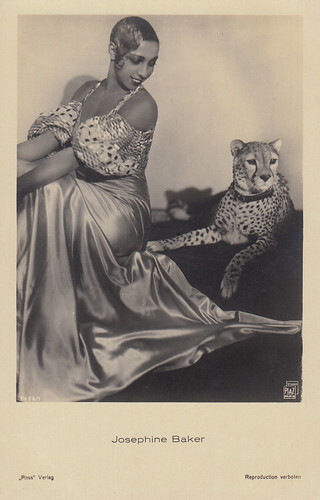
German postcard by Ross Verlag, no. 7426/1, 1932-1933. Photo: Studio Piaz. Collection: Marlene Pilaete. Josephine Baker with Chiquita, her pet Cheetah.
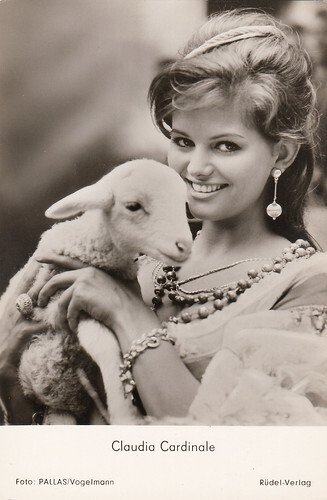
German postcard by Rüdel Verlag, no. 3561. Photo: PALLAS / Vogelmann. A Lamb and Claudia Cardinale in Cartouche (Philippe de Broca, 1962). Collection: Marlene Pilaete.

American postcard by Fotofolio, NY, NY, no. P 348. Photo: Phil Stern. Monkeys and Peter Finch in The Flight of the Phoenix (Robert Aldrich, 1965).
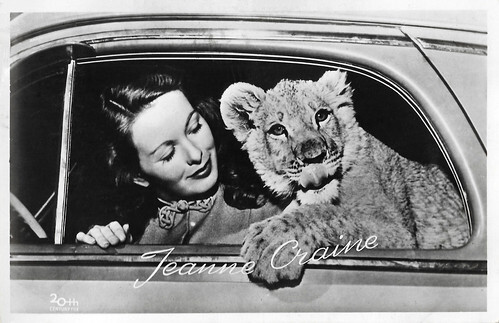
Dutch postcard, no. 3430. Sent by mail in 1950. Photo: 20th Century Fox. Jeanne Crain with her pet Lion, Shah-Shah. Crain later gave the lion to the Los Angeles Zoo. Her surname is mistakenly written here as Craine.
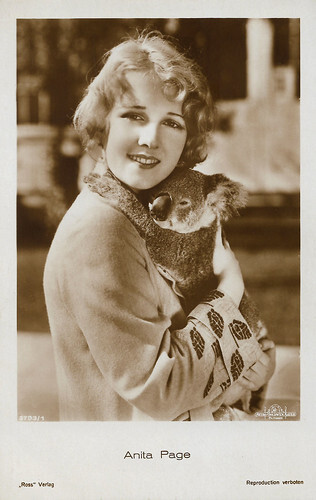
German postcard by Ross Verlag, no. 3793/1, 1928-1929. Photo: Metro-Goldwyn-Mayer. A Koala Bear with Anita Page .
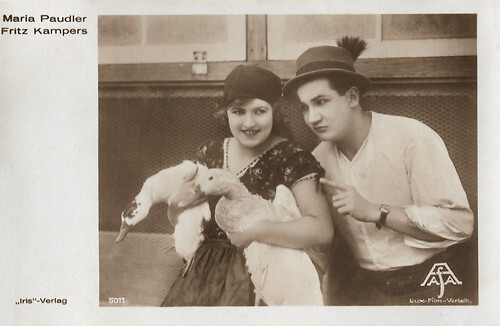
Austrian postcard by Iris-Verlag, no. 5011. Photo: AAFA Film / Lux Film-Verleih. Two Geese and Maria Paudler and Fritz Kampers in Heiratsfieber / Marriage Fever (Rudolf Walther-Fein, 1928).
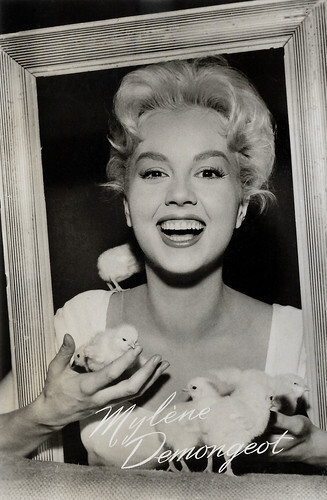
Dutch postcard by Uitg. Takken, Utrecht, no. AX 3864. Chicks and Mylène Demongeot .

French postcard by Grafique de France, no. SC 109. Photo: Dennis Stock, 1954. A Pig and James Dean . Dean asked Stock to accompany him to his family's farm in Fairmount, Indiana to celebrate his birthday. The photo was published in Life Magazine in 1955. Dennis Stock called this photo 'Ferrotype With Sow' because it reminded him of the old tintype pictures they used to take when photography was in its infancy.
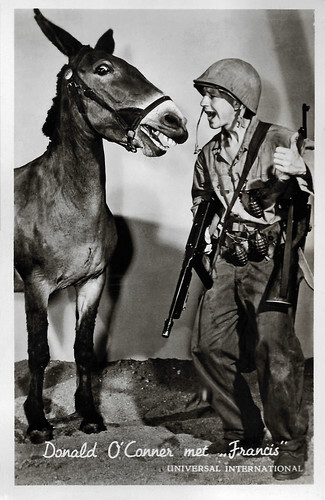
Belgian postcard by Nieuwe Merksemsche Chocolaterie S.P.R.L, Merksem (Anvers), no. B 16. Photo: Universal International. Francis the Talking Mule and Donald O'Connor in Francis in the Navy (Arthur Lubin, 1955).
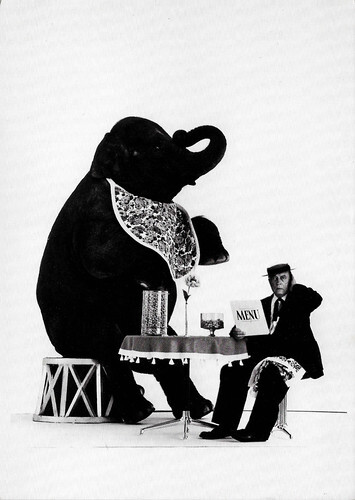
American postcard by Fotofolio, NY, NY, no. P148. Photo: Sid Avery, 1964. Bimbo the Elephant and Buster Keaton . The photo was made for an ad for US Steel.
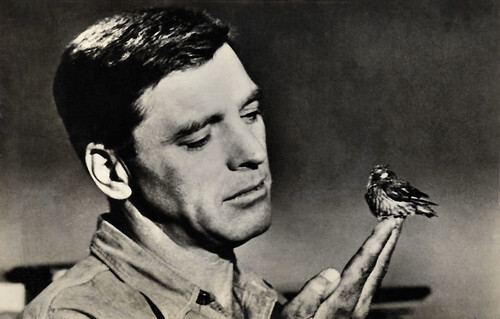
Czech collector card by Pressfoto, Praha, no. S 37.8. A Sparrow and Burt Lancaster in Birdman of Alcatraz (John Frankenheimer, 1962).
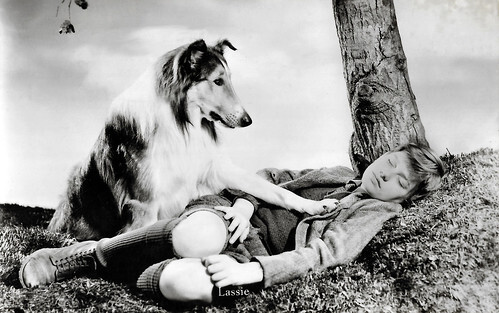
Dutch postcard by Gebr. Spanjersberg N.V., Rotterdam. Pal and Roddy McDowall in Lassie Come Home (Fred M. Wilcox, 1943).
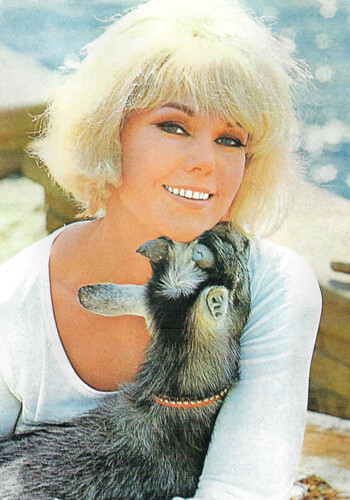
Romanian postcard by Casa Filmului Acin. A Goat and Kim Novak .
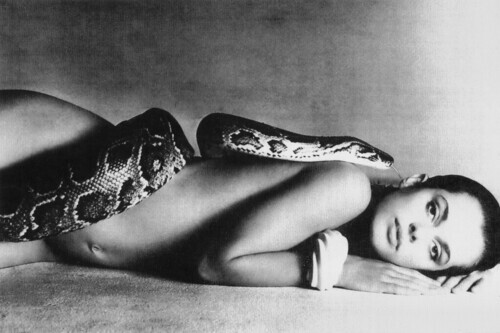
British postcard in the Photographs series, no. 101. Photo: Richard Avedon. A boa constrictor and Nastassja Kinski . The photo title is 'Nastassja and the Serpent'.
"According to American Vogue stylist Polly Mellen, the arrival of a snake on set was an unexpected turn of events. “We were in Los Angeles, and the shoot had already started. We were just doing fashion pictures,” she recalls in the 2001 documentary In Vogue: The Editor’s Eye. Looking for something to give the images a little extra kick, she asked model Nastassja Kinski if she had any ideas. Kinski’s reply? A boa constrictor. Naturally.
In 1981, Kinski was at the height of her career, modelling for the world’s leading fashion titles and appearing on screen for cutting-edge auteurs from Polanski to Wim Wenders. The legendary Richard Avedon had been charged by editor-in-chief Diana Vreeland with capturing the woman of the moment: following his blockbuster 1977 show at the Metropolitan Museum of Art, the largest photographic retrospective the institution had ever staged, Avedon was arguably America’s most famous lensman.
The creative alchemy between these two industry titans would produce one of the most referenced fashion images ever, most recently recreated by Patrick Demarchelier and Jennifer Lawrence for Vanity Fair. Swiftly put into production by Condé Nast as a poster, Nastassja and the Serpent became ubiquitous as the décor feature of choice for any testosterone-fuelled 80s college dorm.
“What I find interesting is that you have this incredibly famous male photographer, so you assume that he’s in control and calling the shots,” explains Sotheby’s Head of Photographs, Brandei Estes. “But then here’s this 21-year-old sex symbol saying, let’s do it with a snake and in the nude. Kinski was completely calm and in control and professional, even as she lay on cold concrete for hours with the snake hooked around her feet.”"
Source: Liam Hess (AnOther).
Please also check out EFSP's Animal House.

German postcard by Ross Verlag, no. 669/1, 1919-1924. Photo: Transocean-Film-Co., Berlin. A cow with Jackie Coogan in Daddy (1923).

Spanish postcard, no. 178. A Mink with Mari Blanchard .

German postcard by Ross Verlag, Berlin, no. 1174/3, 1927-1928. A Dromedary and Georges Biscot , presented in Germany as 'Biscot Meyer', in L'orpheline / The orphan (Louis Feuillade, 1921).

German postcard by Ross-Verlag, no. 5212/2, 1930-1931. Photo: K.O. Rahmn (Knut Olaf Rahmn) / United Artists. A Great Dane and Douglas Fairbanks in The Taming of the Shrew (Sam Taylor, 1930).

German postcard by Ross Verlag, no. 7426/1, 1932-1933. Photo: Studio Piaz. Collection: Marlene Pilaete. Josephine Baker with Chiquita, her pet Cheetah.

German postcard by Rüdel Verlag, no. 3561. Photo: PALLAS / Vogelmann. A Lamb and Claudia Cardinale in Cartouche (Philippe de Broca, 1962). Collection: Marlene Pilaete.

American postcard by Fotofolio, NY, NY, no. P 348. Photo: Phil Stern. Monkeys and Peter Finch in The Flight of the Phoenix (Robert Aldrich, 1965).

Dutch postcard, no. 3430. Sent by mail in 1950. Photo: 20th Century Fox. Jeanne Crain with her pet Lion, Shah-Shah. Crain later gave the lion to the Los Angeles Zoo. Her surname is mistakenly written here as Craine.

German postcard by Ross Verlag, no. 3793/1, 1928-1929. Photo: Metro-Goldwyn-Mayer. A Koala Bear with Anita Page .

Austrian postcard by Iris-Verlag, no. 5011. Photo: AAFA Film / Lux Film-Verleih. Two Geese and Maria Paudler and Fritz Kampers in Heiratsfieber / Marriage Fever (Rudolf Walther-Fein, 1928).

Dutch postcard by Uitg. Takken, Utrecht, no. AX 3864. Chicks and Mylène Demongeot .

French postcard by Grafique de France, no. SC 109. Photo: Dennis Stock, 1954. A Pig and James Dean . Dean asked Stock to accompany him to his family's farm in Fairmount, Indiana to celebrate his birthday. The photo was published in Life Magazine in 1955. Dennis Stock called this photo 'Ferrotype With Sow' because it reminded him of the old tintype pictures they used to take when photography was in its infancy.

Belgian postcard by Nieuwe Merksemsche Chocolaterie S.P.R.L, Merksem (Anvers), no. B 16. Photo: Universal International. Francis the Talking Mule and Donald O'Connor in Francis in the Navy (Arthur Lubin, 1955).

American postcard by Fotofolio, NY, NY, no. P148. Photo: Sid Avery, 1964. Bimbo the Elephant and Buster Keaton . The photo was made for an ad for US Steel.

Czech collector card by Pressfoto, Praha, no. S 37.8. A Sparrow and Burt Lancaster in Birdman of Alcatraz (John Frankenheimer, 1962).

Dutch postcard by Gebr. Spanjersberg N.V., Rotterdam. Pal and Roddy McDowall in Lassie Come Home (Fred M. Wilcox, 1943).

Romanian postcard by Casa Filmului Acin. A Goat and Kim Novak .

British postcard in the Photographs series, no. 101. Photo: Richard Avedon. A boa constrictor and Nastassja Kinski . The photo title is 'Nastassja and the Serpent'.
"According to American Vogue stylist Polly Mellen, the arrival of a snake on set was an unexpected turn of events. “We were in Los Angeles, and the shoot had already started. We were just doing fashion pictures,” she recalls in the 2001 documentary In Vogue: The Editor’s Eye. Looking for something to give the images a little extra kick, she asked model Nastassja Kinski if she had any ideas. Kinski’s reply? A boa constrictor. Naturally.
In 1981, Kinski was at the height of her career, modelling for the world’s leading fashion titles and appearing on screen for cutting-edge auteurs from Polanski to Wim Wenders. The legendary Richard Avedon had been charged by editor-in-chief Diana Vreeland with capturing the woman of the moment: following his blockbuster 1977 show at the Metropolitan Museum of Art, the largest photographic retrospective the institution had ever staged, Avedon was arguably America’s most famous lensman.
The creative alchemy between these two industry titans would produce one of the most referenced fashion images ever, most recently recreated by Patrick Demarchelier and Jennifer Lawrence for Vanity Fair. Swiftly put into production by Condé Nast as a poster, Nastassja and the Serpent became ubiquitous as the décor feature of choice for any testosterone-fuelled 80s college dorm.
“What I find interesting is that you have this incredibly famous male photographer, so you assume that he’s in control and calling the shots,” explains Sotheby’s Head of Photographs, Brandei Estes. “But then here’s this 21-year-old sex symbol saying, let’s do it with a snake and in the nude. Kinski was completely calm and in control and professional, even as she lay on cold concrete for hours with the snake hooked around her feet.”"
Source: Liam Hess (AnOther).
Please also check out EFSP's Animal House.
Published on October 02, 2025 22:00
October 1, 2025
EFSP's 10 most-viewed blogs since 2010
You may have noticed that the number of page views for this blog is now displayed in two rows. Earlier this week, EFSP passed 10 million page views - since January 2010, when Blogger started counting. For those who enjoy statistics, EFSP had 267,964 page views last month. A new record.
We, Ivo Blom and Paul van Yperen, started this blog in 2008 at a time when blogs were in vogue. Interesting and quirky blogs were popping up like mushrooms, purely for the fun of creating in cyberspace. Now, in 2025, European Film Star Postcards is one of the last of its kind. But just like Asterix and his Gaulish village, we are holding our own in an increasingly commercial online world.
We are happy to continue EFSP. And we are lucky we can do this without advertisements, a paywall or a fundraising campaign, and with friends who write amazing guest posts, like our special guest star Marlene 'La Collectionneuse' Pilaete, others who correct our mistakes like Erhanizzet Oncel, or who share their postcard collections with us, like Egbert Barten, founder of the Geoffrey Donaldson Institute. Thank you! We are also grateful for all the creators of the sources we can (still) use freely and, of course, we salute the publishers, filmmakers, photographers and film stars for their wonderful postcards.
For this special occasion, we selected the 10 most-viewed blog posts since January 2010.
On 31 January 2014, EFSP posted an I.M. for Lebanese actress and former belly dancer Aïché Nana (1940-2014), two days after her death. In 1958, a 'striptease' by the then 18-year-old Nana at a Roman party caused an international scandal. Subsequently, she became one of the icons of ‘La Dolce Vita’, the liberated era of sex, drugs and rock & roll as documented by Federico Fellini. Aïché Nana appeared in 15 European films between 1956 and 1985. Her post was viewed 8.580 times.
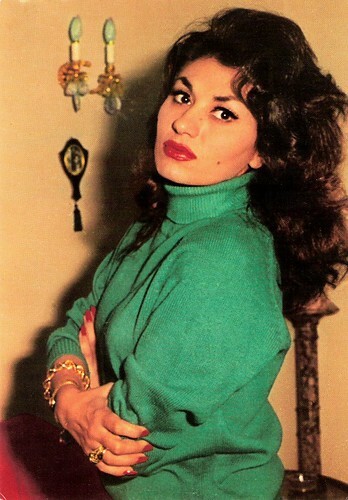
Italian postcard by Rotalcolor, Milano (Milan), no. 238.
Number 9: 11 German directors of the silent era
During the 14 years which comprise the Weimar period, the German film industry enjoyed an unprecedented development. Each year, an average of 250 films were produced, and about 230 film companies were active in Berlin alone. This month, we will focus on the men and women who directed these films. The most famous directors in this industry were Fritz Lang, Friedrich Wilhelm Murnau and Ernst Lubitsch, who all later had success in Hollywood and about whom we posted before. On 8 May 2024, EFSP presented 11 directors who were less famous but who all made several interesting silent films during the 1910s and 1920s. The first director in the post was Fern Andra (1893-1974). She became one of the most popular film stars of German cinema in the 1910s and early 1920s. In 1913, aged 19, she appeared in her first German film, Das Ave Maria / The Ave Maria (Charles Decroix, 1913). Soon, she started her own company, even directing her own films. Georg Glen was the manager of her studio, Fern Andra Atelier. The company produced more than 80 films during World War I. This post was viewed 8.820 times.
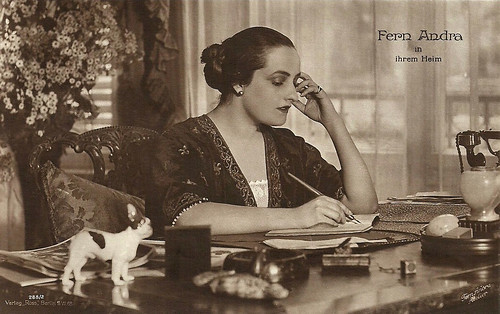
German postcard by Ross Verlag, Berlin, no. 288/2, 1919-1924. Photo: Fern Andra Atelier. Caption: Fern Andra in ihrem Heim (Fern Andra at her home).
Number 8: Claudia Cardinale (1938-2025) - Part 1
One of Europe's iconic and most versatile film stars was Italian actress Claudia Cardinale (1938-2025). The combination of her beauty, dark, flashing eyes, explosive sexuality and genuine acting talent virtually guaranteed her stardom. Her most notable films include the classics 8½ (Federico Fellini, 1963), Il Gattopardo (Luchino Visconti, 1963), and Once Upon a Time in the West (Sergio Leone, 1968). One post was not enough to commemorate La CC, and Part 2 followed the next day. We updated the post for her death earlier this year, but the original version was published on 1 July 2010 and had 9,960 page views.
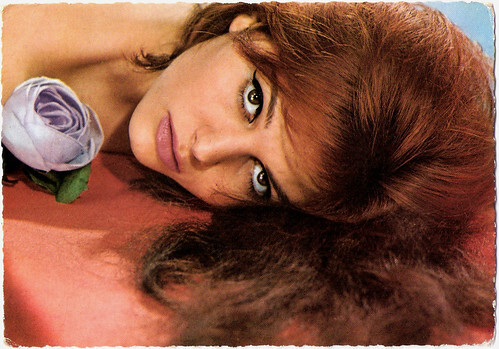
French postcard by E.D.U.G., no. 316. Photo: Sam Lévin.
Number 7: Bud Spencer
An I.M. for Bud Spencer (1929-2016) on 10 July 2016 had 10,704 page views. The huge Italian actor with his trademark black beard was the popular star of many Spaghetti Westerns and low-budget action films of the late 1960s and 1970s. In 18 films, he co-starred with his long-time film partner Terence Hill. In his youth, Spencer (then: Carlo Pedersoli) was the first Italian to swim 100 metres in less than a minute. He also had a law degree, and he registered several patents.
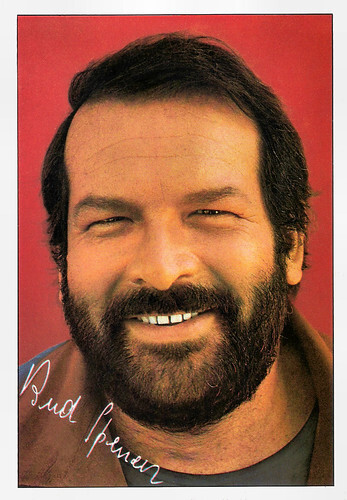
German autograph card by BRAVO.
Number 6: Lupu Pick
Lupu Pick (1886-1931) was a Romanian-German actor, film director, producer, and screenwriter of the silent era. His style as a director differed substantially from the macabre, expressionist fantasies prevalent in German cinema at the time. Together with screenwriter Carl Mayer, he introduced Kammerspielfilme (chamber drama films), intimate psychological dramas about ordinary people in extraordinary circumstances. In the mid-1920s, he briefly returned to acting and then made several films in England and France. Our post on 28 November 2024 was viewed 10.800 times.
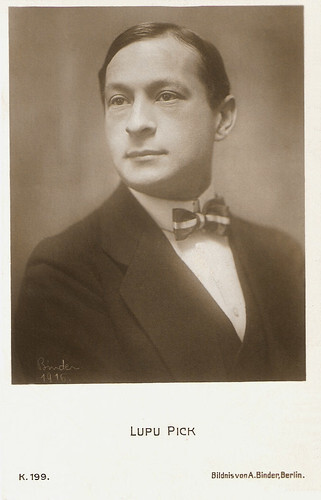
German postcard by Verlag Photochemie, Berlin, no. K. 199. Photo: Alex Binder, 1916.
Number 5: Marina Vlady
Sensual and alluring French star Marina Vlady (1938) had the makings of just another blonde bombshell, but in 1963, she stunned everybody with her performance in L’Ape Regine / The Conjugal Bed. At the Cannes Film Festival, the feline beauty won that year the Golden Palm for Best Actress. The post on 7 July 2012 counted 13,600 page views.
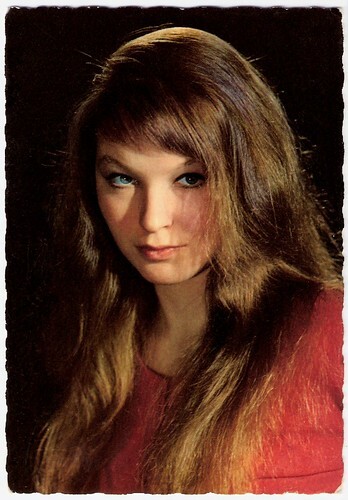
French postcard by E.D.U.G., no. 74. Photo: Sam Levin.
Number 4: Martine Carol
One of the French cinema's most beautiful women was Martine Carol (1920-1967). During the early 1950s, the French sex symbol was a top box office draw as an elegant blonde seductress in many films and was often compared to Marilyn Monroe. Her private life was filled with turmoil, including a suicide attempt, drug abuse, a kidnapping, and her mysterious death at only 46. Her post, last updated on 21 February 2022, is a continuing success and has 16,200 page views.
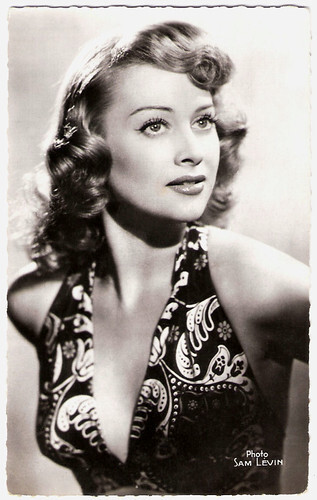
French postcard by Editions du Globe (E.D.U.G.), Paris, no. 132. Photo: Sam Lévin.
Number 3: Italian postcards by Cines-Pittaluga
In 2019, Ivo Blom acquired a great series of Italian postcards from the early 1930s at the Il Cinema Ritrovato Book Fair in Bologna. All the postcards were published by the film company Cines-Pittaluga to promote their own films. The head of this company, Stefano Pittaluga (1887-1932), helped revive Italian film production in the late 1920s and early 1930s. In 1926, he acquired the pioneering film studio Cines from the conglomerate Unione Cinematografica Italiana. Cines produced the first Italian sound film, La canzone dell'amore / The Song of Love (1930), and became the dominant force of the early sound era. Under Pittaluga, the company specialised in musicals and comedies, of which many were later branded 'Telefoni Bianchi' (White Telephone films).
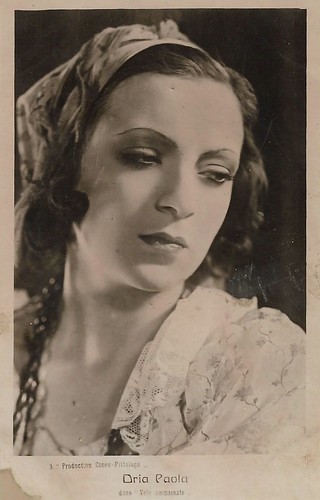
Italian postcard by Cines-Pittaluga, no. 3. Photo: Cines-Pittaluga. Dria Paola in Vele ammainate / Lowered Sails (Anton Giulio Bragaglia, 1931).
Number 2: Sepia postcards by Cinémagazine
This 'New acquisitions' post on 14 Sept 2019 was viewed 24.600 times since then. In 2019, Ivo Blom bought a series of sepia postcards of silent film stars published by Editions Cinémagazine in Paris. Cinémagazine-Edition, or just CE, was the publisher of the film magazine of the same name, which was popular all over Europe. It was a weekly magazine that existed between 1921 and 1935. Charles Ray (1891-1943) was an American actor, scriptwriter, and director of the silent screen, who knew a parable from rags to riches and back again, working for e.g. Paramount, his own company, United Artists and MGM. In the late 1910s and early 1920s, he was a very popular actor and one of Hollywood's best-paid stars.
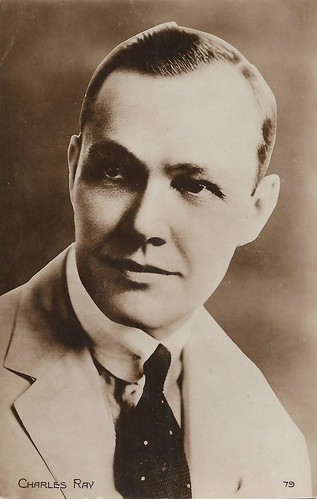
French postcard by Editions Cinémagazine, no. 79. Photo: not indicated but could be made by Evans.
Number 1: Alain Delon (1935-2024)
On 18 August 2024, French film star Alain Delon (1935) died at the age of 88. A day later, we had updated a post about this breathtakingly good-looking 'James Dean of European cinema' in the late 1950s and early 1960s. He proved in such films as Plein soleil / Purple Noon (René Clément, 1960) Rocco e i suoi fratelli / Rocco and his brothers (Luchino Visconti, 1960) and L'eclisse/The Eclipse (Michelangelo Antonioni, 1962) that he was also a magnificent actor. Delon later starred in a series of popular gangster films by directors like Henri Verneuil, Jacques Deray and Jean-Pierre Melville.

East German postcard by VEB Progress Film-Vertrieb, Berlin, 1967. Retail price: 0,20 MDN. Photo: Alain Delon in Rocco e i suoi fratelli / Rocco and his brothers (Luchino Visconti, 1960).
And thank you for visiting us. We love your comments.
We, Ivo Blom and Paul van Yperen, started this blog in 2008 at a time when blogs were in vogue. Interesting and quirky blogs were popping up like mushrooms, purely for the fun of creating in cyberspace. Now, in 2025, European Film Star Postcards is one of the last of its kind. But just like Asterix and his Gaulish village, we are holding our own in an increasingly commercial online world.
We are happy to continue EFSP. And we are lucky we can do this without advertisements, a paywall or a fundraising campaign, and with friends who write amazing guest posts, like our special guest star Marlene 'La Collectionneuse' Pilaete, others who correct our mistakes like Erhanizzet Oncel, or who share their postcard collections with us, like Egbert Barten, founder of the Geoffrey Donaldson Institute. Thank you! We are also grateful for all the creators of the sources we can (still) use freely and, of course, we salute the publishers, filmmakers, photographers and film stars for their wonderful postcards.
For this special occasion, we selected the 10 most-viewed blog posts since January 2010.
On 31 January 2014, EFSP posted an I.M. for Lebanese actress and former belly dancer Aïché Nana (1940-2014), two days after her death. In 1958, a 'striptease' by the then 18-year-old Nana at a Roman party caused an international scandal. Subsequently, she became one of the icons of ‘La Dolce Vita’, the liberated era of sex, drugs and rock & roll as documented by Federico Fellini. Aïché Nana appeared in 15 European films between 1956 and 1985. Her post was viewed 8.580 times.

Italian postcard by Rotalcolor, Milano (Milan), no. 238.
Number 9: 11 German directors of the silent era
During the 14 years which comprise the Weimar period, the German film industry enjoyed an unprecedented development. Each year, an average of 250 films were produced, and about 230 film companies were active in Berlin alone. This month, we will focus on the men and women who directed these films. The most famous directors in this industry were Fritz Lang, Friedrich Wilhelm Murnau and Ernst Lubitsch, who all later had success in Hollywood and about whom we posted before. On 8 May 2024, EFSP presented 11 directors who were less famous but who all made several interesting silent films during the 1910s and 1920s. The first director in the post was Fern Andra (1893-1974). She became one of the most popular film stars of German cinema in the 1910s and early 1920s. In 1913, aged 19, she appeared in her first German film, Das Ave Maria / The Ave Maria (Charles Decroix, 1913). Soon, she started her own company, even directing her own films. Georg Glen was the manager of her studio, Fern Andra Atelier. The company produced more than 80 films during World War I. This post was viewed 8.820 times.

German postcard by Ross Verlag, Berlin, no. 288/2, 1919-1924. Photo: Fern Andra Atelier. Caption: Fern Andra in ihrem Heim (Fern Andra at her home).
Number 8: Claudia Cardinale (1938-2025) - Part 1
One of Europe's iconic and most versatile film stars was Italian actress Claudia Cardinale (1938-2025). The combination of her beauty, dark, flashing eyes, explosive sexuality and genuine acting talent virtually guaranteed her stardom. Her most notable films include the classics 8½ (Federico Fellini, 1963), Il Gattopardo (Luchino Visconti, 1963), and Once Upon a Time in the West (Sergio Leone, 1968). One post was not enough to commemorate La CC, and Part 2 followed the next day. We updated the post for her death earlier this year, but the original version was published on 1 July 2010 and had 9,960 page views.

French postcard by E.D.U.G., no. 316. Photo: Sam Lévin.
Number 7: Bud Spencer
An I.M. for Bud Spencer (1929-2016) on 10 July 2016 had 10,704 page views. The huge Italian actor with his trademark black beard was the popular star of many Spaghetti Westerns and low-budget action films of the late 1960s and 1970s. In 18 films, he co-starred with his long-time film partner Terence Hill. In his youth, Spencer (then: Carlo Pedersoli) was the first Italian to swim 100 metres in less than a minute. He also had a law degree, and he registered several patents.

German autograph card by BRAVO.
Number 6: Lupu Pick
Lupu Pick (1886-1931) was a Romanian-German actor, film director, producer, and screenwriter of the silent era. His style as a director differed substantially from the macabre, expressionist fantasies prevalent in German cinema at the time. Together with screenwriter Carl Mayer, he introduced Kammerspielfilme (chamber drama films), intimate psychological dramas about ordinary people in extraordinary circumstances. In the mid-1920s, he briefly returned to acting and then made several films in England and France. Our post on 28 November 2024 was viewed 10.800 times.

German postcard by Verlag Photochemie, Berlin, no. K. 199. Photo: Alex Binder, 1916.
Number 5: Marina Vlady
Sensual and alluring French star Marina Vlady (1938) had the makings of just another blonde bombshell, but in 1963, she stunned everybody with her performance in L’Ape Regine / The Conjugal Bed. At the Cannes Film Festival, the feline beauty won that year the Golden Palm for Best Actress. The post on 7 July 2012 counted 13,600 page views.

French postcard by E.D.U.G., no. 74. Photo: Sam Levin.
Number 4: Martine Carol
One of the French cinema's most beautiful women was Martine Carol (1920-1967). During the early 1950s, the French sex symbol was a top box office draw as an elegant blonde seductress in many films and was often compared to Marilyn Monroe. Her private life was filled with turmoil, including a suicide attempt, drug abuse, a kidnapping, and her mysterious death at only 46. Her post, last updated on 21 February 2022, is a continuing success and has 16,200 page views.

French postcard by Editions du Globe (E.D.U.G.), Paris, no. 132. Photo: Sam Lévin.
Number 3: Italian postcards by Cines-Pittaluga
In 2019, Ivo Blom acquired a great series of Italian postcards from the early 1930s at the Il Cinema Ritrovato Book Fair in Bologna. All the postcards were published by the film company Cines-Pittaluga to promote their own films. The head of this company, Stefano Pittaluga (1887-1932), helped revive Italian film production in the late 1920s and early 1930s. In 1926, he acquired the pioneering film studio Cines from the conglomerate Unione Cinematografica Italiana. Cines produced the first Italian sound film, La canzone dell'amore / The Song of Love (1930), and became the dominant force of the early sound era. Under Pittaluga, the company specialised in musicals and comedies, of which many were later branded 'Telefoni Bianchi' (White Telephone films).

Italian postcard by Cines-Pittaluga, no. 3. Photo: Cines-Pittaluga. Dria Paola in Vele ammainate / Lowered Sails (Anton Giulio Bragaglia, 1931).
Number 2: Sepia postcards by Cinémagazine
This 'New acquisitions' post on 14 Sept 2019 was viewed 24.600 times since then. In 2019, Ivo Blom bought a series of sepia postcards of silent film stars published by Editions Cinémagazine in Paris. Cinémagazine-Edition, or just CE, was the publisher of the film magazine of the same name, which was popular all over Europe. It was a weekly magazine that existed between 1921 and 1935. Charles Ray (1891-1943) was an American actor, scriptwriter, and director of the silent screen, who knew a parable from rags to riches and back again, working for e.g. Paramount, his own company, United Artists and MGM. In the late 1910s and early 1920s, he was a very popular actor and one of Hollywood's best-paid stars.

French postcard by Editions Cinémagazine, no. 79. Photo: not indicated but could be made by Evans.
Number 1: Alain Delon (1935-2024)
On 18 August 2024, French film star Alain Delon (1935) died at the age of 88. A day later, we had updated a post about this breathtakingly good-looking 'James Dean of European cinema' in the late 1950s and early 1960s. He proved in such films as Plein soleil / Purple Noon (René Clément, 1960) Rocco e i suoi fratelli / Rocco and his brothers (Luchino Visconti, 1960) and L'eclisse/The Eclipse (Michelangelo Antonioni, 1962) that he was also a magnificent actor. Delon later starred in a series of popular gangster films by directors like Henri Verneuil, Jacques Deray and Jean-Pierre Melville.

East German postcard by VEB Progress Film-Vertrieb, Berlin, 1967. Retail price: 0,20 MDN. Photo: Alain Delon in Rocco e i suoi fratelli / Rocco and his brothers (Luchino Visconti, 1960).
And thank you for visiting us. We love your comments.
Published on October 01, 2025 22:00
September 30, 2025
Carolina Otéro
Carolina Otéro (1868-1965), or La belle Otéro, was a Spanish actress, dancer and courtesan. She had a reputation for great beauty and was famous for her numerous lovers. In 1898, she became 'the first star in the history of cinema'. Countless postcards with her circulated.
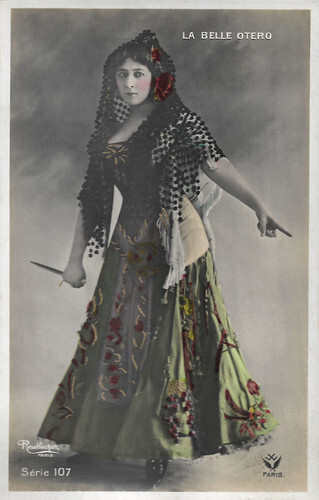
French postcard, Série 107. Photo: Reutlinger, Paris.
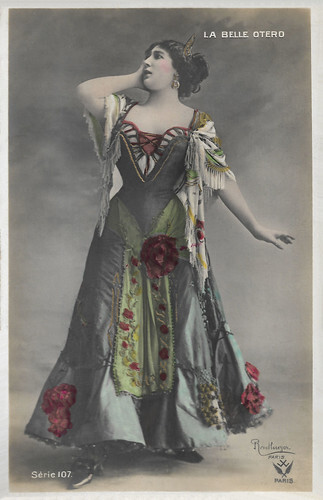
French postcard, Série 107. Photo: Reutlinger, Paris. Caption: La belle Otero.
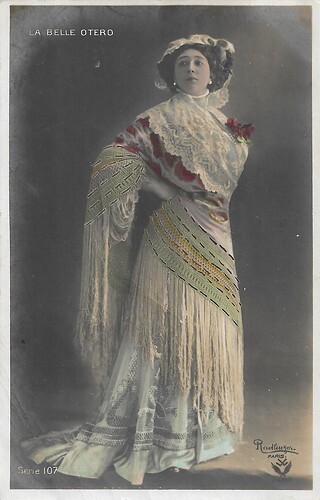
French postcard, Série 107. Photo: Reutlinger, Paris.
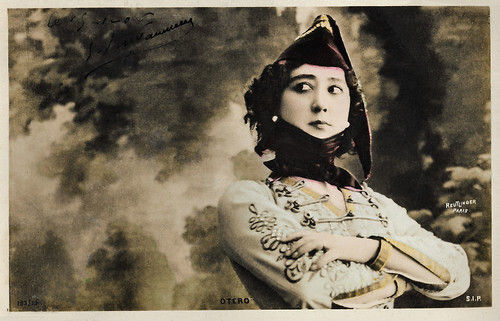
French postcard by S.I.P., no. 193/13. Photo: Reutlinger, Paris.
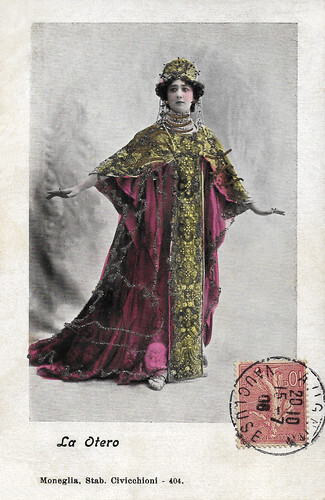
Italian postcard by Moneglia, Stab. Civicchioni, no. 404. Sent by mail in 1906.
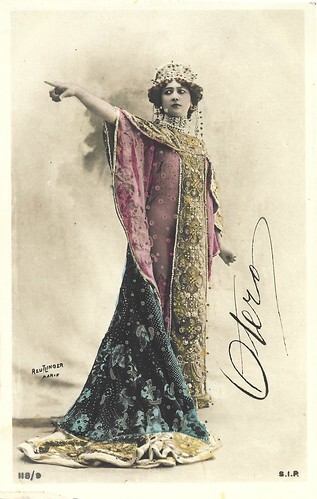
French postcard by S.I.P., no. 118/9. Photo: Reutlinger, Paris. Carolina Otero in 'L'Impératrice', a ballet by Jean Richepin and Paul Vidal, performed at the Théâtre Olympia in Paris in 1901.
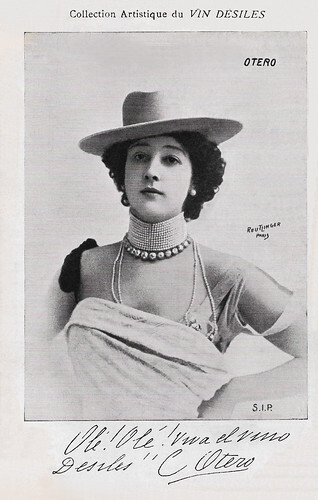
French postcard by S.I.P. in the Collection Artistique du Vin Désiles. Photo: Reutlinger. Caption: Olé! Olé! Viva el Vino Desiles.
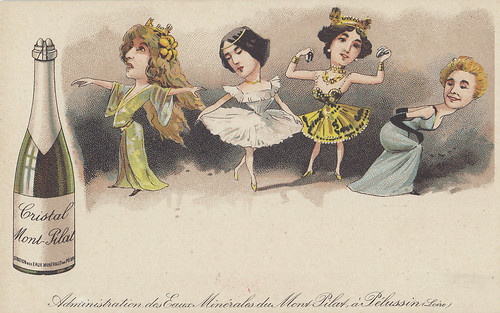
French advertising postcard for Cristal Mont-Pilat (mineral water, alas, not champagne) with caricatures of Sarah Bernhardt , Cléo de Mérode, Carolina 'la belle' Otéro, and Yvette Guilbert . The black gloves were usually a part of Guilbert’s costume. Collection: Marlene Pilaete.
A provocative and fatal woman
Carolina Otéro was born Agustina del Carmen Otéro Iglesias in 1868 into a poor family of modest social status in Valga, in the province of Pontevedra in Galicia. She moved with her family to Santiago de Compostela while still a child, where she began working as a maid.
She suffered - as she later revealed - a rape at the age of 10 that made her sterile, and at the age of 14, she left home with her boyfriend and dance partner, Paco, to work as a singer and dancer in Lisbon. She made her debut in cabaret in 1888 in Barcelona, moving soon after to France, first to Marseille, and then to Paris.
There she became a star of the Folies Bergère. Within a few years, she became one of the most famous women on the entire continent, the sought-after mistress of many powerful and prominent men of the time, such as Prince Albert I of Monaco, King Edward VII of the United Kingdom, the royals of Serbia and Spain, the Grand Dukes of Russia, Peter and Nicholas Nikolaevič, and the famous writer Gabriele D'Annunzio.
In 1890, Otéro was the star of a triumphant tour of the United States, and by the time she returned to Paris two years later, she was the undisputed star of the French stage. She performed in sumptuous gowns and jewellery that enhanced her form to support her reputation as a provocative and fatal woman.
One of her most famous stage costumes involved glueing precious gems onto her breasts, and it was also said that the domes of the Hotel Carlton in Cannes, built in 1912, were modelled on the shape of her breasts.
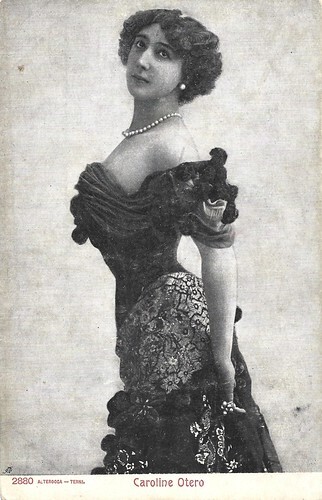
Italian postcard by Alterocca, Terni, no. 2880.
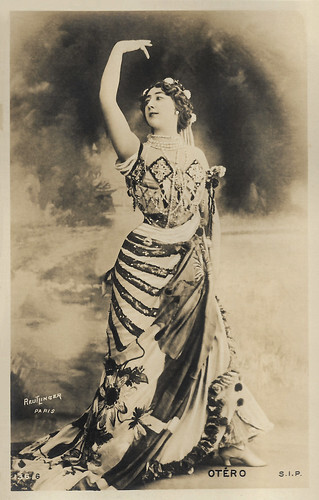
French postcard by S.I.P., no. 136/6. Photo: Reutlinger, Paris.
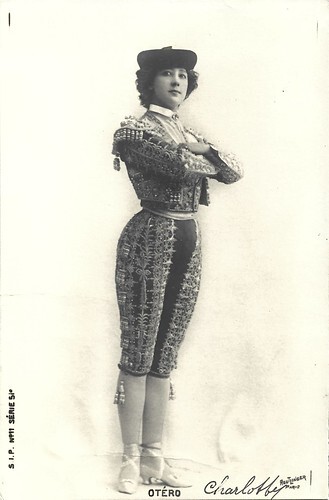
French postcard by S.I.P., no. 11, series 5. Photo: Reutlinger, Paris.

French postcard by S.I.P., no. 828. Photo: Reutlinger, Paris.
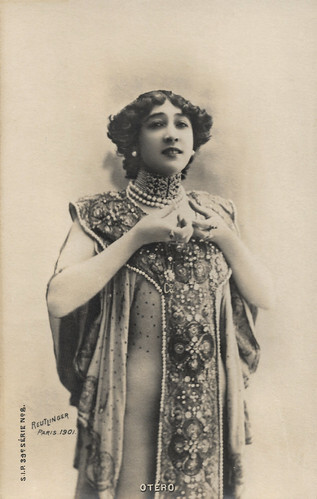
French postcard by S.I.P., no. 8, series 39. Photo: Reutlinger, Paris.
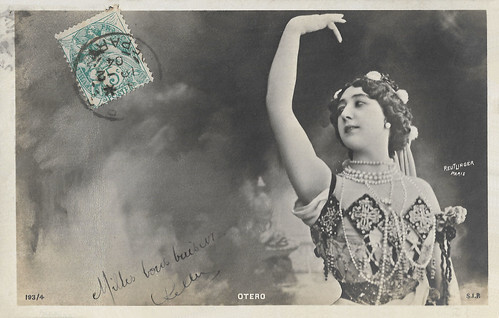
French postcard by S.I.P., no. 193/4. Photo: Reutlinger, Paris.
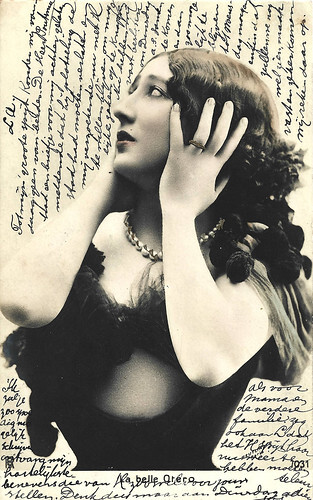
French postcard, no. 1031. Photo: Reutlinger, Paris. The postcard was mailed in 1905, with a message written in Dutch. In these early years of the postcard, one was only allowed to write on the front side of the card. The text addresses the excuses of a person who was unable to attend a private meeting due to an urgent business meeting.
A film scandal in St. Petersburg
In August 1898, in St. Petersburg, the French cinematographer Félix Mesguich, who worked for the Lumière Brothers' company, filmed a one-minute clip showing a dance number by La belle Otéro to the tune of the 'Valse Brillante'.
This made Caroline Otéro probably 'the first star in the history of cinema'. An officer of the tsarist army also appeared in the film, and when it was shown at the Music Hall Aquarium, the scandal was such that Mesguich was expelled from Russia.
She became close friends with the writer Colette and the famous Belle Époque dancer Liane de Pougy, with whom she developed a rivalry. In the 1900s, countless postcards with her circulated.
After the First World War ended, Otéro retired from the stage and bought a property with a sumptuous home for the equivalent of about $15 million. The actress had amassed a considerable fortune over the years, which amounted to around 25 million dollars, but she used it up over the years to support a sophisticated and expensive lifestyle.
She died in extreme poverty, supported by a pension from Monaco's Société des Bains de Mer in Nice, France, in 1965 at the age of 96. Caroline Otéro is depicted in the Monte Carlo Casino, in a painting in the White Room. In 1954, the Mexican actress María Félix played her in Richard Pottier's film La Belle Otero.
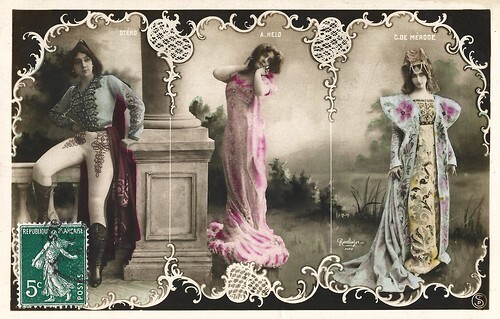
French postcard by S.I.P. Photo: Reutlinger, Paris. Caption: Otéro, A. Held (Anna Held), C. de Mérode (Cléo de Mérode).
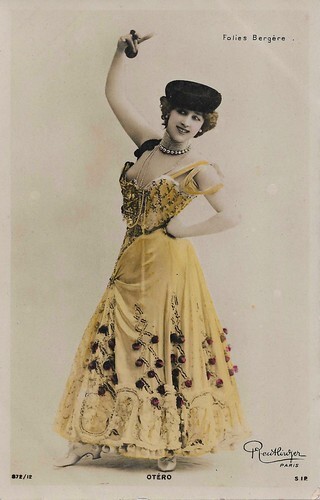
French postcard by S.I.P., no. 872/12. Photo: Reutlinger, Paris. Caption: Folies Bergère.
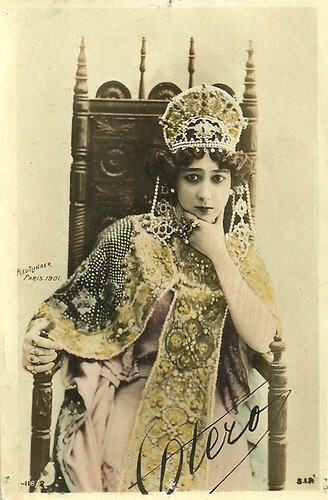
French postcard by S.I.P., no. 118/2. Photo: Reutlinger, Paris. Otero in 'L'Impératrice', a ballet by Jean Richepin and Paul Vidal, performed at the Théâtre Olympia in Paris in 1901.
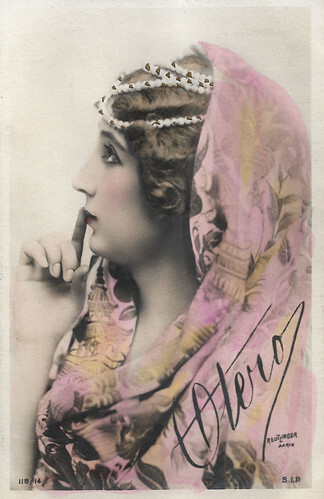
French postcard by S.I.P., no. 118/14. Photo: Reutlinger, Paris.
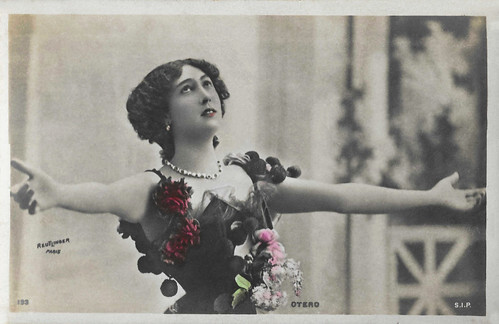
French postcard by S.I.P., no. 193. Photo: Reutlinger, Paris.
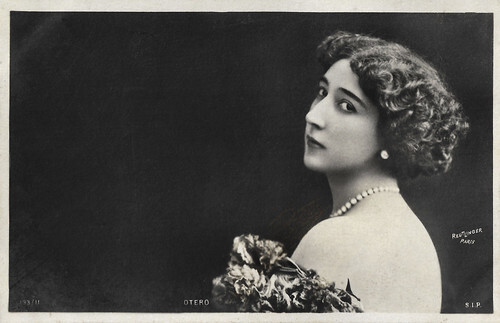
French postcard by S.I.P., no. 193/11. Photo: Reutlinger, Paris.
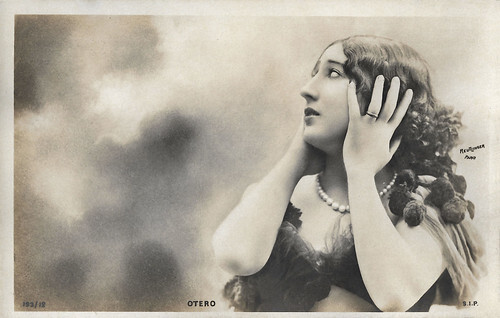
French postcard by S.I.P., no. 193/12. Photo: Reutlinger, Paris.
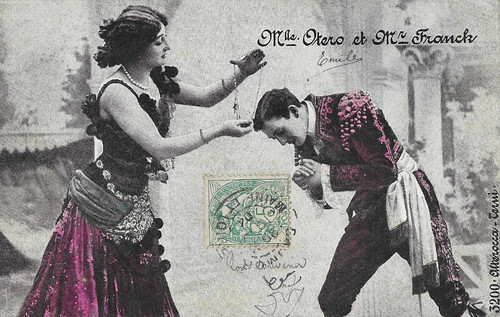
French postcard by Alterocca, Terni, no. 3200. Carolina Otéro and Paul Franck in 'Une fête à Séville' (1900). Sent by mail in 1904.
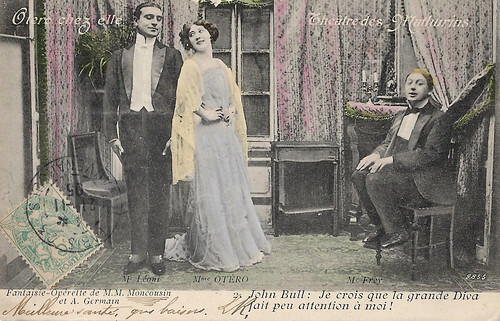
French postcard, no. 9855. Caroline Otero, Léoni and Fernand Frey in the 'fantaisie-opérette' 'Otero chez elle' (1904), by Paul Moncousin and Pierre German and composed by Justin Clérice. It was first performed on 10 October 1904 at the Théâtre des Mathurins in Paris. Caption: 2. John Bull (Frey): I think the great Diva is paying little attention to me. Postcard mailed in 1905.
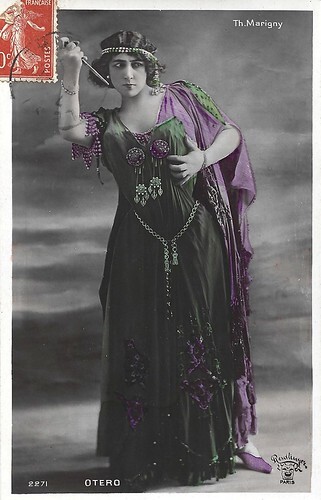
French postcard, no. 2271. Photo: Reutlinger, Paris. This is probably Otero as Giska in the ballet 'Giska la bohémienne' by Edmond Le Roy, with music by Léo Pouget. It was first performed on 2 September 1907 at the Théâtre Marigny (Paris).
Sources: Wikipedia (English and Italian) and .

French postcard, Série 107. Photo: Reutlinger, Paris.

French postcard, Série 107. Photo: Reutlinger, Paris. Caption: La belle Otero.

French postcard, Série 107. Photo: Reutlinger, Paris.

French postcard by S.I.P., no. 193/13. Photo: Reutlinger, Paris.

Italian postcard by Moneglia, Stab. Civicchioni, no. 404. Sent by mail in 1906.

French postcard by S.I.P., no. 118/9. Photo: Reutlinger, Paris. Carolina Otero in 'L'Impératrice', a ballet by Jean Richepin and Paul Vidal, performed at the Théâtre Olympia in Paris in 1901.

French postcard by S.I.P. in the Collection Artistique du Vin Désiles. Photo: Reutlinger. Caption: Olé! Olé! Viva el Vino Desiles.

French advertising postcard for Cristal Mont-Pilat (mineral water, alas, not champagne) with caricatures of Sarah Bernhardt , Cléo de Mérode, Carolina 'la belle' Otéro, and Yvette Guilbert . The black gloves were usually a part of Guilbert’s costume. Collection: Marlene Pilaete.
A provocative and fatal woman
Carolina Otéro was born Agustina del Carmen Otéro Iglesias in 1868 into a poor family of modest social status in Valga, in the province of Pontevedra in Galicia. She moved with her family to Santiago de Compostela while still a child, where she began working as a maid.
She suffered - as she later revealed - a rape at the age of 10 that made her sterile, and at the age of 14, she left home with her boyfriend and dance partner, Paco, to work as a singer and dancer in Lisbon. She made her debut in cabaret in 1888 in Barcelona, moving soon after to France, first to Marseille, and then to Paris.
There she became a star of the Folies Bergère. Within a few years, she became one of the most famous women on the entire continent, the sought-after mistress of many powerful and prominent men of the time, such as Prince Albert I of Monaco, King Edward VII of the United Kingdom, the royals of Serbia and Spain, the Grand Dukes of Russia, Peter and Nicholas Nikolaevič, and the famous writer Gabriele D'Annunzio.
In 1890, Otéro was the star of a triumphant tour of the United States, and by the time she returned to Paris two years later, she was the undisputed star of the French stage. She performed in sumptuous gowns and jewellery that enhanced her form to support her reputation as a provocative and fatal woman.
One of her most famous stage costumes involved glueing precious gems onto her breasts, and it was also said that the domes of the Hotel Carlton in Cannes, built in 1912, were modelled on the shape of her breasts.

Italian postcard by Alterocca, Terni, no. 2880.

French postcard by S.I.P., no. 136/6. Photo: Reutlinger, Paris.

French postcard by S.I.P., no. 11, series 5. Photo: Reutlinger, Paris.

French postcard by S.I.P., no. 828. Photo: Reutlinger, Paris.

French postcard by S.I.P., no. 8, series 39. Photo: Reutlinger, Paris.

French postcard by S.I.P., no. 193/4. Photo: Reutlinger, Paris.

French postcard, no. 1031. Photo: Reutlinger, Paris. The postcard was mailed in 1905, with a message written in Dutch. In these early years of the postcard, one was only allowed to write on the front side of the card. The text addresses the excuses of a person who was unable to attend a private meeting due to an urgent business meeting.
A film scandal in St. Petersburg
In August 1898, in St. Petersburg, the French cinematographer Félix Mesguich, who worked for the Lumière Brothers' company, filmed a one-minute clip showing a dance number by La belle Otéro to the tune of the 'Valse Brillante'.
This made Caroline Otéro probably 'the first star in the history of cinema'. An officer of the tsarist army also appeared in the film, and when it was shown at the Music Hall Aquarium, the scandal was such that Mesguich was expelled from Russia.
She became close friends with the writer Colette and the famous Belle Époque dancer Liane de Pougy, with whom she developed a rivalry. In the 1900s, countless postcards with her circulated.
After the First World War ended, Otéro retired from the stage and bought a property with a sumptuous home for the equivalent of about $15 million. The actress had amassed a considerable fortune over the years, which amounted to around 25 million dollars, but she used it up over the years to support a sophisticated and expensive lifestyle.
She died in extreme poverty, supported by a pension from Monaco's Société des Bains de Mer in Nice, France, in 1965 at the age of 96. Caroline Otéro is depicted in the Monte Carlo Casino, in a painting in the White Room. In 1954, the Mexican actress María Félix played her in Richard Pottier's film La Belle Otero.

French postcard by S.I.P. Photo: Reutlinger, Paris. Caption: Otéro, A. Held (Anna Held), C. de Mérode (Cléo de Mérode).

French postcard by S.I.P., no. 872/12. Photo: Reutlinger, Paris. Caption: Folies Bergère.

French postcard by S.I.P., no. 118/2. Photo: Reutlinger, Paris. Otero in 'L'Impératrice', a ballet by Jean Richepin and Paul Vidal, performed at the Théâtre Olympia in Paris in 1901.

French postcard by S.I.P., no. 118/14. Photo: Reutlinger, Paris.

French postcard by S.I.P., no. 193. Photo: Reutlinger, Paris.

French postcard by S.I.P., no. 193/11. Photo: Reutlinger, Paris.

French postcard by S.I.P., no. 193/12. Photo: Reutlinger, Paris.

French postcard by Alterocca, Terni, no. 3200. Carolina Otéro and Paul Franck in 'Une fête à Séville' (1900). Sent by mail in 1904.

French postcard, no. 9855. Caroline Otero, Léoni and Fernand Frey in the 'fantaisie-opérette' 'Otero chez elle' (1904), by Paul Moncousin and Pierre German and composed by Justin Clérice. It was first performed on 10 October 1904 at the Théâtre des Mathurins in Paris. Caption: 2. John Bull (Frey): I think the great Diva is paying little attention to me. Postcard mailed in 1905.

French postcard, no. 2271. Photo: Reutlinger, Paris. This is probably Otero as Giska in the ballet 'Giska la bohémienne' by Edmond Le Roy, with music by Léo Pouget. It was first performed on 2 September 1907 at the Théâtre Marigny (Paris).
Sources: Wikipedia (English and Italian) and .
Published on September 30, 2025 22:00
September 29, 2025
La Collectionneuse: Pauline Starke
Pauline Starke started her long and prolific silent movie career with D.W. Griffith. Later, she worked with other noted directors such as Frank Borzage, Maurice Tourneur, Allan Dwan, Raoul Walsh, John Ford, Ernst Lubitsch, Victor Fleming or Edmund Goulding. Like many other silent stars, Starke, who was said to have a certain likeness to Gloria Swanson, didn’t succeed in making the transition to sound films and, in 1935, she appeared in her last movie at a Poverty Row studio.
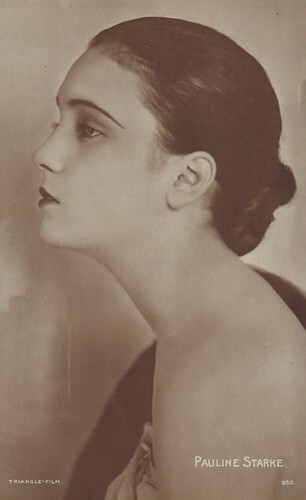
Swedish postcard by Nordisk Konst, Stockholm, no. 890. Photo: Triangle-Film.
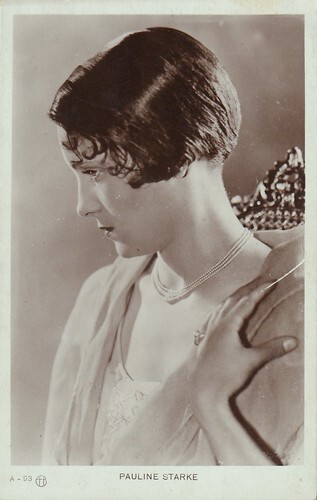
Spanish postcard by Editorial Fotografica Barcelona, no. A-93.
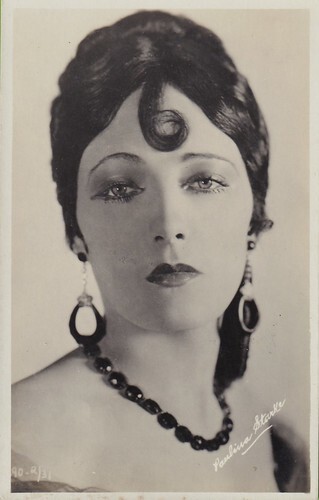
Mexican postcard by Gevaert.
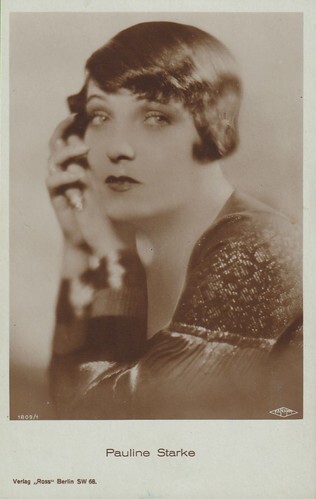
German postcard by Ross Verlag, no. 1809/1, 1927-1928. Photo: Fanamet.
Noticed by D.W. Griffith
Pauline Starke was allegedly born on the 10th of January 1901 in Joplin, U.S.A. However, contemporary sources, such as Stars of the Photoplay or The Picturegoer’s Who’s Who and Encyclopedia, indicate 1900.
According to IMDb , she would have made her movie debut in The Claws of Greed (1914), but the actress never mentioned this short. Furthermore, as there is a child actress in the cast called Ordean Stark, there may have been a mix-up.
According to Pauline Starke herself, she was noticed by director D.W. Griffith, who hired her as an extra in The Birth of a Nation (1915) and later cast her as a harem dancer in Intolerance (1916).
In 1917, Frank Borzage gave her a leading role in Until They Get Me, and she quickly became a promising young star in Triangle Film productions. Borzage directed her again in The Shoes That Danced (1918), Innocent’s Progress (1918) and The Atom (1918).
Her other Triangle films include Alias Mary Brown (1918), for which she was advertised as "The Little Girl With the Big Personality", Daughter Angele (1918) and Irish Eyes (1918).
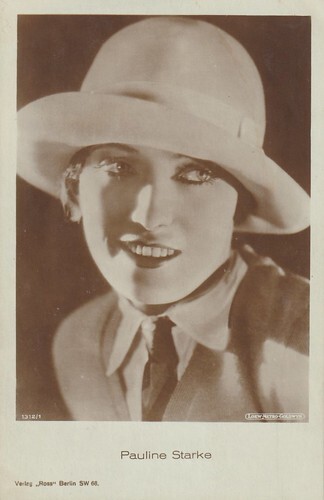
German postcard by Ross Verlag, no. 1312/1, 1927-1928. Photo: Loew Metro-Goldwyn.
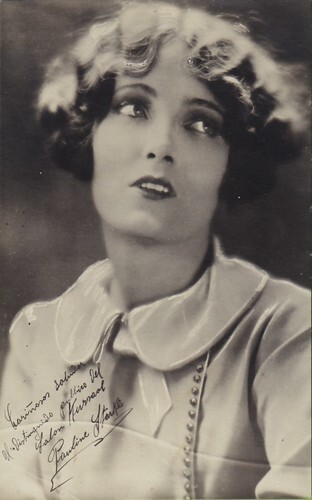
Spanish postcard in the Kursaal series.
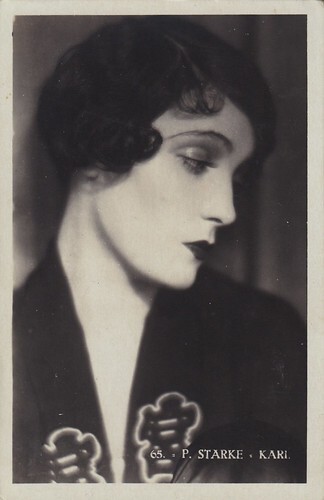
Italian postcard, no. 65.
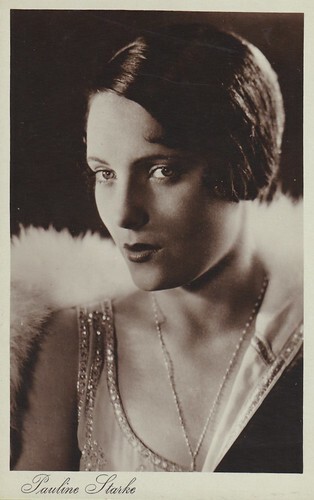
Italian postcard.
Freelance actress and unusual Wampas Baby Star
Pauline Starke then freelanced and appeared in a last Borzage movie, Whom the Gods Would Destroy (Frank Borzage, 1919), which was inspired by President Woodrow Wilson’s will to establish a League of Nations and was produced by the Macauley Photoplays, Inc.
She was also directed by Maurice Tourneur in The Life Line (1919) and The Broken Butterfly (1919) and by Allan Dwan in Soldiers of Fortune (1919).
Films such as The Courage of Mary O’Doone (1920), A Connecticut Yankee in King Arthur’s Court (1921), Snowblind (1921), Salvation Nell (1921), The Forgotten Woman (1921), The Flower of the North (1921), The Kingdom Within (1922), Lost and Found on a South Sea Island (1923), Hearts of Oak (1924), The Devil’s Cargo (1925), As No Man Has Loved (1925), … followed.
In 1922, the creation year of the Wampas Baby Stars, she was among the thirteen singled-out actresses who were predicted a bright future in films. This may seem curious, as she was already a veteran in the movie world and had a long string of leading roles behind her, as was Bessie Love , who was also nominated that same year.
Maybe, as it was their first year of existence, the Wampas committee wanted to play it safe by including in their selection several established and seasoned performers.
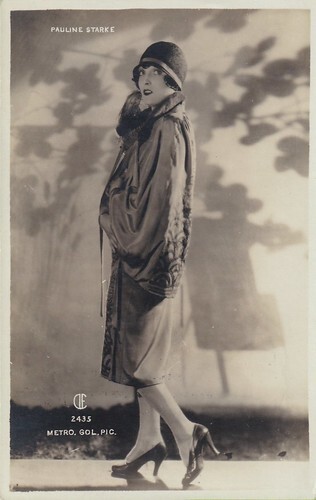
Mexican postcard by CIF, no. 2435. Photo: Metro Goldwyn.
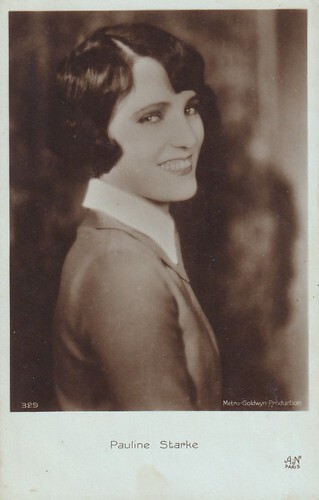
French postcard by A.N., Paris, no. 329. Photo: Metro Goldwyn.
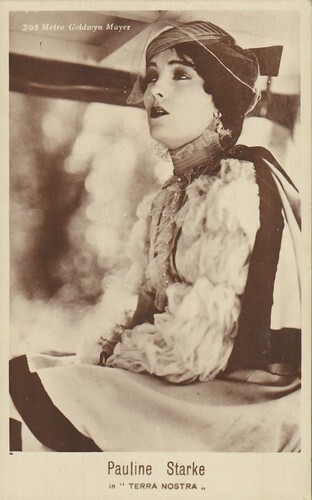
Italian postcard by G.B. Falci, no. 308. Pauline Starke in War Paint (W.S. Van Dyke, 1926).
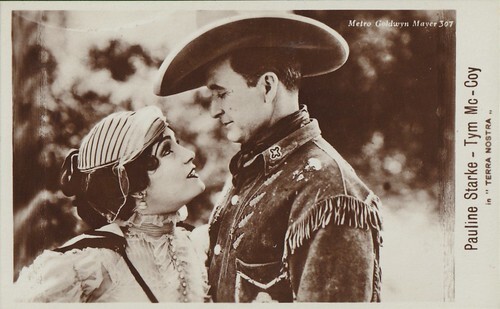
Italian postcard by G.B. Falci-Editore, Milano, no. 307. Pauline Starke and Tim McCoy in War Paint (W.S. Van Dyke, 1926). Photo: Metro Goldwyn Mayer.
Under contract to M.G.M.
In the second half of the 1920s, Pauline Starke was under contract to M.G.M, which gave her a more sophisticated and glamourous movie image and featured her in, among others, Sun-Up (1925), Bright Lights (1925), Love’s Blindness (1926), Women Love Diamonds (1927), in a role turned down by Greta Garbo , and Captain Salvation (1927).
In 1928, she starred in The Viking, which was the first feature made in Technicolour’s dye-transfer process. It was produced by the Technicolour Corporation and distributed by M.G.M. The Viking was released with a synchronised musical score with sound effects, as was also the case for her next film, Man, Woman and Wife (1929) at Universal.
She had no great luck in talkies. She made her talkie debut in Columbia’s A Royal Romance (1930) and Universal’s What Men Want (1930). In February 1932, she appeared on Broadway in 'Zombie', which closed after only 21 performances. Variety magazine called it a "wretchedly acted play".
In November 1932, the Conciliation Committee of the Academy of Motion Picture Arts and Sciences ordered director James Cruze to pay $6,050 in back salary to Pauline Starke. She had claimed that, after a few days of filming on the set of The Great Gabbo (1929), he had unceremoniously replaced her with his then-wife, Betty Compson .
She had her last starring role at Poverty Row’s Monarch Film Corporation in Twenty Dollars a Week (1935). In 1948, she was found unconscious from an overdose of sleeping pills. Her husband declared that she had been in the habit of taking sedatives for more than ten years. Pauline Starke died from the aftermath of a stroke on the 3rd of February 1977.

Italian postcard by G.B. Falci-Editore, Milano, no. 305. Pauline Starke and Tim McCoy in War Paint (W.S. Van Dyke, 1926). Photo: Metro Goldwyn Mayer.
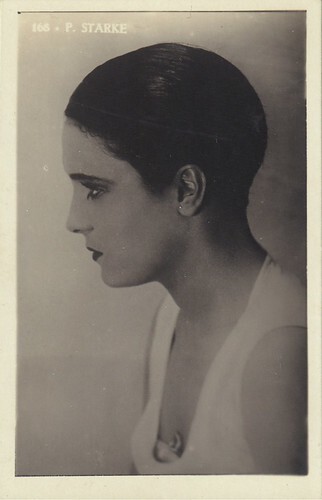
Italian postcard, no. 168.

Italian postcard by G.B. Falci, no. 344. Pauline Starke in Love’s Blindness (John Francis Dillon, 1926).
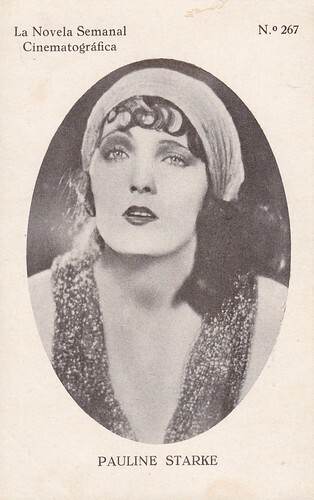
Spanish postcard by La Novela Semanal Cinematografica, no. 267.
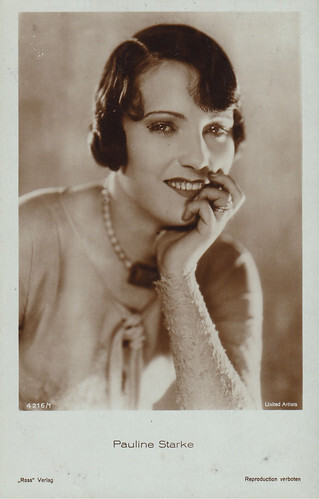
German postcard by Ross Verlag, no. 4216/1, 1929-1930. Photo: United Artists.
Text and postcards: Marlene Pilaete.

Swedish postcard by Nordisk Konst, Stockholm, no. 890. Photo: Triangle-Film.

Spanish postcard by Editorial Fotografica Barcelona, no. A-93.

Mexican postcard by Gevaert.

German postcard by Ross Verlag, no. 1809/1, 1927-1928. Photo: Fanamet.
Noticed by D.W. Griffith
Pauline Starke was allegedly born on the 10th of January 1901 in Joplin, U.S.A. However, contemporary sources, such as Stars of the Photoplay or The Picturegoer’s Who’s Who and Encyclopedia, indicate 1900.
According to IMDb , she would have made her movie debut in The Claws of Greed (1914), but the actress never mentioned this short. Furthermore, as there is a child actress in the cast called Ordean Stark, there may have been a mix-up.
According to Pauline Starke herself, she was noticed by director D.W. Griffith, who hired her as an extra in The Birth of a Nation (1915) and later cast her as a harem dancer in Intolerance (1916).
In 1917, Frank Borzage gave her a leading role in Until They Get Me, and she quickly became a promising young star in Triangle Film productions. Borzage directed her again in The Shoes That Danced (1918), Innocent’s Progress (1918) and The Atom (1918).
Her other Triangle films include Alias Mary Brown (1918), for which she was advertised as "The Little Girl With the Big Personality", Daughter Angele (1918) and Irish Eyes (1918).

German postcard by Ross Verlag, no. 1312/1, 1927-1928. Photo: Loew Metro-Goldwyn.

Spanish postcard in the Kursaal series.

Italian postcard, no. 65.

Italian postcard.
Freelance actress and unusual Wampas Baby Star
Pauline Starke then freelanced and appeared in a last Borzage movie, Whom the Gods Would Destroy (Frank Borzage, 1919), which was inspired by President Woodrow Wilson’s will to establish a League of Nations and was produced by the Macauley Photoplays, Inc.
She was also directed by Maurice Tourneur in The Life Line (1919) and The Broken Butterfly (1919) and by Allan Dwan in Soldiers of Fortune (1919).
Films such as The Courage of Mary O’Doone (1920), A Connecticut Yankee in King Arthur’s Court (1921), Snowblind (1921), Salvation Nell (1921), The Forgotten Woman (1921), The Flower of the North (1921), The Kingdom Within (1922), Lost and Found on a South Sea Island (1923), Hearts of Oak (1924), The Devil’s Cargo (1925), As No Man Has Loved (1925), … followed.
In 1922, the creation year of the Wampas Baby Stars, she was among the thirteen singled-out actresses who were predicted a bright future in films. This may seem curious, as she was already a veteran in the movie world and had a long string of leading roles behind her, as was Bessie Love , who was also nominated that same year.
Maybe, as it was their first year of existence, the Wampas committee wanted to play it safe by including in their selection several established and seasoned performers.

Mexican postcard by CIF, no. 2435. Photo: Metro Goldwyn.

French postcard by A.N., Paris, no. 329. Photo: Metro Goldwyn.

Italian postcard by G.B. Falci, no. 308. Pauline Starke in War Paint (W.S. Van Dyke, 1926).

Italian postcard by G.B. Falci-Editore, Milano, no. 307. Pauline Starke and Tim McCoy in War Paint (W.S. Van Dyke, 1926). Photo: Metro Goldwyn Mayer.
Under contract to M.G.M.
In the second half of the 1920s, Pauline Starke was under contract to M.G.M, which gave her a more sophisticated and glamourous movie image and featured her in, among others, Sun-Up (1925), Bright Lights (1925), Love’s Blindness (1926), Women Love Diamonds (1927), in a role turned down by Greta Garbo , and Captain Salvation (1927).
In 1928, she starred in The Viking, which was the first feature made in Technicolour’s dye-transfer process. It was produced by the Technicolour Corporation and distributed by M.G.M. The Viking was released with a synchronised musical score with sound effects, as was also the case for her next film, Man, Woman and Wife (1929) at Universal.
She had no great luck in talkies. She made her talkie debut in Columbia’s A Royal Romance (1930) and Universal’s What Men Want (1930). In February 1932, she appeared on Broadway in 'Zombie', which closed after only 21 performances. Variety magazine called it a "wretchedly acted play".
In November 1932, the Conciliation Committee of the Academy of Motion Picture Arts and Sciences ordered director James Cruze to pay $6,050 in back salary to Pauline Starke. She had claimed that, after a few days of filming on the set of The Great Gabbo (1929), he had unceremoniously replaced her with his then-wife, Betty Compson .
She had her last starring role at Poverty Row’s Monarch Film Corporation in Twenty Dollars a Week (1935). In 1948, she was found unconscious from an overdose of sleeping pills. Her husband declared that she had been in the habit of taking sedatives for more than ten years. Pauline Starke died from the aftermath of a stroke on the 3rd of February 1977.

Italian postcard by G.B. Falci-Editore, Milano, no. 305. Pauline Starke and Tim McCoy in War Paint (W.S. Van Dyke, 1926). Photo: Metro Goldwyn Mayer.

Italian postcard, no. 168.

Italian postcard by G.B. Falci, no. 344. Pauline Starke in Love’s Blindness (John Francis Dillon, 1926).

Spanish postcard by La Novela Semanal Cinematografica, no. 267.

German postcard by Ross Verlag, no. 4216/1, 1929-1930. Photo: United Artists.
Text and postcards: Marlene Pilaete.
Published on September 29, 2025 22:00
September 28, 2025
Miles Davis
American jazz trumpeter Miles Davis (1926-1991) was one of the most important and influential jazz musicians in history. Davis played various styles, including bop, cool jazz, modal jazz and jazz-rock fusion. His style is recognisable and original and continues to influence jazz musicians decades after his death. His music for Louis Malle's Nouvelle Vague classic Ascenseur pour l'échafaud / Elevator to the Gallows (1957) is one of the greatest Jazz soundtracks in cinema history.
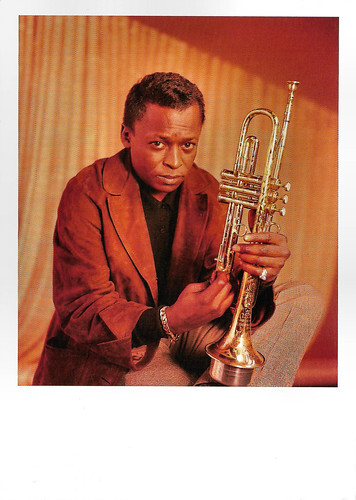
German postcard by Benedikt Taschen Verlag G.m.b.H., Köln, 1997. Photo: William Claxton. Caption: Miles Davis, Hollywood, 1957, from the book 'William Claxton's Jazz Photography'.
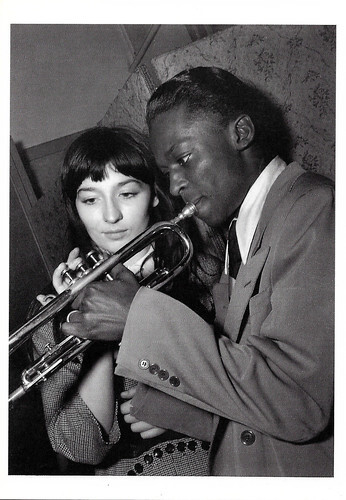
French postcard by Éditions Hazan, Paris, 1995. Photo: Jean-Philippe Charbonnier / Agence TOP. Caption: Juliette Greco and Miles Davis, Halle Pleyel, May 1949.
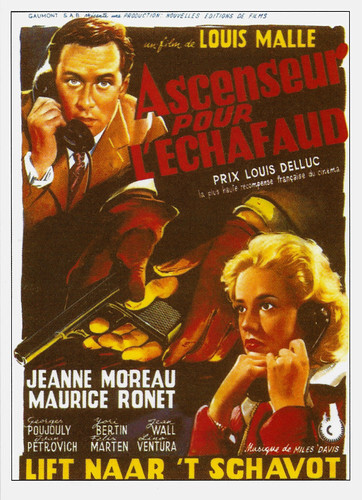
French poster postcard by Encyclopédie du Cinéma, no.EDC 284, VIS 1. Belgian poster for Ascenseur pour l'échafaud / Elevator to the Gallows (Louis Malle, 1957) with music by Miles Davis.
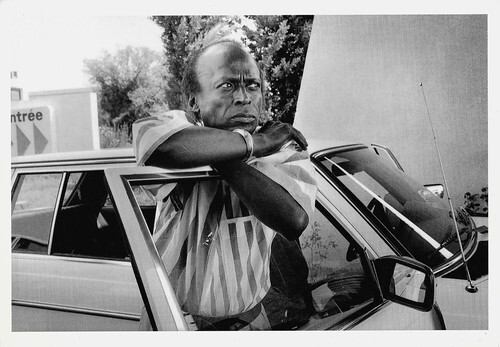
French postcard in the Collection Magie Noire by Editions Hazan, Paris, 1993, no. 6350. Photo: Guy Le Querrec / Magnum. Caption: Miles Davis, Jazz Festival de Nîmes, 20 July 1984.
Kicking his heroin addiction
Miles Dewey Davis III was born in Alton, Illinois, in 1926. Davis was the son of a dental surgeon, Dr. Miles Dewey Davis, Jr., and a music teacher, Cleota Mae (Henry) Davis. He grew up in the black middle class of East St. Louis after the family moved there shortly after his birth. His mother wanted him to learn to play the violin. Instead, his father gave him a trumpet for his thirteenth birthday, which he devoted himself to from then on. The family owned a ranch, where young Miles learned to ride horses.
When Davis was 15, he played for audiences with bandleader Eddie Randall and studied under trumpeter Elwood Buchanan. Against the fashion of the time, Buchanan emphasised the importance of playing without vibrato. Davis retained this distinctive, clear tone throughout his career. William Ruhlmann at AllMusic : "At 17, he joined Eddie Randle's Blue Devils, a territory band based in St. Louis. He enjoyed a personal apotheosis in 1944, just after graduating from high school, when he saw and was allowed to sit in with Billy Eckstine's big band, which was playing in St. Louis. The band featured trumpeter Dizzy Gillespie and saxophonist Charlie Parker, the architects of the emerging bebop style of jazz, which was characterised by fast, inventive soloing and dynamic rhythm variations."
In 1945, Davis moved to New York, ostensibly to study at the Institute of Musical Art in New York City (renamed Juilliard) on a scholarship. In reality, he neglected his education and went in search of his heroes, such as Thelonious Monk and Coleman Hawkins. He regularly went out with Dizzy Gillespie, and they became good friends. By 1949, he had fulfilled his 'probation' as a fellow player, both on stage and on recordings. His own recording career subsequently flourished. That same year, Davis began collaborating with Gil Evans. This collaboration continued over the next 20 years for many of his major works. The records they made in the late 1940s were released on a limited basis for the first decade.
Through New York's jazz clubs, Davis regularly came into contact with both users and sellers of illegal drugs. By 1950, he had a serious heroin addiction, possibly exacerbated by the lacklustre reception of his first personal recordings. In the first part of the 1950s, the talent Davis possessed seemed to be lost. He played several gigs, but these were uninspired. Aware of this, Davis returned to East Saint Louis in 1954, where he tried to kick the habit with the help of his father. The latter mistakenly thought it had to do with his teeth. Davis closed himself off from society until he was free of his drug addiction.
By 1954, he had overcome his heroin addiction, although he continued to use cocaine, among other things. Reborn, he returned to New York and founded the first major version of the Miles Davis Quintet. This band included the young John Coltrane and occasionally some other jazz artists known at the time, such as Sonny Rollins and Charles Mingus. Musically, the group continued where Davis left off in his sessions in the late 1940s. They avoided the rhythmic and harmonic complexity of the dominant bebop, and Davis was given the space to play long, legato and essentially melodic lines, in which he learned to make sense of modal music. This was a lifelong obsession for him.
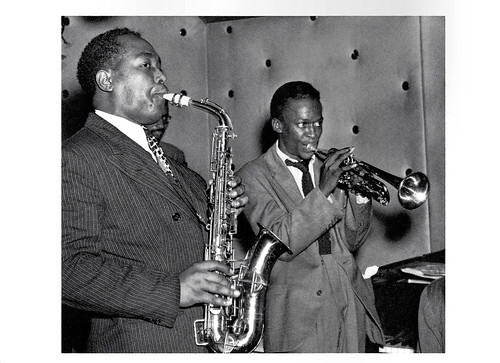
American postcard by Fotofolio, NY, NY, no. M 133. Photo: William P. Gottlieb. Charlie Parker and Miles Davis, 1948.
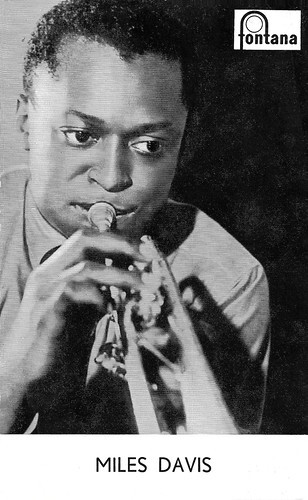
Vintage promotion card by Fontana, no. GF 06421.

German postcard by Edition Tushita, no. B 985. Photo: Artwork Media GmbH.
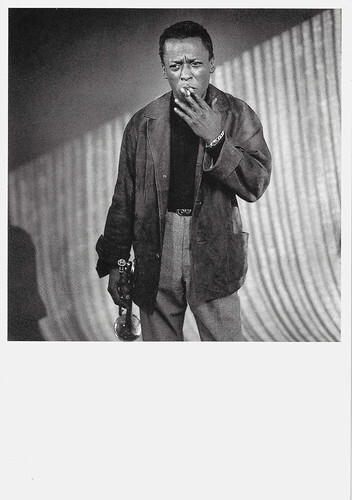
French postcard by Editions du Désastre, Paris, no. WC 4, 1989. Photo: William Claxton. Caption: Miles Davis, Los Angeles, 1956.
The birth of cool jazz
In February 1957, Capitol finally issued the 1949 recordings, together on an LP called 'Birth of the Cool'. He also recorded 'Relaxin' with the Miles Davis Quintet'. These albums defined the sound of cool jazz, one of the dominant trends in music for the next decade and beyond. In December 1957, Miles Davis returned to Paris, where he improvised the background music for the film Ascenseur pour l'échafaud / Elevator to the Gallows (Louis Malle, 1957) with Jeanne Moreau and Maurice Ronet .
Davis recorded the music in a single recording session while he watched a screening. He composed it while watching a rough cut and then invited a quartet of French and US musicians in from 11 pm to 5 am one night, improvising each number and allegedly sipping champagne with Jeanne Moreau and Louis Malle. Claudio Carvalho at IMDb : "The soundtrack with the music of Miles Davis gives a touch of class to this little masterpiece. The result is one of the best thrillers entwined with comedy of errors that I have ever seen."
While the rest of the music establishment was still trying to accept Miles Davis' innovations, he himself was further along. Reunited with Gil Evans, he recorded a series of albums of great variety and complexity, demonstrating his mastery of his instrument in almost every musical context. On the first album, 'Miles Ahead' (1957), he played with a traditional jazz big band. This had a driven brass section arranged by Gil Evans. In addition to jazz numbers (including Dave Brubeck's 'The Duke'), the two took on Léo Delibes' 'Les Filles de Cadix'. This was the first time Davis recorded European classical music.
'Milestones' (1958) captured the sound of his current sextet, which now consisted of Davis, John Coltrane, Julian "Cannonball" Adderley (alto sax), Red Garland (piano), Paul Chambers (bass) and Philly Joe Jones (drums). Musically, this album encompassed both the past and future of jazz. Davis showed he could play blues and bebop (accompanied by Garland), but the centrepiece is the title track, a composition by Davis around the Dorian and Aeolian modes and with the free improvisational modal style Davis made his own.
This modal style flourished on 'Kind of Blue' (1959), an album that became a landmark in modern jazz and the most popular album of Davis' career. It eventually sold over two million copies, a phenomenal success for a jazz record. The sextet improvised on short modal themes that had not been rehearsed beforehand. In the group, Bill Evans took over the piano, bringing classical influences to the group. On one of the tracks, Wynton Kelly played piano. He later became a permanent member of the group. After 'Kind of Blue', the group broke up. Coltrane, Evans and Adderley continued as bandleaders. Miles Davis found less inspiration, and his group changed line-ups regularly.
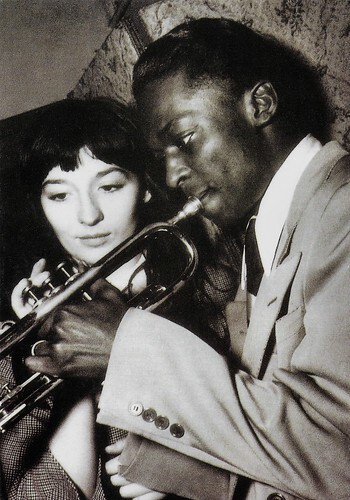
German postcard by Edition Tushita, Duisburg Innenhafen, no. B 511. Photo: Jean-Philippe Charbonnier / ADN, Berlin / Tushita. Caption: Miles Davis & Juliette Greco , Paris Jazz Club.

German postcard by Edition Tushita, no. B 1147. Caption: Some Day My Prince Will Come. Miles Davis "the 60ies".
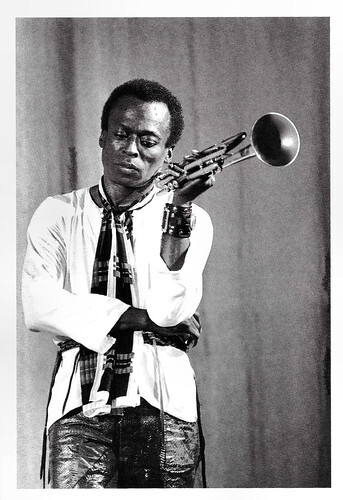
French postcard by Editions Hazan, Paris, 1991, no. 6295. Photo: Guy Le Querrec / Magnum. Caption: Miles Davis, 1969.
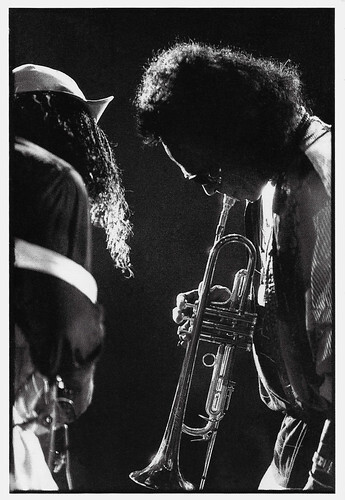
Swiss postcard by News Productions, Baulmes, no. 56221. Photo: Edouard Curchod.
A landmark for emerging jazz fusion music
In 1964, Miles Davis formed his second major quintet. Herbie Hancock on piano, Wayne Shorter on saxophone, Ron Carter on bass and the still young Tony Williams on drums. Davis stated, "You have to know the rules first to then be able to break them." Jazz standards were played live, pushing the boundaries of tradition. Long improvisations with much emphasis on harmonic boundaries and tight group playing allowed him to play with texture more than before.
Live, he played standards and in the studio new work, especially compositions by his saxophonist Wayne Shorter. The limits were reached on 'Live at Plugged Nickel'. It formed a counterpoint to the free jazz of Ornette Coleman, whom Davis reviled in his autobiography. In June 1970, Miles Davis, Chick Corea, Keith Jarrett, Dave Holland, Jack DeJohnette and John McLaughlin, among others, met for four nights at the modest nightclub The Cellar Door in Washington, D.C. A six-song CD of those performances was released in 2006.
In the late 1960s, Davis went electric with an electric piano, electric bass and an electric guitar. The 'groove' became important. After Davis heard 'Machine Gun' by Jimi Hendrix at the Isle of Wight Festival, Davis immediately wanted to start a band with him. "It's that goddamned motherfucking 'Machine Gun'," Miles replied when asked what he thought of Hendrix's music. Due to Hendrix's death, it never took place. In the 1970s, he tried to reach black youth by putting funk influences in his music. As heard on the revolutionary album 'On The Corner'. 'Bitches Brew' (1970) became a landmark for emerging jazz fusion music.
In late 1975, Davis withdrew from music and no longer wanted to play the trumpet. He again struggled with addiction, this time to cocaine and alcohol. Poor health, partly caused by years of excessive drug use, led to a radio silence of almost six years. Miles Davis returned to music anyway. His style changed more to a pop style. He recorded new, intriguing albums such as electronic-driven 'Tutu or Amandla', as well as Spanish-flavoured music for the film Siesta (Mary Lambert, 1987) with Ellen Barkin and Gabriel Byrne.
Miles Davis died in Santa Monica, California, in 1991. He was 65. Already in a coma, he died of pneumonia following a severe stroke and was buried next to Duke Ellington at Woodlawn Cemetery in The Bronx, New York. Davis was married to Frances Taylor (1958-1968), Betty Mabry (1968-1969) and actress Cicely Tyson (1981-1988). He had four children: Cheryl (1944), Gregory (1946), Miles IV (1950) and Erin (1970). Twenty-four years after Davis' death, he was the subject of Miles Ahead (2015), a biopic co-written and directed by Don Cheadle, who also portrayed him. Its soundtrack functioned as a career overview with additional music provided by pianist Robert Glasper and associates. In 2020, the trumpeter was also the focus of director Stanley Nelson's documentary Miles Davis: Birth of the Cool, which showcased music from throughout Davis's career.
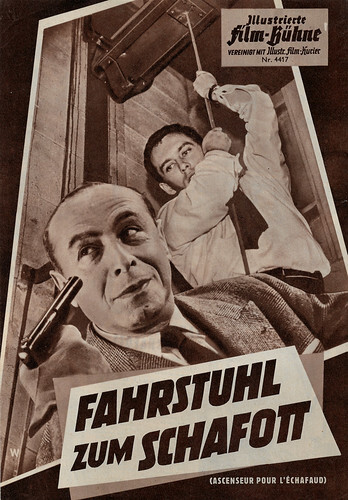
West German flyer by Illustrierte Film-Bühne (merged with Illustrierte Film-Kurier), no. 4417, for Ascenseur pour l'échafaud / Elevator to the Gallows (Louis Malle, 1957) with music by Miles Davis, page 1. Photos: Pallas Film. The German title was Fahrstuhl zum Schafott.

West German flyer by Illustrierte Film-Bühne (merged with Illustrierte Film-Kurier), no. 4417, for Ascenseur pour l'échafaud / Elevator to the Gallows (Louis Malle, 1957) with music by Miles Davis, page 2. Photos: Pallas Film. The German title was Fahrstuhl zum Schafott.

West German flyer by Illustrierte Film-Bühne (merged with Illustrierte Film-Kurier), no. 4417, for Ascenseur pour l'échafaud / Elevator to the Gallows (Louis Malle, 1957) with music by Miles Davis, page 3. Photos: Pallas Film. The German title was Fahrstuhl zum Schafott.
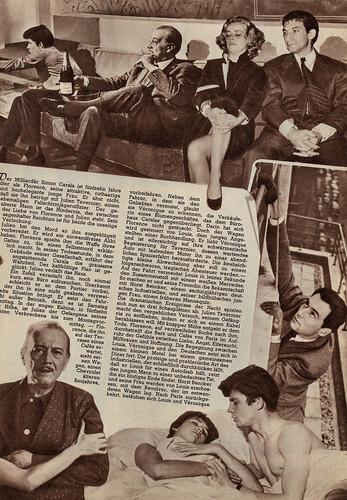
West German flyer by Illustrierte Film-Bühne (merged with Illustrierte Film-Kurier), no. 4417, for Ascenseur pour l'échafaud / Elevator to the Gallows (Louis Malle, 1957) with music by Miles Davis, page 4. Photos: Pallas Film. The German title was Fahrstuhl zum Schafott.
Sources: William Ruhlmann (AllMusic), (IMDb), Claudio Carvalho (IMDb), Wikipedia (Dutch) and .

German postcard by Benedikt Taschen Verlag G.m.b.H., Köln, 1997. Photo: William Claxton. Caption: Miles Davis, Hollywood, 1957, from the book 'William Claxton's Jazz Photography'.

French postcard by Éditions Hazan, Paris, 1995. Photo: Jean-Philippe Charbonnier / Agence TOP. Caption: Juliette Greco and Miles Davis, Halle Pleyel, May 1949.

French poster postcard by Encyclopédie du Cinéma, no.EDC 284, VIS 1. Belgian poster for Ascenseur pour l'échafaud / Elevator to the Gallows (Louis Malle, 1957) with music by Miles Davis.

French postcard in the Collection Magie Noire by Editions Hazan, Paris, 1993, no. 6350. Photo: Guy Le Querrec / Magnum. Caption: Miles Davis, Jazz Festival de Nîmes, 20 July 1984.
Kicking his heroin addiction
Miles Dewey Davis III was born in Alton, Illinois, in 1926. Davis was the son of a dental surgeon, Dr. Miles Dewey Davis, Jr., and a music teacher, Cleota Mae (Henry) Davis. He grew up in the black middle class of East St. Louis after the family moved there shortly after his birth. His mother wanted him to learn to play the violin. Instead, his father gave him a trumpet for his thirteenth birthday, which he devoted himself to from then on. The family owned a ranch, where young Miles learned to ride horses.
When Davis was 15, he played for audiences with bandleader Eddie Randall and studied under trumpeter Elwood Buchanan. Against the fashion of the time, Buchanan emphasised the importance of playing without vibrato. Davis retained this distinctive, clear tone throughout his career. William Ruhlmann at AllMusic : "At 17, he joined Eddie Randle's Blue Devils, a territory band based in St. Louis. He enjoyed a personal apotheosis in 1944, just after graduating from high school, when he saw and was allowed to sit in with Billy Eckstine's big band, which was playing in St. Louis. The band featured trumpeter Dizzy Gillespie and saxophonist Charlie Parker, the architects of the emerging bebop style of jazz, which was characterised by fast, inventive soloing and dynamic rhythm variations."
In 1945, Davis moved to New York, ostensibly to study at the Institute of Musical Art in New York City (renamed Juilliard) on a scholarship. In reality, he neglected his education and went in search of his heroes, such as Thelonious Monk and Coleman Hawkins. He regularly went out with Dizzy Gillespie, and they became good friends. By 1949, he had fulfilled his 'probation' as a fellow player, both on stage and on recordings. His own recording career subsequently flourished. That same year, Davis began collaborating with Gil Evans. This collaboration continued over the next 20 years for many of his major works. The records they made in the late 1940s were released on a limited basis for the first decade.
Through New York's jazz clubs, Davis regularly came into contact with both users and sellers of illegal drugs. By 1950, he had a serious heroin addiction, possibly exacerbated by the lacklustre reception of his first personal recordings. In the first part of the 1950s, the talent Davis possessed seemed to be lost. He played several gigs, but these were uninspired. Aware of this, Davis returned to East Saint Louis in 1954, where he tried to kick the habit with the help of his father. The latter mistakenly thought it had to do with his teeth. Davis closed himself off from society until he was free of his drug addiction.
By 1954, he had overcome his heroin addiction, although he continued to use cocaine, among other things. Reborn, he returned to New York and founded the first major version of the Miles Davis Quintet. This band included the young John Coltrane and occasionally some other jazz artists known at the time, such as Sonny Rollins and Charles Mingus. Musically, the group continued where Davis left off in his sessions in the late 1940s. They avoided the rhythmic and harmonic complexity of the dominant bebop, and Davis was given the space to play long, legato and essentially melodic lines, in which he learned to make sense of modal music. This was a lifelong obsession for him.

American postcard by Fotofolio, NY, NY, no. M 133. Photo: William P. Gottlieb. Charlie Parker and Miles Davis, 1948.

Vintage promotion card by Fontana, no. GF 06421.

German postcard by Edition Tushita, no. B 985. Photo: Artwork Media GmbH.

French postcard by Editions du Désastre, Paris, no. WC 4, 1989. Photo: William Claxton. Caption: Miles Davis, Los Angeles, 1956.
The birth of cool jazz
In February 1957, Capitol finally issued the 1949 recordings, together on an LP called 'Birth of the Cool'. He also recorded 'Relaxin' with the Miles Davis Quintet'. These albums defined the sound of cool jazz, one of the dominant trends in music for the next decade and beyond. In December 1957, Miles Davis returned to Paris, where he improvised the background music for the film Ascenseur pour l'échafaud / Elevator to the Gallows (Louis Malle, 1957) with Jeanne Moreau and Maurice Ronet .
Davis recorded the music in a single recording session while he watched a screening. He composed it while watching a rough cut and then invited a quartet of French and US musicians in from 11 pm to 5 am one night, improvising each number and allegedly sipping champagne with Jeanne Moreau and Louis Malle. Claudio Carvalho at IMDb : "The soundtrack with the music of Miles Davis gives a touch of class to this little masterpiece. The result is one of the best thrillers entwined with comedy of errors that I have ever seen."
While the rest of the music establishment was still trying to accept Miles Davis' innovations, he himself was further along. Reunited with Gil Evans, he recorded a series of albums of great variety and complexity, demonstrating his mastery of his instrument in almost every musical context. On the first album, 'Miles Ahead' (1957), he played with a traditional jazz big band. This had a driven brass section arranged by Gil Evans. In addition to jazz numbers (including Dave Brubeck's 'The Duke'), the two took on Léo Delibes' 'Les Filles de Cadix'. This was the first time Davis recorded European classical music.
'Milestones' (1958) captured the sound of his current sextet, which now consisted of Davis, John Coltrane, Julian "Cannonball" Adderley (alto sax), Red Garland (piano), Paul Chambers (bass) and Philly Joe Jones (drums). Musically, this album encompassed both the past and future of jazz. Davis showed he could play blues and bebop (accompanied by Garland), but the centrepiece is the title track, a composition by Davis around the Dorian and Aeolian modes and with the free improvisational modal style Davis made his own.
This modal style flourished on 'Kind of Blue' (1959), an album that became a landmark in modern jazz and the most popular album of Davis' career. It eventually sold over two million copies, a phenomenal success for a jazz record. The sextet improvised on short modal themes that had not been rehearsed beforehand. In the group, Bill Evans took over the piano, bringing classical influences to the group. On one of the tracks, Wynton Kelly played piano. He later became a permanent member of the group. After 'Kind of Blue', the group broke up. Coltrane, Evans and Adderley continued as bandleaders. Miles Davis found less inspiration, and his group changed line-ups regularly.

German postcard by Edition Tushita, Duisburg Innenhafen, no. B 511. Photo: Jean-Philippe Charbonnier / ADN, Berlin / Tushita. Caption: Miles Davis & Juliette Greco , Paris Jazz Club.

German postcard by Edition Tushita, no. B 1147. Caption: Some Day My Prince Will Come. Miles Davis "the 60ies".

French postcard by Editions Hazan, Paris, 1991, no. 6295. Photo: Guy Le Querrec / Magnum. Caption: Miles Davis, 1969.

Swiss postcard by News Productions, Baulmes, no. 56221. Photo: Edouard Curchod.
A landmark for emerging jazz fusion music
In 1964, Miles Davis formed his second major quintet. Herbie Hancock on piano, Wayne Shorter on saxophone, Ron Carter on bass and the still young Tony Williams on drums. Davis stated, "You have to know the rules first to then be able to break them." Jazz standards were played live, pushing the boundaries of tradition. Long improvisations with much emphasis on harmonic boundaries and tight group playing allowed him to play with texture more than before.
Live, he played standards and in the studio new work, especially compositions by his saxophonist Wayne Shorter. The limits were reached on 'Live at Plugged Nickel'. It formed a counterpoint to the free jazz of Ornette Coleman, whom Davis reviled in his autobiography. In June 1970, Miles Davis, Chick Corea, Keith Jarrett, Dave Holland, Jack DeJohnette and John McLaughlin, among others, met for four nights at the modest nightclub The Cellar Door in Washington, D.C. A six-song CD of those performances was released in 2006.
In the late 1960s, Davis went electric with an electric piano, electric bass and an electric guitar. The 'groove' became important. After Davis heard 'Machine Gun' by Jimi Hendrix at the Isle of Wight Festival, Davis immediately wanted to start a band with him. "It's that goddamned motherfucking 'Machine Gun'," Miles replied when asked what he thought of Hendrix's music. Due to Hendrix's death, it never took place. In the 1970s, he tried to reach black youth by putting funk influences in his music. As heard on the revolutionary album 'On The Corner'. 'Bitches Brew' (1970) became a landmark for emerging jazz fusion music.
In late 1975, Davis withdrew from music and no longer wanted to play the trumpet. He again struggled with addiction, this time to cocaine and alcohol. Poor health, partly caused by years of excessive drug use, led to a radio silence of almost six years. Miles Davis returned to music anyway. His style changed more to a pop style. He recorded new, intriguing albums such as electronic-driven 'Tutu or Amandla', as well as Spanish-flavoured music for the film Siesta (Mary Lambert, 1987) with Ellen Barkin and Gabriel Byrne.
Miles Davis died in Santa Monica, California, in 1991. He was 65. Already in a coma, he died of pneumonia following a severe stroke and was buried next to Duke Ellington at Woodlawn Cemetery in The Bronx, New York. Davis was married to Frances Taylor (1958-1968), Betty Mabry (1968-1969) and actress Cicely Tyson (1981-1988). He had four children: Cheryl (1944), Gregory (1946), Miles IV (1950) and Erin (1970). Twenty-four years after Davis' death, he was the subject of Miles Ahead (2015), a biopic co-written and directed by Don Cheadle, who also portrayed him. Its soundtrack functioned as a career overview with additional music provided by pianist Robert Glasper and associates. In 2020, the trumpeter was also the focus of director Stanley Nelson's documentary Miles Davis: Birth of the Cool, which showcased music from throughout Davis's career.

West German flyer by Illustrierte Film-Bühne (merged with Illustrierte Film-Kurier), no. 4417, for Ascenseur pour l'échafaud / Elevator to the Gallows (Louis Malle, 1957) with music by Miles Davis, page 1. Photos: Pallas Film. The German title was Fahrstuhl zum Schafott.

West German flyer by Illustrierte Film-Bühne (merged with Illustrierte Film-Kurier), no. 4417, for Ascenseur pour l'échafaud / Elevator to the Gallows (Louis Malle, 1957) with music by Miles Davis, page 2. Photos: Pallas Film. The German title was Fahrstuhl zum Schafott.

West German flyer by Illustrierte Film-Bühne (merged with Illustrierte Film-Kurier), no. 4417, for Ascenseur pour l'échafaud / Elevator to the Gallows (Louis Malle, 1957) with music by Miles Davis, page 3. Photos: Pallas Film. The German title was Fahrstuhl zum Schafott.

West German flyer by Illustrierte Film-Bühne (merged with Illustrierte Film-Kurier), no. 4417, for Ascenseur pour l'échafaud / Elevator to the Gallows (Louis Malle, 1957) with music by Miles Davis, page 4. Photos: Pallas Film. The German title was Fahrstuhl zum Schafott.
Sources: William Ruhlmann (AllMusic), (IMDb), Claudio Carvalho (IMDb), Wikipedia (Dutch) and .
Published on September 28, 2025 22:00
September 27, 2025
Directed by René Clair
René Clair (1898-1981) was a French film director and writer who was involved with both the Surrealist and Dadaist movements. From 1922, he began to work as a screenwriter, and shortly afterwards also as a director. In the 1930s, René Clair made an international name for himself as a director of avant-garde and artistically innovative films. In his comedies and socio/political satires, he examined the mores of the middle and upper classes in France. Although he also made films in both Britain and the US, he was happiest working in France, where he felt less subjected to studio interference.

Vintage postcard by Neobrom, no. 120.
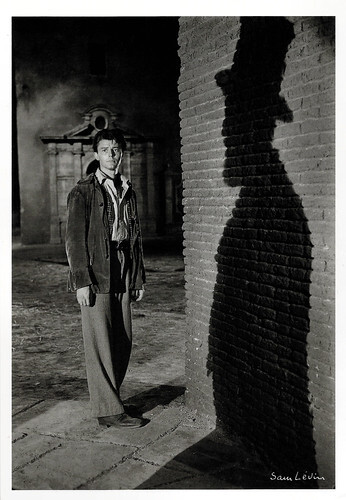
French postcard in the Collection Magie Noire by Editions Hazan, Paris, no. 6192, 1989. Photo: Sam Lévin. Gérard Philipe and the shadow of Michel Simon in La Beauté du diable (René Clair, 1950).
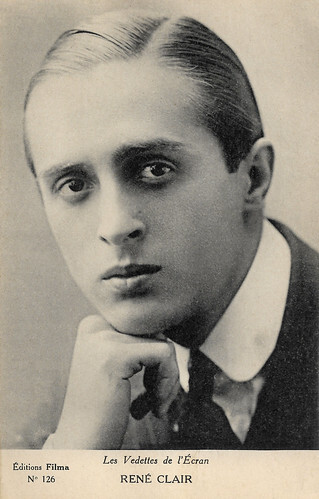
French postcard in the Les Vedettes de l'Écran series by Éditions Filma, no. 126.
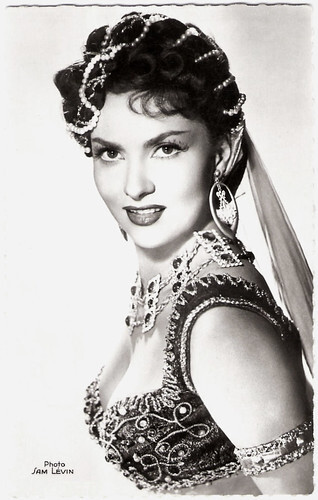
French postcard by Editions du Globe, Paris, no. 325. Photo: Sam Lévin. Gina Lollobrigida in Les belles de nuit / Beauties of the Night (René Clair, 1952).
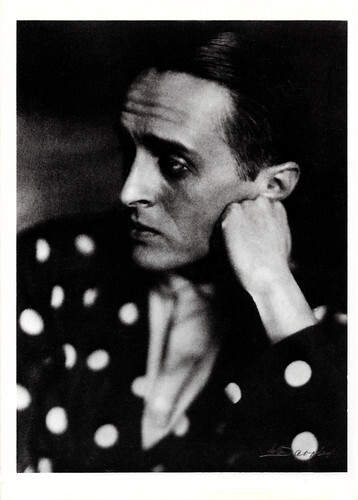
American postcard by Fotofolio, NY, NY, no. LJ5. Photo: Lotte Jacobi. Caption: René Clair, Berlin, c. 1920s.
A series of films with a taste for the fantastic
René Clair was born René Lucien Chomette in Paris in 1898. He was the son of a soap manufacturer. His elder brother, Henri Chomette, later also became a writer and director. René grew up in Paris in the district of Les Halles, whose lively and picturesque character made a lasting impression on him. He attended the Lycée Montaigne and then the Lycée Louis-le-Grand, where he became friends with the poet Jacques Rigaut. In 1917, he was mobilised as a volunteer ambulance driver during World War I. He was deeply affected by the horrors of war that he witnessed and gave expression to this in writing a volume of poetry called 'La Tête de l'homme', which remained unpublished.
In 1918, he started working as a journalist for the left-wing newspaper L'Intransigeant under the pseudonym René Després. He also wrote lyrics for the music-hall singer Damia , under the pseudonym Danceny. Clair was persuaded by her to visit Gaumont studios in 1920, where a film was being cast. With Damia , he made his debut as the lead actor in the silent film Le Lys de la vie / The Lily of Life (Loïe Fuller, Gabrielle Sorère, 1920), written by Queen Marie of Romania.
He went on to play roles in other films like the serials L'Orpheline / The Orphan (Louis Feuillade, 1921) and Parisette (Louis Feuillade, 1921), both starring Sandra Milowanoff , and Le Sens de la mort / The Meaning of Death (Yakov Protazanov, 1922) with Diana Karenne . For these films, he chose the pseudonym René Clair. He also became director of the cinema supplement for the magazine Théâtre et Comœdia illustré.
In 1922, he became Jacques de Baroncelli's assistant on two films. That same year, he began writing the screenplay for Le Rayon diabolique, which he shot in 1923 with the support of the producer Henri Diamant-Berger. The film was released in 1925 under the title Paris qui dort. In the meantime, Eric Satie's ballet 'Relâche', for which Francis Picabia had written the libretto, was to be staged at the Théâtre des Champs-Élysées. The theatre's director, Jacques Hébertot, was also the director of Comœdia. Picabia wanted a short film to be shown during the interval and chose René Clair to direct it. The Dadaist-inspired film Entr'acte (1924), in which Marcel Duchamp and Man Ray also took part, caused a scandal and made Clair famous.
In the following years, Clair made a series of films with a taste for the fantastic. His Sci-Fi comedy Paris qui dort / Paris Asleep (1925) was followed by Le Fantôme du Moulin-Rouge / The Phantom of the Moulin-Rouge (1925) and Le Voyage imaginaire / The Imaginary Voyage (1926), which featured Albert Préjean . In 1926, Clair joined Alexandre Kamenka's Films Albatros company to film a dramatic story, La Proie du vent / The Prey of the Wind (1926), with Charles Vanel and Jean Murat. The film was a commercial success. Clair remained at Albatros for his last two silent films, the comedies Un chapeau de paille d'Italie / The Italian Straw Hat (1928) and Les Deux Timides / Two Timid Souls (1928), based on two plays by Eugène Labiche. Wikipedia : "As the author of all of his own scripts, who also paid close attention to every aspect of the making of a film, including the editing, Clair was one of the first French filmmakers to establish for himself the full role of an auteur." At the same time, René Clair devoted himself to writing a novel, 'Adams', which was published by Grasset in 1926. In 1929, he co-wrote the screenplay for Prix de beauté (1930), which he was initially also to direct. The film was directed by Augusto Genina, and Louise Brooks played the lead role.
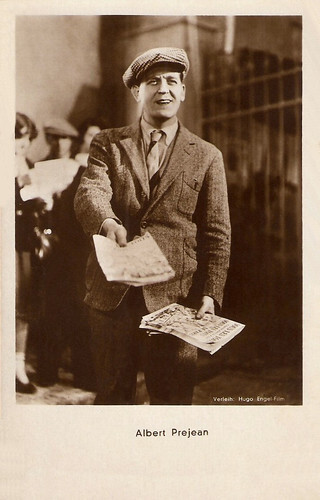
German card. Photo: Verleih Hugo Engel-Film. Albert Préjean in Sous les toits de Paris / Under the Roofs of Paris (René Clair, 1930). Préjean plays a street singer and here distributes the texts of the song 'Sous les toits de Paris'.
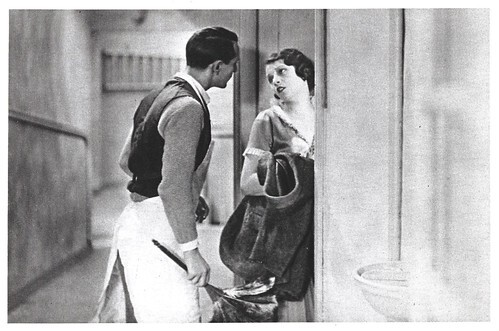
French postcard by Eds. Le Malibran, Paris. Annabella and René Lefèvre in the comedy Le million / The Million (René Clair, 1931).
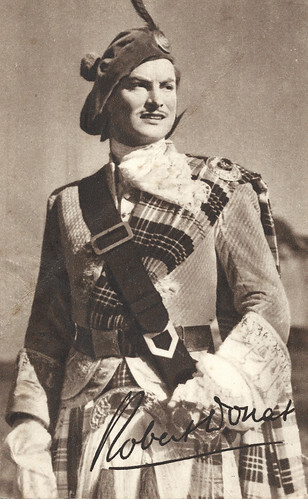
British postcard by. Photogravure. Robert Donat in the British comedy The Ghost Goes West (René Clair, 1935).
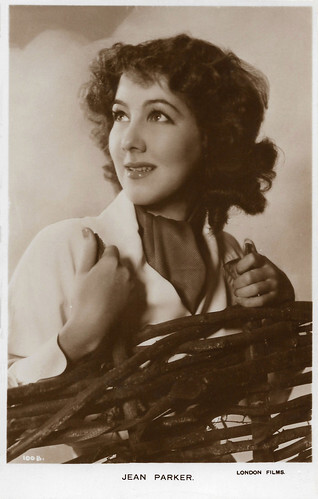
British Real Photograph postcard, no. 100b. Photo: London Films. Jean Parker in The Ghost Goes West (René Clair, 1935).
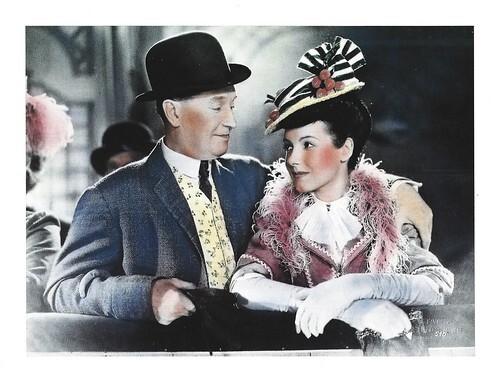
French coloured postcard by Eds. Centre Pompidou / Flammario, 1994. Maurice Chevalier and Marcelle Derrien in Le silence est d'or / Man About Town (René Clair, 1947).
An offer by Alexander Korda to work in London
René Clair was not happy with the arrival of sound film. He thought it would undermine the complex language constructed by the silent cinema over the last three decades. Ironically, it was his first talking film, Sous les toits de Paris / Under the Roofs of Paris (1930), that earned him an international reputation with prestigious admirers including Charles Chaplin and Sergei Eisenstein . He had realised the creative possibilities that sound film offered, particularly if the soundtrack was not used realistically; words and pictures should not be tied together in a clumsy duplication of information; dialogue did not always need to be heard.
His success was confirmed with the musicals Le Million / The Million (1931) with Annabella , À nous la liberté / Freedom for Us (1931), a utopian satire of industrial society, and Quatorze juillet / Bastille Day (1933). These films were made at the Epinay Studios for Films Sonores Tobis, a French subsidiary of the German-owned Tobis company.
When Chaplin's Modern Times came out in 1936. Tobis, which in 1935 had come under the control of Nazi propaganda minister Joseph Goebbels, decided to sue Chaplin for plagiarism of À nous la liberté / Freedom for Us (1931). Clair opposed this action, seeing Chaplin's film, which he admired, as an indirect homage to his film, but Tobis continued to sue Chaplin.
After the failure of Le Dernier Milliardaire / The Last Millionaire (1934), a satirical evocation of the 1929 crisis, René Clair accepted an offer by Alexander Korda to work in London. His first British film, The Ghost Goes West (1935), was a comic fantasy about transatlantic culture clash. It was a success. His next film, Break the News (1938), a musical comedy with Jack Buchanan and Maurice Chevalier , was a disappointment.
He returned to France in 1938 and began shooting a new project, Air pur, in July 1939. Shooting was interrupted by the mobilisation order in September, which sent various members of the film crew off to war, leaving the film unfinished. At the end of June 1940, René Clair left France with his wife and child. They went to Spain and then Portugal, and set sail for New York. The Vichy government stripped him of his French nationality, but reversed the decision later.
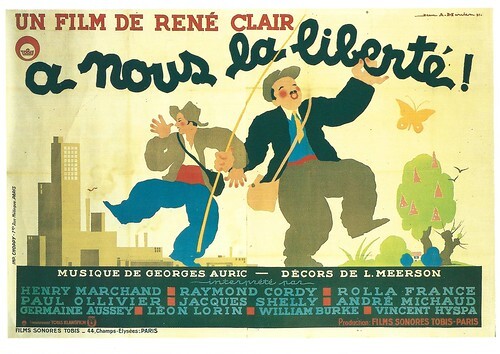
French film poster postcard by Dix et Démi Quinze, Paris, 1995. Affiche by Jean Adrien Mercier for À nous la liberté / Freedom for Us (René Clair, 1931). Released on the occasion of an exhibition on Jean Adrien Mercier.

Swiss poster postcard by CVB publishers. Affiche: Jean Adrien Mercier / Collection Cinémathèque Suisse, Lausanne. Affiche by Jean Adrien Mercier for Quatorze juillet / Bastille Day (René Clair, 1933).

French poster postcard by Eds. Zreik, Paris. Affiche Coll. Télérama, la mémoire du cinéma. French affiche for I Married a Witch (René Clair, 1940).
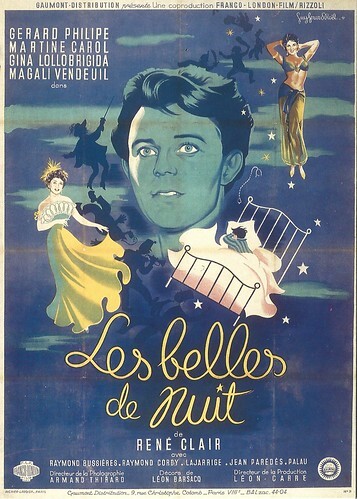
French poster postcard by F. Nugeron 29. Eds. Ramsay, Paris. Affiche: designed by Guy Gérard-Noèl. French poster for Les belles de nuit / Beauties of the Night (René Clair, 1952).
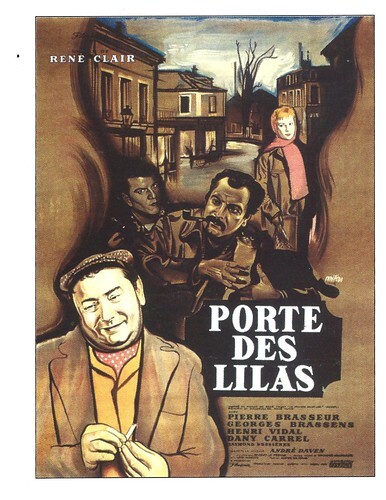
French poster postcard by Encyclopédie du Cinéma. Affiche: designed by René Peron. French poster for Porte des lilas / The Gates of Paris (René Clair, 1957), with Pierre Brasseur , Georges Brassens , Henri Vidal and Dany Carrel .
Four successful films in Hollywood
In June 1940, after the outbreak of World War II, René Clair emigrated to the United States, where he shot four successful films in Hollywood. He made his first American film for Universal Studios, The Flame of New Orleans (1941), starring Marlene Dietrich . The film was a commercial failure. Clair is highly regarded for the whimsical comedy I Married a Witch (1942), for which he effectively discovered latent comedic talents in his star Veronica Lake .
It was followed by It Happened Tomorrow (1944), which did respectably well. His mystery, And Then There Were None (1945), was an exceptional commercial success and is considered one of the most faithful adaptations of an Agatha Christie thriller. In 1946, Clair returned to France and made the romantic comedy Le silence est d'or / Silence is Golden (1947), an amusing evocation of the silent film era. It was Clair's first French film since the aborted project Air pur. Le silence est d'or also marked Maurice Chevalier 's return to the cinema after an absence of seven years.
Clair then made one of his most famous films, La Beauté du diable / Beauty and the Devil (1949), in which he revisited the myth of Faust and directed Gérard Philipe for the first time. Philipe also starred in his next film, the whimsical comedy Les Belles de nuit / Beauties of the Night (1952), also with Gina Lollobrigida . An International success was his film Les Grandes Manœuvres / Summer Manoeuvres (1955), starring Michèle Morgan, Gérard Philipe and Brigitte Bardot . His first film in colour won the Prix Louis-Delluc.
Clair then directed Porte des Lilas / The Gates of Paris (1957), featuring singer Georges Brassens in his only film appearance, playing the role of a singer who resembled him. From the 1950s, Clair also started writing, mainly essays, but also some novels and novellas. In 1960, he was elected as a member of the Académie française, as the first filmmaker. At the same time, the Nouvelle Vague overturned the rules of studio cinema, of which he had become the most prestigious representative. He then alternated between the sketch films La Française et l'Amour / Love and the Frenchwoman (1960) and Les Quatre Vérités / Three Fables of Love (1962) and the feature films Tout l'or du monde / All the Gold in the World (1961) with Bourvil , followed by his last film, Les Fêtes galantes / The Lace Wars (1965).
Clair then devoted himself to writing and directing plays. He restaged Francis Picabia's ballet 'Relâche' in 1970, and tried his hand at opera with 'Orphée et Eurydice' in 1973, presented at the Paris Opéra. In 1974, he was the president of the jury at the Cannes Film Festival. René Clair died in 1981 in Neuilly-sur-Seine, Hauts-de-Seine, France. He was buried in the ancient cemetery in Neuilly-sur-Seine. Since 1928, René Clair had been married to Bronia Clair. At the end of 1924, while Clair was working with Picabia, he first met a young actress, Bronja Perlmutter, who subsequently appeared in his film Le Voyage imaginaire (1926). They married in 1926, and their son, Jean-François, was born in 1927. Since 1994, the Académie has awarded the Prix René Clair for Best Camera Work.
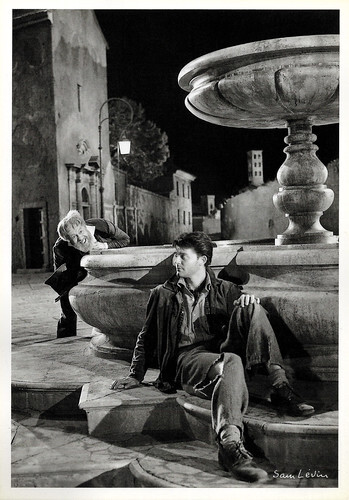
French postcard in the Collection Magie Noire by Editions Hazan, Paris, no. 6195, 1989. Photo: Sam Lévin. Gérard Philipe and Michel Simon in La Beauté du diable (René Clair, 1950).
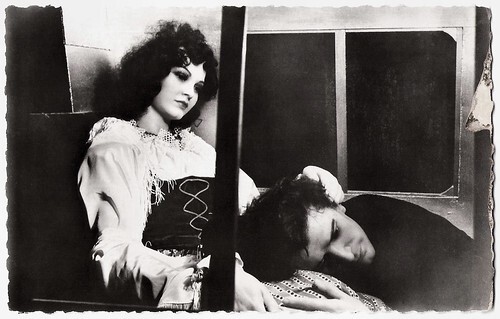
French postcard by Editions P.I. / Editions du Musée Grévin, Paris, no. 4. Photo: Musée Grévin, a wax museum in Paris, recreated a scene with wax figures of Gérard Philipe and Nicole Besnard in La Beauté du diable / Beauty and the Devil (René Clair, 1950). Caption: Voyage de noces a Venise (Honeymoon in Venice).
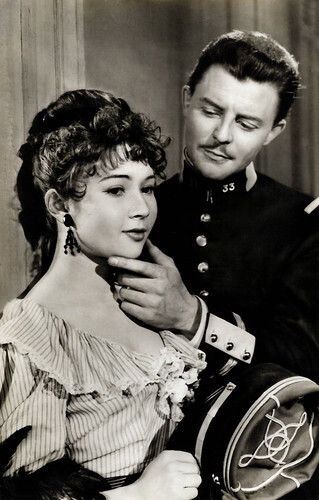
East-German postcard by VEB Progress Film-Vertrieb, Berlin, no. 212. Dany Carrel and Gérard Philipe in Les grandes manoeuvres / Summer Manoeuvres (René Clair, 1955).
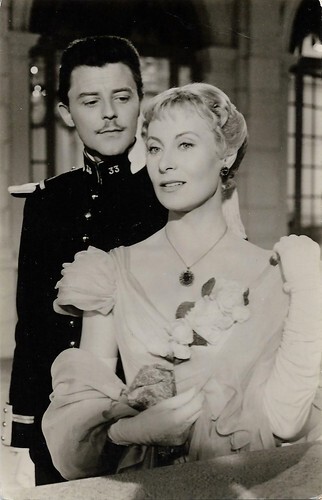
East-German postcard by VEB Progress Film-Vertrieb, Berlin, no. 194. Michèle Morgan and Gérard Philipe in Les grandes manoeuvres / Summer Manoeuvres (René Clair, 1955).
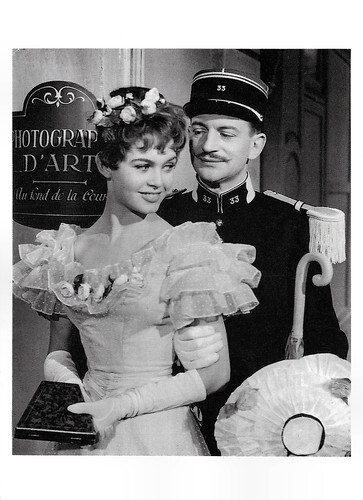
Swiss-German-British postcard by News Productions, Baulmes / Filmwelt Berlin, Bakede / News Productions, Stroud, no. 56501. Photo: Collection Cinémathèque Suisse, Lausanne. Brigitte Bardot and Yves Robert in Les Grandes Manoeuvres / Summer Manoeuvres (René Clair, 1955), produced by Filmsonor and Rizzoli Films.
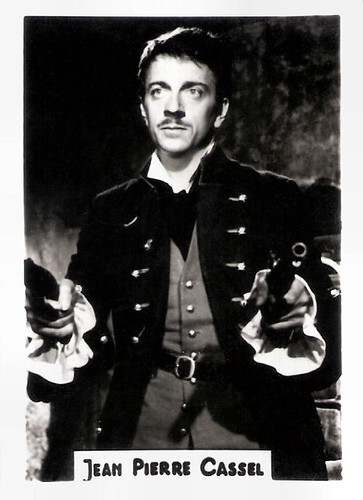
Small Romanian card by Cooperativa Fotografia, no. 2. Jean-Pierre Cassel in Les fêtes galantes / The Lace Wars (René Clair, 1965).
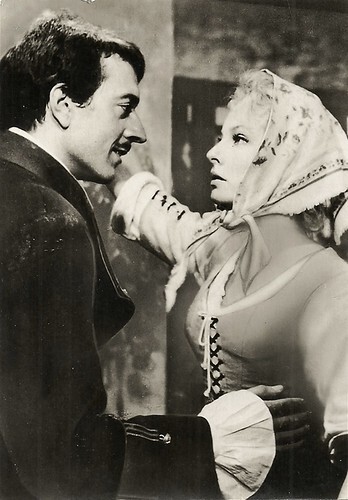
East-German postcard by VEB Progress Filmvertrieb, no. 2686. Jean-Pierre Cassel and Geneviève Casile in the Franco-Romanian coproduction Les Fêtes galantes / The Lace Wars (René Clair, 1965).
Sources: Wikipedia (Dutch, French and English) and .

Vintage postcard by Neobrom, no. 120.

French postcard in the Collection Magie Noire by Editions Hazan, Paris, no. 6192, 1989. Photo: Sam Lévin. Gérard Philipe and the shadow of Michel Simon in La Beauté du diable (René Clair, 1950).

French postcard in the Les Vedettes de l'Écran series by Éditions Filma, no. 126.

French postcard by Editions du Globe, Paris, no. 325. Photo: Sam Lévin. Gina Lollobrigida in Les belles de nuit / Beauties of the Night (René Clair, 1952).

American postcard by Fotofolio, NY, NY, no. LJ5. Photo: Lotte Jacobi. Caption: René Clair, Berlin, c. 1920s.
A series of films with a taste for the fantastic
René Clair was born René Lucien Chomette in Paris in 1898. He was the son of a soap manufacturer. His elder brother, Henri Chomette, later also became a writer and director. René grew up in Paris in the district of Les Halles, whose lively and picturesque character made a lasting impression on him. He attended the Lycée Montaigne and then the Lycée Louis-le-Grand, where he became friends with the poet Jacques Rigaut. In 1917, he was mobilised as a volunteer ambulance driver during World War I. He was deeply affected by the horrors of war that he witnessed and gave expression to this in writing a volume of poetry called 'La Tête de l'homme', which remained unpublished.
In 1918, he started working as a journalist for the left-wing newspaper L'Intransigeant under the pseudonym René Després. He also wrote lyrics for the music-hall singer Damia , under the pseudonym Danceny. Clair was persuaded by her to visit Gaumont studios in 1920, where a film was being cast. With Damia , he made his debut as the lead actor in the silent film Le Lys de la vie / The Lily of Life (Loïe Fuller, Gabrielle Sorère, 1920), written by Queen Marie of Romania.
He went on to play roles in other films like the serials L'Orpheline / The Orphan (Louis Feuillade, 1921) and Parisette (Louis Feuillade, 1921), both starring Sandra Milowanoff , and Le Sens de la mort / The Meaning of Death (Yakov Protazanov, 1922) with Diana Karenne . For these films, he chose the pseudonym René Clair. He also became director of the cinema supplement for the magazine Théâtre et Comœdia illustré.
In 1922, he became Jacques de Baroncelli's assistant on two films. That same year, he began writing the screenplay for Le Rayon diabolique, which he shot in 1923 with the support of the producer Henri Diamant-Berger. The film was released in 1925 under the title Paris qui dort. In the meantime, Eric Satie's ballet 'Relâche', for which Francis Picabia had written the libretto, was to be staged at the Théâtre des Champs-Élysées. The theatre's director, Jacques Hébertot, was also the director of Comœdia. Picabia wanted a short film to be shown during the interval and chose René Clair to direct it. The Dadaist-inspired film Entr'acte (1924), in which Marcel Duchamp and Man Ray also took part, caused a scandal and made Clair famous.
In the following years, Clair made a series of films with a taste for the fantastic. His Sci-Fi comedy Paris qui dort / Paris Asleep (1925) was followed by Le Fantôme du Moulin-Rouge / The Phantom of the Moulin-Rouge (1925) and Le Voyage imaginaire / The Imaginary Voyage (1926), which featured Albert Préjean . In 1926, Clair joined Alexandre Kamenka's Films Albatros company to film a dramatic story, La Proie du vent / The Prey of the Wind (1926), with Charles Vanel and Jean Murat. The film was a commercial success. Clair remained at Albatros for his last two silent films, the comedies Un chapeau de paille d'Italie / The Italian Straw Hat (1928) and Les Deux Timides / Two Timid Souls (1928), based on two plays by Eugène Labiche. Wikipedia : "As the author of all of his own scripts, who also paid close attention to every aspect of the making of a film, including the editing, Clair was one of the first French filmmakers to establish for himself the full role of an auteur." At the same time, René Clair devoted himself to writing a novel, 'Adams', which was published by Grasset in 1926. In 1929, he co-wrote the screenplay for Prix de beauté (1930), which he was initially also to direct. The film was directed by Augusto Genina, and Louise Brooks played the lead role.

German card. Photo: Verleih Hugo Engel-Film. Albert Préjean in Sous les toits de Paris / Under the Roofs of Paris (René Clair, 1930). Préjean plays a street singer and here distributes the texts of the song 'Sous les toits de Paris'.

French postcard by Eds. Le Malibran, Paris. Annabella and René Lefèvre in the comedy Le million / The Million (René Clair, 1931).

British postcard by. Photogravure. Robert Donat in the British comedy The Ghost Goes West (René Clair, 1935).

British Real Photograph postcard, no. 100b. Photo: London Films. Jean Parker in The Ghost Goes West (René Clair, 1935).

French coloured postcard by Eds. Centre Pompidou / Flammario, 1994. Maurice Chevalier and Marcelle Derrien in Le silence est d'or / Man About Town (René Clair, 1947).
An offer by Alexander Korda to work in London
René Clair was not happy with the arrival of sound film. He thought it would undermine the complex language constructed by the silent cinema over the last three decades. Ironically, it was his first talking film, Sous les toits de Paris / Under the Roofs of Paris (1930), that earned him an international reputation with prestigious admirers including Charles Chaplin and Sergei Eisenstein . He had realised the creative possibilities that sound film offered, particularly if the soundtrack was not used realistically; words and pictures should not be tied together in a clumsy duplication of information; dialogue did not always need to be heard.
His success was confirmed with the musicals Le Million / The Million (1931) with Annabella , À nous la liberté / Freedom for Us (1931), a utopian satire of industrial society, and Quatorze juillet / Bastille Day (1933). These films were made at the Epinay Studios for Films Sonores Tobis, a French subsidiary of the German-owned Tobis company.
When Chaplin's Modern Times came out in 1936. Tobis, which in 1935 had come under the control of Nazi propaganda minister Joseph Goebbels, decided to sue Chaplin for plagiarism of À nous la liberté / Freedom for Us (1931). Clair opposed this action, seeing Chaplin's film, which he admired, as an indirect homage to his film, but Tobis continued to sue Chaplin.
After the failure of Le Dernier Milliardaire / The Last Millionaire (1934), a satirical evocation of the 1929 crisis, René Clair accepted an offer by Alexander Korda to work in London. His first British film, The Ghost Goes West (1935), was a comic fantasy about transatlantic culture clash. It was a success. His next film, Break the News (1938), a musical comedy with Jack Buchanan and Maurice Chevalier , was a disappointment.
He returned to France in 1938 and began shooting a new project, Air pur, in July 1939. Shooting was interrupted by the mobilisation order in September, which sent various members of the film crew off to war, leaving the film unfinished. At the end of June 1940, René Clair left France with his wife and child. They went to Spain and then Portugal, and set sail for New York. The Vichy government stripped him of his French nationality, but reversed the decision later.

French film poster postcard by Dix et Démi Quinze, Paris, 1995. Affiche by Jean Adrien Mercier for À nous la liberté / Freedom for Us (René Clair, 1931). Released on the occasion of an exhibition on Jean Adrien Mercier.

Swiss poster postcard by CVB publishers. Affiche: Jean Adrien Mercier / Collection Cinémathèque Suisse, Lausanne. Affiche by Jean Adrien Mercier for Quatorze juillet / Bastille Day (René Clair, 1933).

French poster postcard by Eds. Zreik, Paris. Affiche Coll. Télérama, la mémoire du cinéma. French affiche for I Married a Witch (René Clair, 1940).

French poster postcard by F. Nugeron 29. Eds. Ramsay, Paris. Affiche: designed by Guy Gérard-Noèl. French poster for Les belles de nuit / Beauties of the Night (René Clair, 1952).

French poster postcard by Encyclopédie du Cinéma. Affiche: designed by René Peron. French poster for Porte des lilas / The Gates of Paris (René Clair, 1957), with Pierre Brasseur , Georges Brassens , Henri Vidal and Dany Carrel .
Four successful films in Hollywood
In June 1940, after the outbreak of World War II, René Clair emigrated to the United States, where he shot four successful films in Hollywood. He made his first American film for Universal Studios, The Flame of New Orleans (1941), starring Marlene Dietrich . The film was a commercial failure. Clair is highly regarded for the whimsical comedy I Married a Witch (1942), for which he effectively discovered latent comedic talents in his star Veronica Lake .
It was followed by It Happened Tomorrow (1944), which did respectably well. His mystery, And Then There Were None (1945), was an exceptional commercial success and is considered one of the most faithful adaptations of an Agatha Christie thriller. In 1946, Clair returned to France and made the romantic comedy Le silence est d'or / Silence is Golden (1947), an amusing evocation of the silent film era. It was Clair's first French film since the aborted project Air pur. Le silence est d'or also marked Maurice Chevalier 's return to the cinema after an absence of seven years.
Clair then made one of his most famous films, La Beauté du diable / Beauty and the Devil (1949), in which he revisited the myth of Faust and directed Gérard Philipe for the first time. Philipe also starred in his next film, the whimsical comedy Les Belles de nuit / Beauties of the Night (1952), also with Gina Lollobrigida . An International success was his film Les Grandes Manœuvres / Summer Manoeuvres (1955), starring Michèle Morgan, Gérard Philipe and Brigitte Bardot . His first film in colour won the Prix Louis-Delluc.
Clair then directed Porte des Lilas / The Gates of Paris (1957), featuring singer Georges Brassens in his only film appearance, playing the role of a singer who resembled him. From the 1950s, Clair also started writing, mainly essays, but also some novels and novellas. In 1960, he was elected as a member of the Académie française, as the first filmmaker. At the same time, the Nouvelle Vague overturned the rules of studio cinema, of which he had become the most prestigious representative. He then alternated between the sketch films La Française et l'Amour / Love and the Frenchwoman (1960) and Les Quatre Vérités / Three Fables of Love (1962) and the feature films Tout l'or du monde / All the Gold in the World (1961) with Bourvil , followed by his last film, Les Fêtes galantes / The Lace Wars (1965).
Clair then devoted himself to writing and directing plays. He restaged Francis Picabia's ballet 'Relâche' in 1970, and tried his hand at opera with 'Orphée et Eurydice' in 1973, presented at the Paris Opéra. In 1974, he was the president of the jury at the Cannes Film Festival. René Clair died in 1981 in Neuilly-sur-Seine, Hauts-de-Seine, France. He was buried in the ancient cemetery in Neuilly-sur-Seine. Since 1928, René Clair had been married to Bronia Clair. At the end of 1924, while Clair was working with Picabia, he first met a young actress, Bronja Perlmutter, who subsequently appeared in his film Le Voyage imaginaire (1926). They married in 1926, and their son, Jean-François, was born in 1927. Since 1994, the Académie has awarded the Prix René Clair for Best Camera Work.

French postcard in the Collection Magie Noire by Editions Hazan, Paris, no. 6195, 1989. Photo: Sam Lévin. Gérard Philipe and Michel Simon in La Beauté du diable (René Clair, 1950).

French postcard by Editions P.I. / Editions du Musée Grévin, Paris, no. 4. Photo: Musée Grévin, a wax museum in Paris, recreated a scene with wax figures of Gérard Philipe and Nicole Besnard in La Beauté du diable / Beauty and the Devil (René Clair, 1950). Caption: Voyage de noces a Venise (Honeymoon in Venice).

East-German postcard by VEB Progress Film-Vertrieb, Berlin, no. 212. Dany Carrel and Gérard Philipe in Les grandes manoeuvres / Summer Manoeuvres (René Clair, 1955).

East-German postcard by VEB Progress Film-Vertrieb, Berlin, no. 194. Michèle Morgan and Gérard Philipe in Les grandes manoeuvres / Summer Manoeuvres (René Clair, 1955).

Swiss-German-British postcard by News Productions, Baulmes / Filmwelt Berlin, Bakede / News Productions, Stroud, no. 56501. Photo: Collection Cinémathèque Suisse, Lausanne. Brigitte Bardot and Yves Robert in Les Grandes Manoeuvres / Summer Manoeuvres (René Clair, 1955), produced by Filmsonor and Rizzoli Films.

Small Romanian card by Cooperativa Fotografia, no. 2. Jean-Pierre Cassel in Les fêtes galantes / The Lace Wars (René Clair, 1965).

East-German postcard by VEB Progress Filmvertrieb, no. 2686. Jean-Pierre Cassel and Geneviève Casile in the Franco-Romanian coproduction Les Fêtes galantes / The Lace Wars (René Clair, 1965).
Sources: Wikipedia (Dutch, French and English) and .
Published on September 27, 2025 22:00
September 26, 2025
Sarah Vaughan
American artist Sarah Vaughan (1924-1990) ranked with Ella Fitzgerald and Billie Holiday in the top echelon of female jazz singers. She is known for her expressive voice, unique vibrato and large vocal range. Nicknamed 'Sassy' and 'The Divine One', Vaughan was a two-time Grammy Award winner and won an Emmy in 1981 for a tribute to George Gershwin.
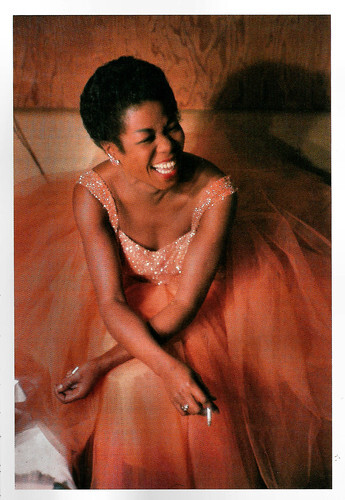
German postcard by Benedikt Taschen Berlag GMBH, Köln, 1997. Photo: William Claxton. Caption: Sarah Vaughan, New York City, 1960, from the book 'William Claxton's Jazz Photography'.
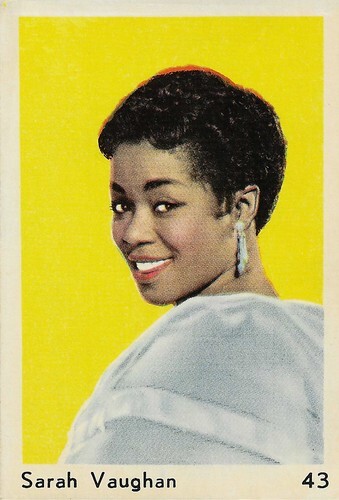
Dutch collector card, no. 43.
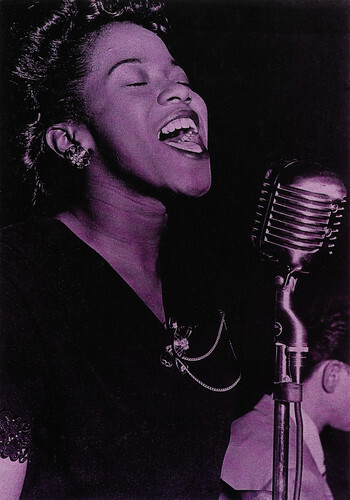
French postcard by Éditions du Désastre, Paris, no. FD10, 1992. Photo: F. Driggs Collection / Magnum / Éditions du Désastre. Caption: Sarah Vaughan, 1946.
Winning the $10 prize and a week's engagement at the Apollo
Sarah Lois Vaughan was born in 1924 in Newark, New Jersey. Her parents, Asbury Vaughan, a carpenter, and Ada Vaughan, a laundress, were also musicians. She began studying music when she was seven, taking eight years of piano lessons and two years of organ. As a child, she sang in the choir at the Mt. Zion Baptist Church in Newark and played piano and organ in high school productions at Arts High School.
As her adventures as a performer overtook her academic pursuits, she dropped out of high school during her junior year to concentrate more fully on her music. At 18, she entered an amateur contest at the Apollo Theatre in New York's Harlem area, singing 'Body and Soul' and won the $10 prize and a week's engagement at the Apollo.
She caught the attention of bandleader and pianist Earl Hines, with whose big band Sarah Vaughan became a singer. From 1943 to 1945, she sang together with Hines's singer at the time, Billy Eckstine.
In 1945, Vaughan went solo. Well-known songs from that period include 'Lover Man' (1945), the Jazz standard 'Tenderly' (1947) and 'Nature Boy' (1947). Her recording of 'It's Magic' from the Doris Day film Romance on the High Seas (Michael Curtiz, 1948) became a hit in the charts in early 1948. She signed with Columbia, and her chart successes continued with 'Black Coffee' in the summer of 1949.
Until 1953, Columbia steered her almost exclusively to commercial pop ballads, like 'That Lucky Old Sun', 'Thinking of You' (with pianist Bud Powell), and 'I Cried for You'. Vaughan sang to large crowds in clubs around the country during the late 1940s and early 1950s. In the summer of 1949, she made her first appearance with a symphony orchestra in a benefit for the Philadelphia Orchestra entitled '100 Men and a Girl.'
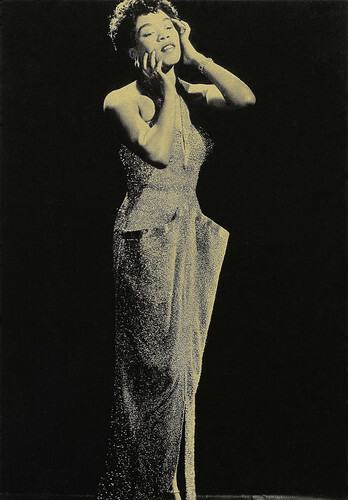
French postcard by Éditions du Désastre, Paris, no. FD08, 1992. Photo: F. Driggs Collection / Magnum / Éditions du Désastre. Caption: Sarah Vaughan, 1947.
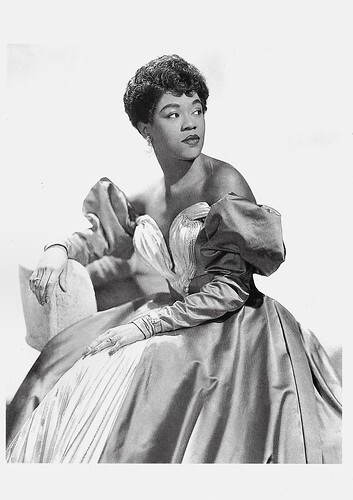
American postcard by Pomegranate, Petaluma, CA, no. 2129. Photo: Michael Ochs. Caption: Sarah Vaughan, c. 1959, 'Broken Hearted Melody'.

American postcard by The American Postcard Co., Inc., no. 110. Photo: Michael Ochs. Caption: Sarah Vaughan, 1959.
Her wide range, perfectly controlled vibrato, and wide expressive abilities
Sarah Vaughan performed her songs in several films, including Disc Jockey (Will Jason, 1951) starring Tom Drake, the crime film Murder, Inc. (Burt Balaban, Stuart Rosenberg, 1960) with Stuart Whitman and May Britt , and the German production Schlager-Raketen / Hits Rocket (Erik Ode, 1960).
Scott Yanow at AllMusic : "She often gave the impression that with her wide range, perfectly controlled vibrato, and wide expressive abilities, she could do anything she wanted with her voice." In 1953, Vaughan signed a contract with Mercury in which she would record commercial material for Mercury and jazz-oriented material for its subsidiary, EmArcy. She was paired with producer Bob Shad, and their working relationship yielded commercial and artistic success.
She remained with Mercury through 1959. After recording for Roulette from 1960 to 1963, she returned to Mercury from 1964 to 1967. Her hits at Mercury included 'Make Yourself Comfortable', 'How Important Can It Be' (with Count Basie), 'Whatever Lola Wants' and 'The Banana Boat Song'. Her commercial success peaked with 'Broken Hearted Melody' (1959), a song she considered 'corny' but became her first gold record. Vaughan was reunited with Billy Eckstine for a series of duet recordings in 1957 that yielded the hit 'Passing Strangers'.
In the latter half of the 1950s, she followed a schedule of almost non-stop touring. She was featured at the first Newport Jazz Festival in the summer of 1954 and starred in subsequent editions of that festival at Newport and New York City for the remainder of her life. In the fall of 1954, she performed at Carnegie Hall with the Count Basie Orchestra on a bill that also included Billie Holiday, Charlie Parker, Lester Young and the Modern Jazz Quartet. She also toured Europe several times.
Vaughan continued to release records and perform until the early 1980s, working with luminaries such as Miles Davis and Quincy Jones. In 1947, she married her manager, trumpeter George Treadwell. Her later husbands were pro football player Clyde B. Atkins (1958-1963) and trumpeter Waymon Reed (1978-1981). All her marriages ended in divorce. She and Clyde B. Atkins adopted a daughter in 1961, whom they named Deborah Lois, now actress Paris Vaughan. Sarah Vaughan received many awards, including an Emmy in 1981 for a tribute to George Gershwin. She won two Grammy Awards, including the Lifetime Achievement Award, and was nominated for a total of nine Grammy Awards. Vaughan died in 1990, in Hidden Hills, Los Angeles, of lung cancer. Following her death, she was interred at Glendale Cemetery in Bloomfield, New Jersey.
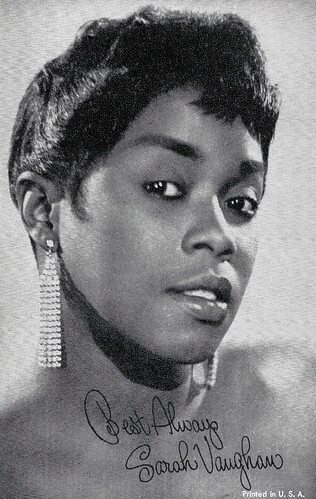
American Arcade card.
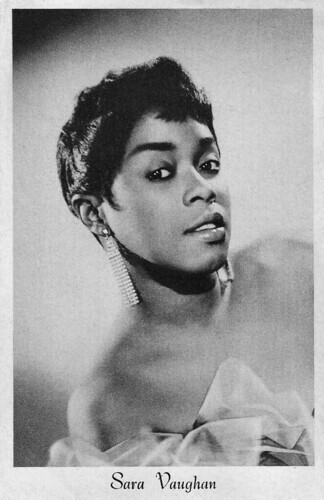
Vintage card.
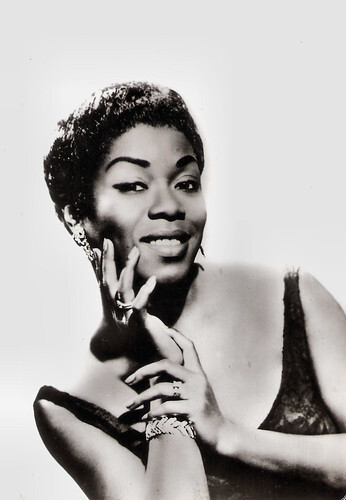
Dutch postcard by Syba, Enkhuizen, no. 14. Photo: Mercury.
Sources: (IMDb), Scott Yanow (AllMusic), Wikipedia and .

German postcard by Benedikt Taschen Berlag GMBH, Köln, 1997. Photo: William Claxton. Caption: Sarah Vaughan, New York City, 1960, from the book 'William Claxton's Jazz Photography'.

Dutch collector card, no. 43.

French postcard by Éditions du Désastre, Paris, no. FD10, 1992. Photo: F. Driggs Collection / Magnum / Éditions du Désastre. Caption: Sarah Vaughan, 1946.
Winning the $10 prize and a week's engagement at the Apollo
Sarah Lois Vaughan was born in 1924 in Newark, New Jersey. Her parents, Asbury Vaughan, a carpenter, and Ada Vaughan, a laundress, were also musicians. She began studying music when she was seven, taking eight years of piano lessons and two years of organ. As a child, she sang in the choir at the Mt. Zion Baptist Church in Newark and played piano and organ in high school productions at Arts High School.
As her adventures as a performer overtook her academic pursuits, she dropped out of high school during her junior year to concentrate more fully on her music. At 18, she entered an amateur contest at the Apollo Theatre in New York's Harlem area, singing 'Body and Soul' and won the $10 prize and a week's engagement at the Apollo.
She caught the attention of bandleader and pianist Earl Hines, with whose big band Sarah Vaughan became a singer. From 1943 to 1945, she sang together with Hines's singer at the time, Billy Eckstine.
In 1945, Vaughan went solo. Well-known songs from that period include 'Lover Man' (1945), the Jazz standard 'Tenderly' (1947) and 'Nature Boy' (1947). Her recording of 'It's Magic' from the Doris Day film Romance on the High Seas (Michael Curtiz, 1948) became a hit in the charts in early 1948. She signed with Columbia, and her chart successes continued with 'Black Coffee' in the summer of 1949.
Until 1953, Columbia steered her almost exclusively to commercial pop ballads, like 'That Lucky Old Sun', 'Thinking of You' (with pianist Bud Powell), and 'I Cried for You'. Vaughan sang to large crowds in clubs around the country during the late 1940s and early 1950s. In the summer of 1949, she made her first appearance with a symphony orchestra in a benefit for the Philadelphia Orchestra entitled '100 Men and a Girl.'

French postcard by Éditions du Désastre, Paris, no. FD08, 1992. Photo: F. Driggs Collection / Magnum / Éditions du Désastre. Caption: Sarah Vaughan, 1947.

American postcard by Pomegranate, Petaluma, CA, no. 2129. Photo: Michael Ochs. Caption: Sarah Vaughan, c. 1959, 'Broken Hearted Melody'.

American postcard by The American Postcard Co., Inc., no. 110. Photo: Michael Ochs. Caption: Sarah Vaughan, 1959.
Her wide range, perfectly controlled vibrato, and wide expressive abilities
Sarah Vaughan performed her songs in several films, including Disc Jockey (Will Jason, 1951) starring Tom Drake, the crime film Murder, Inc. (Burt Balaban, Stuart Rosenberg, 1960) with Stuart Whitman and May Britt , and the German production Schlager-Raketen / Hits Rocket (Erik Ode, 1960).
Scott Yanow at AllMusic : "She often gave the impression that with her wide range, perfectly controlled vibrato, and wide expressive abilities, she could do anything she wanted with her voice." In 1953, Vaughan signed a contract with Mercury in which she would record commercial material for Mercury and jazz-oriented material for its subsidiary, EmArcy. She was paired with producer Bob Shad, and their working relationship yielded commercial and artistic success.
She remained with Mercury through 1959. After recording for Roulette from 1960 to 1963, she returned to Mercury from 1964 to 1967. Her hits at Mercury included 'Make Yourself Comfortable', 'How Important Can It Be' (with Count Basie), 'Whatever Lola Wants' and 'The Banana Boat Song'. Her commercial success peaked with 'Broken Hearted Melody' (1959), a song she considered 'corny' but became her first gold record. Vaughan was reunited with Billy Eckstine for a series of duet recordings in 1957 that yielded the hit 'Passing Strangers'.
In the latter half of the 1950s, she followed a schedule of almost non-stop touring. She was featured at the first Newport Jazz Festival in the summer of 1954 and starred in subsequent editions of that festival at Newport and New York City for the remainder of her life. In the fall of 1954, she performed at Carnegie Hall with the Count Basie Orchestra on a bill that also included Billie Holiday, Charlie Parker, Lester Young and the Modern Jazz Quartet. She also toured Europe several times.
Vaughan continued to release records and perform until the early 1980s, working with luminaries such as Miles Davis and Quincy Jones. In 1947, she married her manager, trumpeter George Treadwell. Her later husbands were pro football player Clyde B. Atkins (1958-1963) and trumpeter Waymon Reed (1978-1981). All her marriages ended in divorce. She and Clyde B. Atkins adopted a daughter in 1961, whom they named Deborah Lois, now actress Paris Vaughan. Sarah Vaughan received many awards, including an Emmy in 1981 for a tribute to George Gershwin. She won two Grammy Awards, including the Lifetime Achievement Award, and was nominated for a total of nine Grammy Awards. Vaughan died in 1990, in Hidden Hills, Los Angeles, of lung cancer. Following her death, she was interred at Glendale Cemetery in Bloomfield, New Jersey.

American Arcade card.

Vintage card.

Dutch postcard by Syba, Enkhuizen, no. 14. Photo: Mercury.
Sources: (IMDb), Scott Yanow (AllMusic), Wikipedia and .
Published on September 26, 2025 22:00
September 25, 2025
Claudia Cardinale (1938-2025), Part 2
Italian actress Claudia Cardinale (1938-2025), who passed away last Tuesday, was one of Europe's most iconic and versatile film stars. The success of her films 8½ (1963) and Il Gattopardo/The Leopard (1963) piqued Hollywood's interest in her. But she returned to Italy to make the ultimate Spaghetti Western. In the following decades, she continued to star in many interesting European films. This is part 2 of EFSP's In Memoriam post on her.
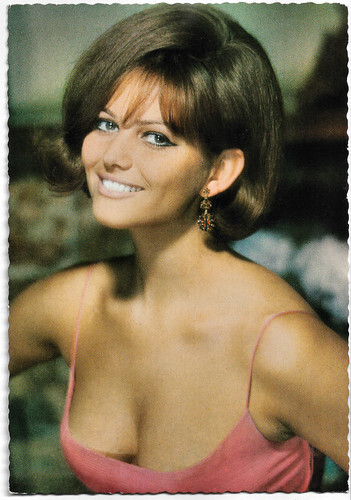
French postcard by E.D.U.G., no. 459. Photo: Sam Lévin.
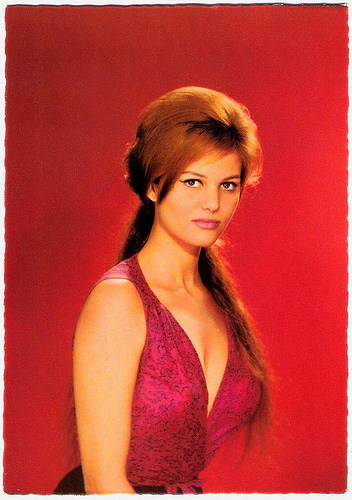
French postcard by E.D.U.G., no. 183. Photo: Sam Lévin.
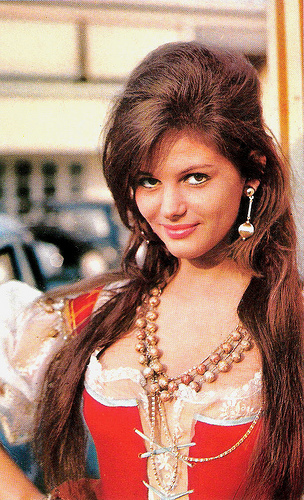
French postcard by Edition P.I., Paris, no. 1102. Photo: Kasparian. Publicity still for Cartouche (1962).
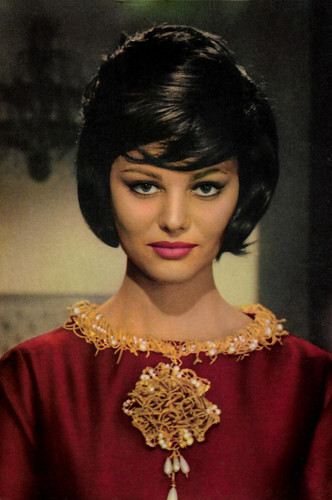
Spanish postcard by Ediciones Raker, Barcelona. no. 1094. Photo: Claudia Cardinale in The Pink Panther (Blake Edwards, 1963).
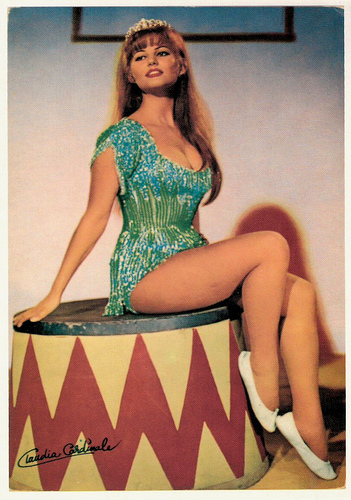
Postcard by Moviestar 1961, no. F 73. Photo: Publicity still for Circus World (1964).
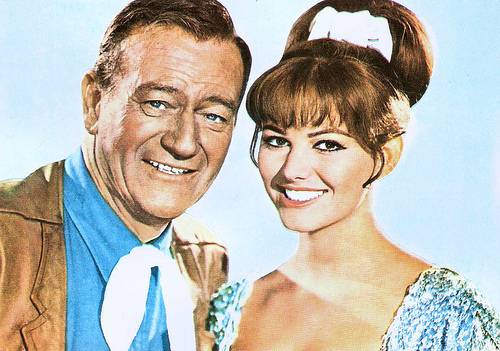
Romanian postcard by Casa Filmului Acin. Publicity still for Circus World (Henry Hathaway, 1964) with John Wayne .
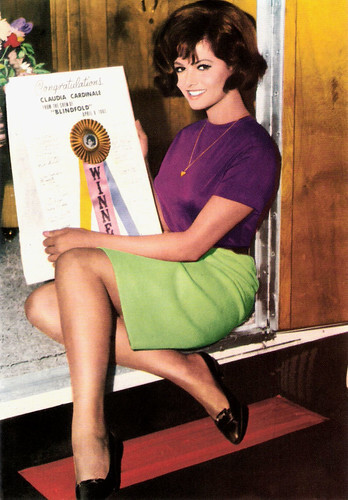
Spanish postcard by Postal Oscar Color, no. 567. Holding an announcement for an award for Blindfold (Philip Dunne, 1966).
Pink Panther
In 1963, Claudia Cardinale played the princess who owned the Pink Panther diamond in The Pink Panther (Blake Edwards, 1963), which was filmed in Italy. It was the first in the series of detective comedies starring Peter Sellers as bumbling French Inspector Jacques Clouseau (the mishap-prone snoop was actually a supporting player in his debut).
The film was an enormous success and brought CC to English-speaking audiences. In 1964, she co-starred with John Wayne and Rita Hayworth in her first American production, Circus World (Henry Hathaway, 1964). It was another box-office hit.
The following year, she appeared with Rock Hudson in Blindfold (Philip Dunne, 1966), an offbeat mixture of espionage and slapstick comedy.
The Professionals (Richard Brooks, 1966) is her favourite among her Hollywood films. In this Western, she is a gutsy Mexican woman married against her will to a rich American. The film received Academy Award nominations for Best Direction (Richard Brooks), Best Screenplay (Brooks again), and Best Cinematography (Conrad L. Hall).
Claudia Cardinale continued dividing her time between Hollywood and Europe for the remainder of the decade.
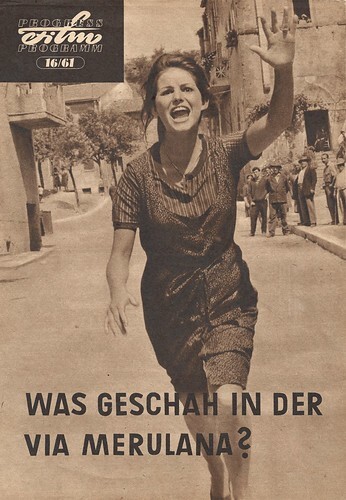
Cover of Progress Film Programm, no. 16/61. Claudia Cardinale in Un maledetto imbroglio / The Facts of Murder (Pietro Germi, 1959), based on Carlo Emilio Gadda's novel 'Quer pasticciaccio brutto de via Merulana' (That Awful Mess on Via Merulana, 1957). Via Merulana is a major street in Rome. The German title of the film was: Was geschah in der Via Merulana?
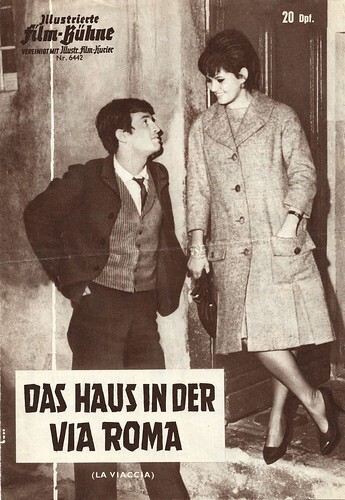
Cover of Illustrierte Film-Bühne, no. 6442. Claudia Cardinale and Jean-Paul Belmondo during the shooting of La viaccia / The Lovemakers (Mauro Bolognini, 1961). Belmondo wears his outfit from this period film, set in the 1880s. Cardinale wears her modern clothes. The German title of the film was Das Haus in der Via Roma.
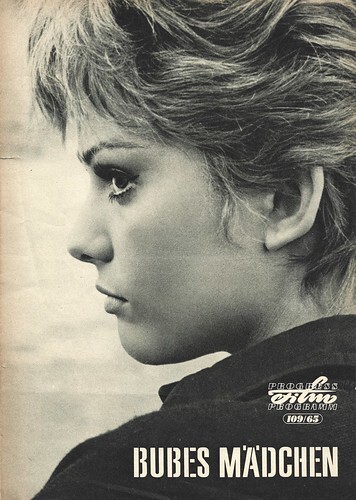
Cover Progress Film Programm, no. 109/65. Claudia Cardinale in La ragazza di Bube / Bebo's Girl (Luigi Comencini, 1963). The German title was Bubes Mädchen.

Small Czech collector card by Pressfoto, Praha (Prague), 1965, no. S 101/7. The retail price was Kcs 0,50. Photo: Claudia Cardinale in La ragazza di Bube / Bebo's Girl (Luigi Comencini, 1963). The film was presented at the Karlovy Vary International Film Festival in 1964.
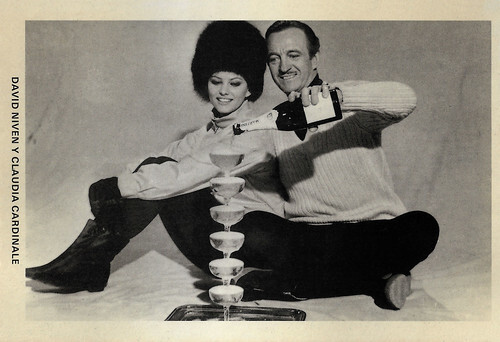
Spanish postcard by Productos Compactos, no. 44526, 1990. Claudia Cardinale and David Niven on a publicity still for The Pink Panther (Blake Edwards, 1963).
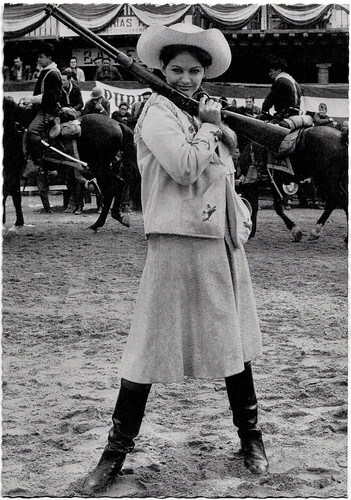
West German by Filmbilder-Vertrieb Ernst Freihoff, Essen, no. 890. Photo: Lothar Winkler. Claudia Cardinale in Circus World (Henry Hathaway, 1964).
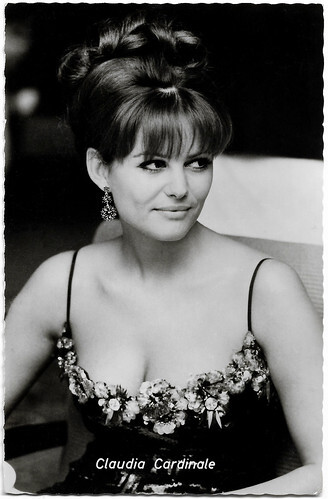
West German postcard by Kolibri / Friedrich W. Sander Verlag, Minden/Westf, no. 2367. Photo: Schorcht. Claudia Cardinale in Il magnifico cornuto / The Magnificent Cuckold (Antonio Pietrangeli, 1964).
The ultimate Spaghetti Western
Throughout the 1960s, Claudia Cardinale also appeared in some of the best European films. In France, she appeared in the Swashbuckler Cartouche (Philippe de Broca, 1962), featuring Jean-Paul Belmondo.
Back in Italy, she played in I Giorno della civetta / The Day of the Owl (Damiano Damiani, 1968) with Franco Nero , and Nell'anno del Signore / The Conspirators (Luigi Magni, 1969) with Nino Manfredi .
Mesmerising is her performance in Sandra / Vaghe stelle dell'Orsa... (Luchino Visconti, 1965) as a Holocaust survivor with an incestuous relationship with her brother ( Jean Sorel ).
Another highlight in her career is C'era una volta il West / Once Upon a Time in the West (Sergio Leone, 1968), the ultimate Spaghetti Western. Lucia Bozzola writes in her review at AllMovie : "In Sergio Leone's epic Western, shot partly in Monument Valley, a revenge story becomes an epic contemplation of the Western past. (...)
As in his 'Dollars' trilogy, Leone transforms the standard Western plot through the visual impact of widescreen landscapes and the figures therein. At its full length, Once Upon a Time in the West is Leone's operatic masterwork, worthy of its legend-making title."
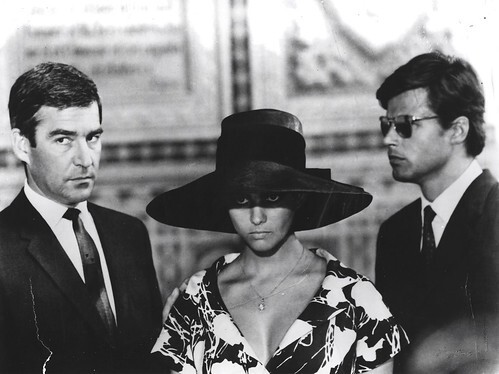
Vintage still. Claudia Cardinale, Michael Craig and Jean Sorel in Vaghe stelle dell'Orsa / Sandra (Luchino Visconti, 1965).
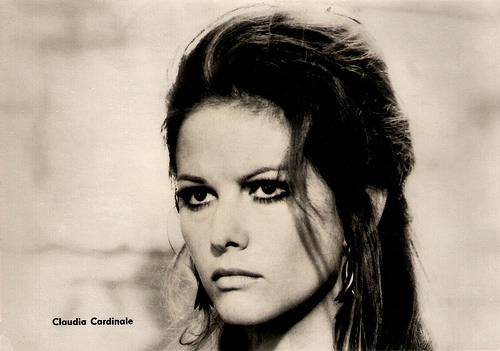
East German postcard by VEB Progress Filmvertrieb, Berlin, no. 225/69, 1969. Photo: publicity still for Il giorno della civetta / The Day of the Owl (Damiano Damiani, 1968).
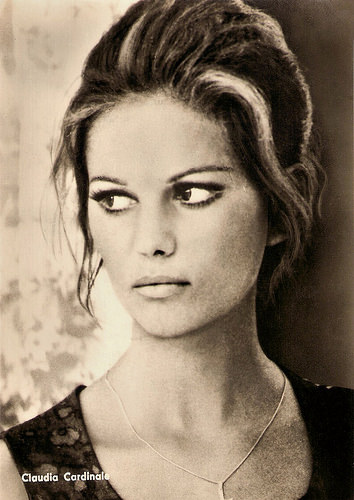
East German postcard by VEB Progress Filmvertrieb, Berlin, no. 20/70, 1970. Photo: publicity still for Il giorno della civetta / The Day of the Owl (Damiano Damiani, 1968).

Romanian postcard by Casa Filmului Acin, no. 427. Photo: publicity still for Il giorno della civetta / The Day of the Owl (Damiano Damiani, 1968) with Franco Nero .
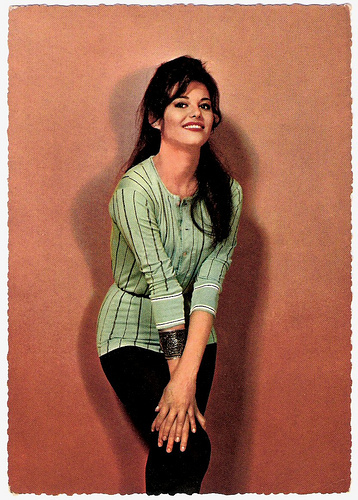
German postcard by Krüger, no. 902/47.
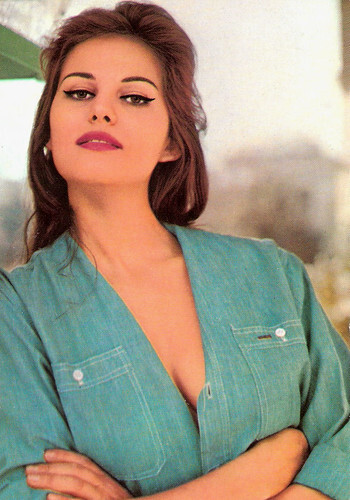
German postcard by Krüger, no. 902/115.
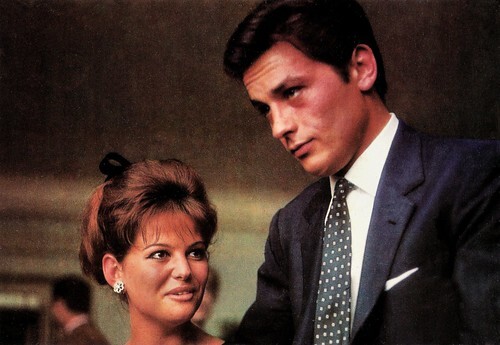
Spanish postcard by Postal Oscarcolor, no. 343. With Alain Delon.
International arthouse hit
In the following decades, Claudia Cardinale remained mainly active in European cinema. She played a small part for Visconti in Gruppo di famiglia in un interno / Conversation Piece (Luchino Visconti, 1974) starring Burt Lancaster and Silvana Mangano .
She worked with other major Italian directors at Goodbye e amen (Damiano Damiani, 1977), the TV mini-series Jesus of Nazareth (Franco Zeffirelli, 1977) as the adulteress, and La Pelle / The Skin (Liliana Cavani, 1981) starring Marcello Mastroianni and based on the bitter novel by Curzio Malaparte concerning the Allied liberation of Naples.
An international arthouse hit was Fitzcarraldo (Werner Herzog, 1982), the story of an obsessed impresario ( Klaus Kinski ) whose foremost desire in life is to bring both Enrico Caruso and an opera house to the deepest jungles of South America. In his diary of the making of Fitzcarraldo, Werner Herzog writes: "Claudia Cardinale is a great help because she is such a good sport, a real trouper, and has a special radiance before the camera. In her presence, [ Klaus Kinski ] usually acts like a gentleman."
Other interesting films include the Luigi Pirandello adaptation Enrico IV / Henry IV (Marco Bellocchio, 1984) with Marcello Mastroianni , the epic La révolution française / The French Revolution (Robert Enrico, Richard T. Heffron, 1989), the nostalgic drama Mayrig / Mother (Henri Verneuil, 1991), and the romantic thriller And now... Ladies and Gentlemen (Claude Lelouch, 2002) starring Jeremy Irons .
On Television, she gave another well-received performance in the TV drama La storia / History (Luigi Comencini, 1986), in which she plays a widow raising a son during World War II.

French postcard by E.D.U.G., no. 229. Photo: Sam Lévin.

German postcard in the Kolibri Foto-Karte series by Friedrich W. Sander-Verlag, Minden-Westf., no. 2515. Photo: Universal International. Publicity still for The Hell with Heroes (Joseph Sargent, 1968). Collection: Daniël van der Aa.
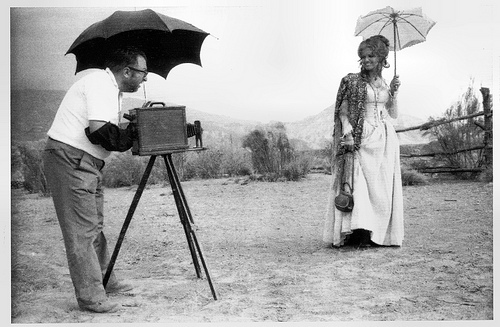
Italian postcard by Cineteca Bologna for the exhibition Un Altro West (2008). Photo: A. Novi. Sergio Leone and Claudia Cardinale on the set of C'era una volta il West / Once Upon a Time in the West (Sergio Leone, 1968).
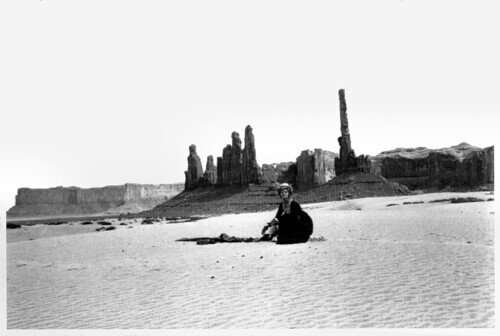
Italian postcard by Cineteca Bologna, 2007. Photo: A. Novi / Cineteca di Bologna. Claudia Cardinale in C'era una volta il West / Once Upon a Time in the West (Sergio Leone, 1968).
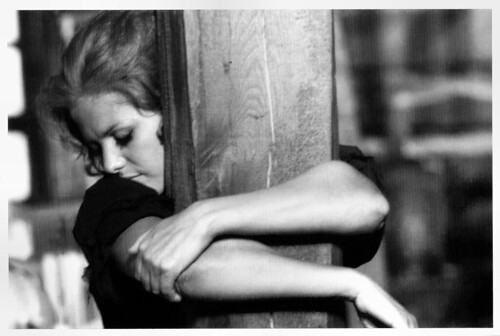
Italian postcard by Cineteca Bologna, 2007. Photo: A. Novi / Cineteca di Bologna. Claudia Cardinale in C'era una volta il West / Once Upon a Time in the West (Sergio Leone, 1968).

Italian postcard by Gruppo Editoriale Lo Vecchio, Genova, in the Alberto Sordi series. Photo: publicity still for Bello, onesto, emigrato in Australia sposerebbe compaesana illibata / A Girl in Australia (Luigi Zampa, 1971) with Alberto Sordi.
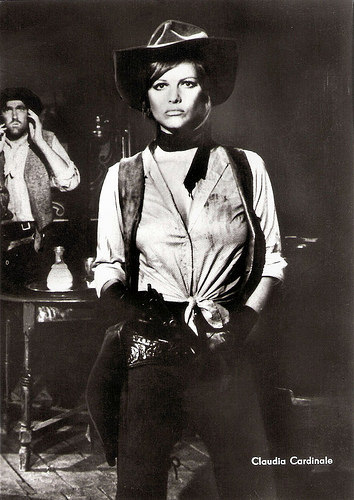
East German postcard by VEB Progress Filmvertrieb, Berlin, no. 154/73. Publicity still for Les pétroleuses / Frenchie King (Christian-Jaque, 1971). The billing of BB vs. CC in this Western didn't live up to expectations.
Strong political convictions
Claudia Cardinale was a liberal with strong political convictions. She was involved in many humanitarian causes, and pro-women and pro-gay issues, and she has frequently stated her pride in her Tunisian and Arab roots - as evidenced by her appearance as herself in the Tunisian film Un été à La Goulette / A Summer at La Goulette (Férid Boughedir, 1996).
She managed to combine her acting work with the role of goodwill ambassador for UNICEF and advocate for the work of Luchino Visconti, with whom she made four films.
She wrote an autobiography, 'Moi Claudia, Toi Claudia' (Me Claudia, You Claudia). In 2005, she also published a French-language book, 'Mes Etoiles' (My Stars), about her personal and professional relationships with many of her directors and co-stars through her over 50 years in show business.
In 2002, she won an honorary Golden Bear award of the Berlin Film Festival, and previously in 1993, she was awarded an honorary Golden Lion at the Venice Film Festival.
Cardinale worked steadily on and in more recent years, she also worked in the theatre. In the cinema, she appeared in the French-Tunisian gay drama Le fil / The String (Mehdi Ben Attia, 2009), the Algerian drama Un balcon sur la mer / A View of Love (Nicole Garcia, 2010), in which she played the mother of Jean Dujardin, and the costume drama Effie Gray (Richard Laxton, 2014) with Dakota Fanning. Claudia Cardinale has made over 135 films since 1956.
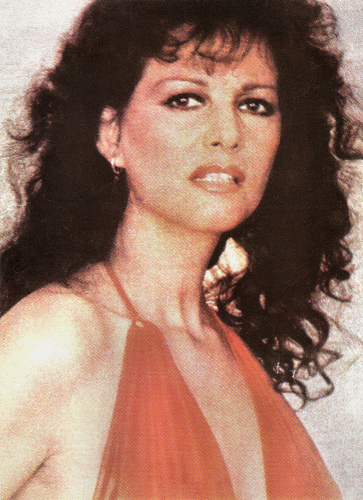
Romanian postcard by Casa Filmului Acin.
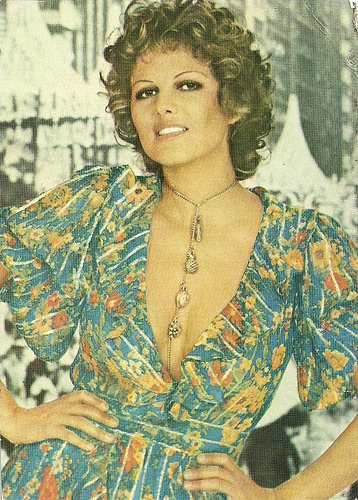
Romanian postcard by Casa Filmului Acin.
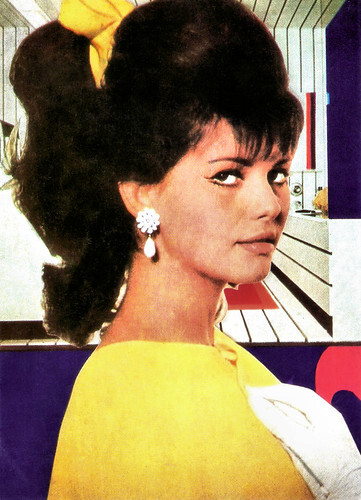
Romanian postcard by Casa Filmului Acin, no. 278.

Romanian postcard by Casa Filmului Acin. Claudia Cardinale and daughter Claudia Squitieri.
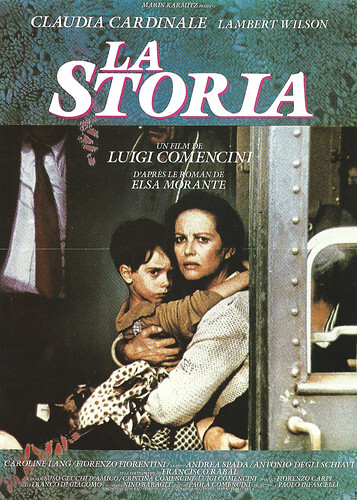
French poster postcard by Eds. F. Nugeron. Design: Yves Prince. Affiche for La Storia (Luigi Comencini, 1986), based on the novel (1974) by Elsa Morante, and starring Claudia Cardinale.
Trailer for Fitzcarraldo (1982). Source: Film Society of Lincoln Center (YouTube).
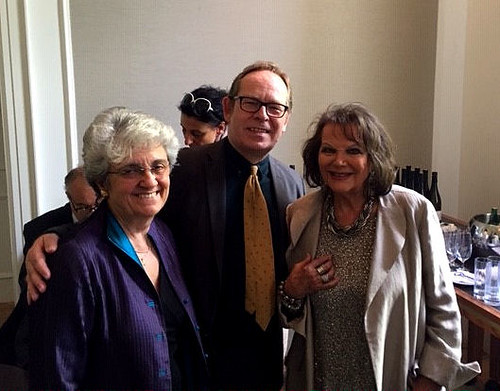
Claudia Cardinale in 2019, with Caterina D'Amico, producer and former president of the Scuola Nazionale del Cinema (Centro Sperimentale di Cinematografia) in Rome, and EFSP's Ivo Blom at the Waldorf Astoria Hotel in Amsterdam.
Sources: Lucia Bozzola (AllMovie - Post now defunct), Steve Rose (The Guardian), and Wikipedia.

French postcard by E.D.U.G., no. 459. Photo: Sam Lévin.

French postcard by E.D.U.G., no. 183. Photo: Sam Lévin.

French postcard by Edition P.I., Paris, no. 1102. Photo: Kasparian. Publicity still for Cartouche (1962).

Spanish postcard by Ediciones Raker, Barcelona. no. 1094. Photo: Claudia Cardinale in The Pink Panther (Blake Edwards, 1963).

Postcard by Moviestar 1961, no. F 73. Photo: Publicity still for Circus World (1964).

Romanian postcard by Casa Filmului Acin. Publicity still for Circus World (Henry Hathaway, 1964) with John Wayne .

Spanish postcard by Postal Oscar Color, no. 567. Holding an announcement for an award for Blindfold (Philip Dunne, 1966).
Pink Panther
In 1963, Claudia Cardinale played the princess who owned the Pink Panther diamond in The Pink Panther (Blake Edwards, 1963), which was filmed in Italy. It was the first in the series of detective comedies starring Peter Sellers as bumbling French Inspector Jacques Clouseau (the mishap-prone snoop was actually a supporting player in his debut).
The film was an enormous success and brought CC to English-speaking audiences. In 1964, she co-starred with John Wayne and Rita Hayworth in her first American production, Circus World (Henry Hathaway, 1964). It was another box-office hit.
The following year, she appeared with Rock Hudson in Blindfold (Philip Dunne, 1966), an offbeat mixture of espionage and slapstick comedy.
The Professionals (Richard Brooks, 1966) is her favourite among her Hollywood films. In this Western, she is a gutsy Mexican woman married against her will to a rich American. The film received Academy Award nominations for Best Direction (Richard Brooks), Best Screenplay (Brooks again), and Best Cinematography (Conrad L. Hall).
Claudia Cardinale continued dividing her time between Hollywood and Europe for the remainder of the decade.

Cover of Progress Film Programm, no. 16/61. Claudia Cardinale in Un maledetto imbroglio / The Facts of Murder (Pietro Germi, 1959), based on Carlo Emilio Gadda's novel 'Quer pasticciaccio brutto de via Merulana' (That Awful Mess on Via Merulana, 1957). Via Merulana is a major street in Rome. The German title of the film was: Was geschah in der Via Merulana?

Cover of Illustrierte Film-Bühne, no. 6442. Claudia Cardinale and Jean-Paul Belmondo during the shooting of La viaccia / The Lovemakers (Mauro Bolognini, 1961). Belmondo wears his outfit from this period film, set in the 1880s. Cardinale wears her modern clothes. The German title of the film was Das Haus in der Via Roma.

Cover Progress Film Programm, no. 109/65. Claudia Cardinale in La ragazza di Bube / Bebo's Girl (Luigi Comencini, 1963). The German title was Bubes Mädchen.

Small Czech collector card by Pressfoto, Praha (Prague), 1965, no. S 101/7. The retail price was Kcs 0,50. Photo: Claudia Cardinale in La ragazza di Bube / Bebo's Girl (Luigi Comencini, 1963). The film was presented at the Karlovy Vary International Film Festival in 1964.

Spanish postcard by Productos Compactos, no. 44526, 1990. Claudia Cardinale and David Niven on a publicity still for The Pink Panther (Blake Edwards, 1963).

West German by Filmbilder-Vertrieb Ernst Freihoff, Essen, no. 890. Photo: Lothar Winkler. Claudia Cardinale in Circus World (Henry Hathaway, 1964).

West German postcard by Kolibri / Friedrich W. Sander Verlag, Minden/Westf, no. 2367. Photo: Schorcht. Claudia Cardinale in Il magnifico cornuto / The Magnificent Cuckold (Antonio Pietrangeli, 1964).
The ultimate Spaghetti Western
Throughout the 1960s, Claudia Cardinale also appeared in some of the best European films. In France, she appeared in the Swashbuckler Cartouche (Philippe de Broca, 1962), featuring Jean-Paul Belmondo.
Back in Italy, she played in I Giorno della civetta / The Day of the Owl (Damiano Damiani, 1968) with Franco Nero , and Nell'anno del Signore / The Conspirators (Luigi Magni, 1969) with Nino Manfredi .
Mesmerising is her performance in Sandra / Vaghe stelle dell'Orsa... (Luchino Visconti, 1965) as a Holocaust survivor with an incestuous relationship with her brother ( Jean Sorel ).
Another highlight in her career is C'era una volta il West / Once Upon a Time in the West (Sergio Leone, 1968), the ultimate Spaghetti Western. Lucia Bozzola writes in her review at AllMovie : "In Sergio Leone's epic Western, shot partly in Monument Valley, a revenge story becomes an epic contemplation of the Western past. (...)
As in his 'Dollars' trilogy, Leone transforms the standard Western plot through the visual impact of widescreen landscapes and the figures therein. At its full length, Once Upon a Time in the West is Leone's operatic masterwork, worthy of its legend-making title."

Vintage still. Claudia Cardinale, Michael Craig and Jean Sorel in Vaghe stelle dell'Orsa / Sandra (Luchino Visconti, 1965).

East German postcard by VEB Progress Filmvertrieb, Berlin, no. 225/69, 1969. Photo: publicity still for Il giorno della civetta / The Day of the Owl (Damiano Damiani, 1968).

East German postcard by VEB Progress Filmvertrieb, Berlin, no. 20/70, 1970. Photo: publicity still for Il giorno della civetta / The Day of the Owl (Damiano Damiani, 1968).

Romanian postcard by Casa Filmului Acin, no. 427. Photo: publicity still for Il giorno della civetta / The Day of the Owl (Damiano Damiani, 1968) with Franco Nero .

German postcard by Krüger, no. 902/47.

German postcard by Krüger, no. 902/115.

Spanish postcard by Postal Oscarcolor, no. 343. With Alain Delon.
International arthouse hit
In the following decades, Claudia Cardinale remained mainly active in European cinema. She played a small part for Visconti in Gruppo di famiglia in un interno / Conversation Piece (Luchino Visconti, 1974) starring Burt Lancaster and Silvana Mangano .
She worked with other major Italian directors at Goodbye e amen (Damiano Damiani, 1977), the TV mini-series Jesus of Nazareth (Franco Zeffirelli, 1977) as the adulteress, and La Pelle / The Skin (Liliana Cavani, 1981) starring Marcello Mastroianni and based on the bitter novel by Curzio Malaparte concerning the Allied liberation of Naples.
An international arthouse hit was Fitzcarraldo (Werner Herzog, 1982), the story of an obsessed impresario ( Klaus Kinski ) whose foremost desire in life is to bring both Enrico Caruso and an opera house to the deepest jungles of South America. In his diary of the making of Fitzcarraldo, Werner Herzog writes: "Claudia Cardinale is a great help because she is such a good sport, a real trouper, and has a special radiance before the camera. In her presence, [ Klaus Kinski ] usually acts like a gentleman."
Other interesting films include the Luigi Pirandello adaptation Enrico IV / Henry IV (Marco Bellocchio, 1984) with Marcello Mastroianni , the epic La révolution française / The French Revolution (Robert Enrico, Richard T. Heffron, 1989), the nostalgic drama Mayrig / Mother (Henri Verneuil, 1991), and the romantic thriller And now... Ladies and Gentlemen (Claude Lelouch, 2002) starring Jeremy Irons .
On Television, she gave another well-received performance in the TV drama La storia / History (Luigi Comencini, 1986), in which she plays a widow raising a son during World War II.

French postcard by E.D.U.G., no. 229. Photo: Sam Lévin.

German postcard in the Kolibri Foto-Karte series by Friedrich W. Sander-Verlag, Minden-Westf., no. 2515. Photo: Universal International. Publicity still for The Hell with Heroes (Joseph Sargent, 1968). Collection: Daniël van der Aa.

Italian postcard by Cineteca Bologna for the exhibition Un Altro West (2008). Photo: A. Novi. Sergio Leone and Claudia Cardinale on the set of C'era una volta il West / Once Upon a Time in the West (Sergio Leone, 1968).

Italian postcard by Cineteca Bologna, 2007. Photo: A. Novi / Cineteca di Bologna. Claudia Cardinale in C'era una volta il West / Once Upon a Time in the West (Sergio Leone, 1968).

Italian postcard by Cineteca Bologna, 2007. Photo: A. Novi / Cineteca di Bologna. Claudia Cardinale in C'era una volta il West / Once Upon a Time in the West (Sergio Leone, 1968).

Italian postcard by Gruppo Editoriale Lo Vecchio, Genova, in the Alberto Sordi series. Photo: publicity still for Bello, onesto, emigrato in Australia sposerebbe compaesana illibata / A Girl in Australia (Luigi Zampa, 1971) with Alberto Sordi.

East German postcard by VEB Progress Filmvertrieb, Berlin, no. 154/73. Publicity still for Les pétroleuses / Frenchie King (Christian-Jaque, 1971). The billing of BB vs. CC in this Western didn't live up to expectations.
Strong political convictions
Claudia Cardinale was a liberal with strong political convictions. She was involved in many humanitarian causes, and pro-women and pro-gay issues, and she has frequently stated her pride in her Tunisian and Arab roots - as evidenced by her appearance as herself in the Tunisian film Un été à La Goulette / A Summer at La Goulette (Férid Boughedir, 1996).
She managed to combine her acting work with the role of goodwill ambassador for UNICEF and advocate for the work of Luchino Visconti, with whom she made four films.
She wrote an autobiography, 'Moi Claudia, Toi Claudia' (Me Claudia, You Claudia). In 2005, she also published a French-language book, 'Mes Etoiles' (My Stars), about her personal and professional relationships with many of her directors and co-stars through her over 50 years in show business.
In 2002, she won an honorary Golden Bear award of the Berlin Film Festival, and previously in 1993, she was awarded an honorary Golden Lion at the Venice Film Festival.
Cardinale worked steadily on and in more recent years, she also worked in the theatre. In the cinema, she appeared in the French-Tunisian gay drama Le fil / The String (Mehdi Ben Attia, 2009), the Algerian drama Un balcon sur la mer / A View of Love (Nicole Garcia, 2010), in which she played the mother of Jean Dujardin, and the costume drama Effie Gray (Richard Laxton, 2014) with Dakota Fanning. Claudia Cardinale has made over 135 films since 1956.

Romanian postcard by Casa Filmului Acin.

Romanian postcard by Casa Filmului Acin.

Romanian postcard by Casa Filmului Acin, no. 278.

Romanian postcard by Casa Filmului Acin. Claudia Cardinale and daughter Claudia Squitieri.

French poster postcard by Eds. F. Nugeron. Design: Yves Prince. Affiche for La Storia (Luigi Comencini, 1986), based on the novel (1974) by Elsa Morante, and starring Claudia Cardinale.
Trailer for Fitzcarraldo (1982). Source: Film Society of Lincoln Center (YouTube).

Claudia Cardinale in 2019, with Caterina D'Amico, producer and former president of the Scuola Nazionale del Cinema (Centro Sperimentale di Cinematografia) in Rome, and EFSP's Ivo Blom at the Waldorf Astoria Hotel in Amsterdam.
Sources: Lucia Bozzola (AllMovie - Post now defunct), Steve Rose (The Guardian), and Wikipedia.
Published on September 25, 2025 22:00
September 24, 2025
Claudia Cardinale (1938-2025) - Part 1
One of Europe's iconic and most versatile film stars, Italian actress Claudia Cardinale (1938-2025), died last Tuesday. The combination of her beauty, dark, flashing eyes, explosive sexuality and genuine acting talent virtually guaranteed her stardom. Her most notable films include the classics 8½ (Federico Fellini, 1963), Il Gattopardo (Luchino Visconti, 1963), and Once Upon a Time in the West (Sergio Leone, 1968). One post is not enough to commemorate La CC. Tomorrow follows Part 2.

French postcard by E.D.U.G., no. 316. Photo: Sam Lévin.
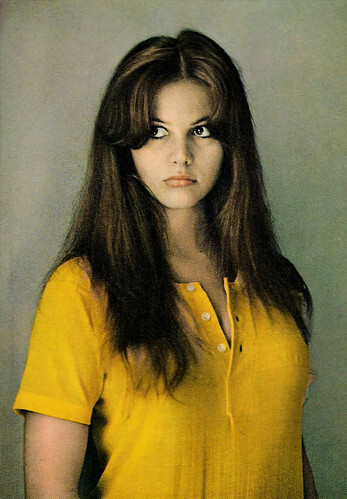
Italian postcard by Rotalfoto (Rotalcolor), Milano, no. N. 203.
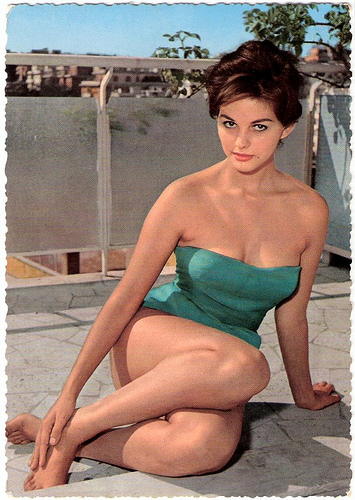
German postcard by Krüger, no. 902/164. Photo: Georg Michalke / UFA.
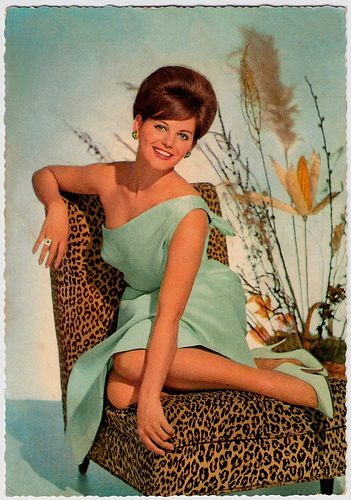
German postcard by Krüger, no. 902/132. Photo: Sam Levin / Ufa.
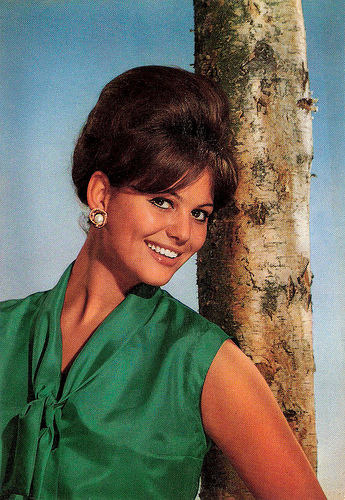
French postcard by E.D.U.G., no. 243, offered by Les Carbones Korès Carboplane. Photo: Sam Lévin.
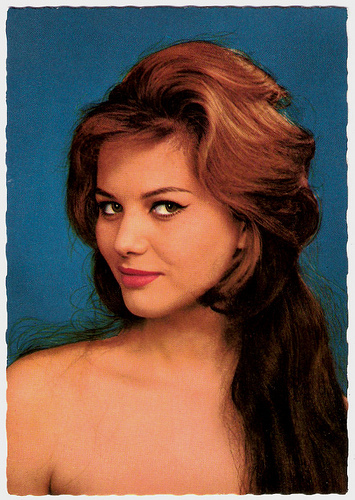
German postcard by Filmbilder-Vertrieb Ernst Freihoff, Essen, no. H 72.
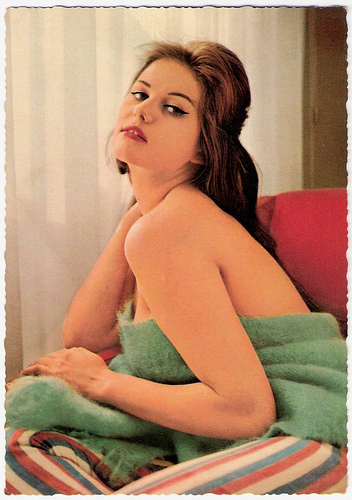
German postcard by Krüger, no. 902/115.
The most beautiful Italian girl in Tunisia
Claude Joséphine Rose Cardinale was born in La Goulette in Tunisia in 1938 (some sources claim 1939). Her mother, Yolande Greco, was born in Tunisia to Italian (Sicilian) emigrants from Trapani, Italy. Her father was an Italian (Sicilian) railway worker, born in Gela, Italy.
Her native languages were Tunisian Arabic and French. She received a French education, and she had to learn Italian once she pursued her acting career.
She had her breakthrough in films after she was voted the most beautiful Italian girl in Tunisia in 1957. The contest of the Italian embassy had as a prize a trip to the Venice Film Festival. She made her film debut in the French-Tunisian coproduction Goha (Jacques Baratier, 1958), starring Omar Sharif.
After attending the Centro Sperimentale di Cinematografia in Rome for two months, she signed a 7-year contract with the Vides studios. The contract forbade her to cut her hair, to marry or to gain weight.
Later that year, she had a role in the heist comedy I soliti ignoti / Big Deal On Madonna Street (Mario Monicelli, 1958) with Vittorio Gassman and Renato Salvatori . The film was an international success, and her film career was off and running.
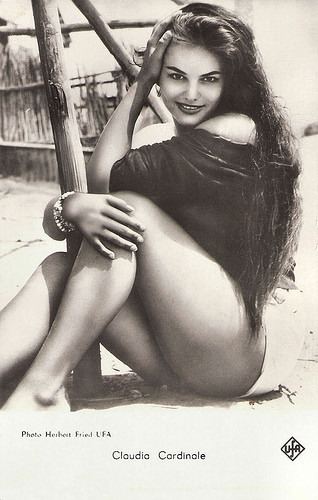
French postcard by Editions P.I., no. FK 104. Photo: Herbert Fried / Ufa.
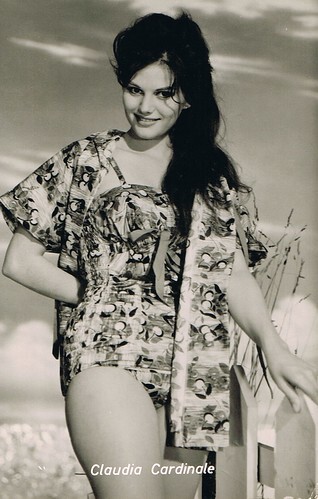
German postcard by Kolibri-Verlag. Collection: Meiter.
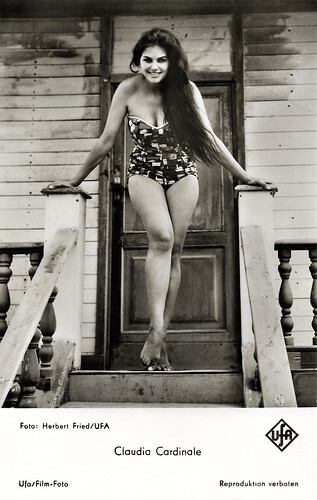
West German postcard by Ufa/Film-Foto, Berlin-Tempelhof, no. FK 5143. Photo: Herbert Fried / Ufa.
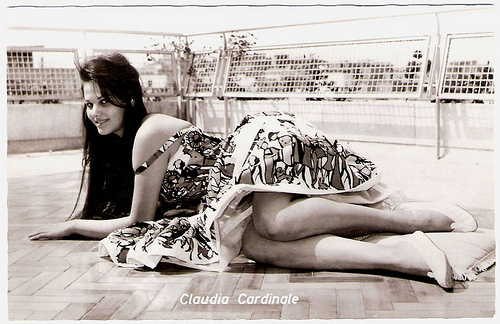
German postcard by Kolibri (W. Sander Verlag, Minden), no. 1865.
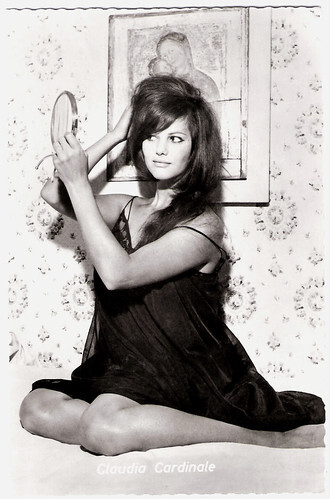
German postcard by Kolibri (W. Sander Verlag, Minden), no. 1968.

Dutch postcard.
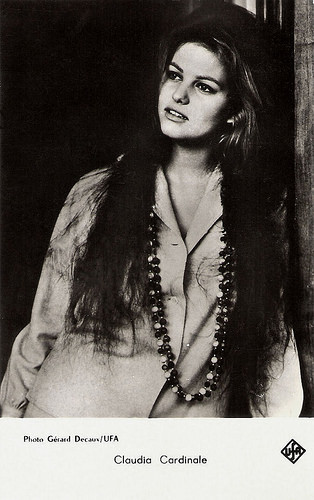
French postcard by Editions P.I., Paris, French licence holder for Ufa, presented by Les Carbones Korès 'Carboplane', no. FK 99 B. Photo: Gérard Décaux / Ufa.
After BB Comes CC
At this point, the press, noting her initials, announced that CC was the natural successor to BB ( Brigitte Bardot ), and began beating the drum on her behalf.
Dozens of alluring photographs of Claudia Cardinale were displayed in newspapers and magazines throughout the world. According to IMDb , she has appeared on more than 900 magazine covers in over 25 countries.
The contrast between these pictures and those of Marilyn Monroe or Jayne Mansfield is striking. Cardinale never appeared in a nude or fully topless scene. Her pictures promoted an image of a shy family girl who just happened to have a beautiful face and a sexy body.
A photograph of Cardinale was featured in the original gatefold artwork to Bob Dylan's album 'Blonde on Blonde' (1966), but because it was used without Cardinale's permission, the photo was removed from the cover art in later pressings.

East German postcard by VEB Progress Filmvertrieb, Berlin, no. 2949, 1967.
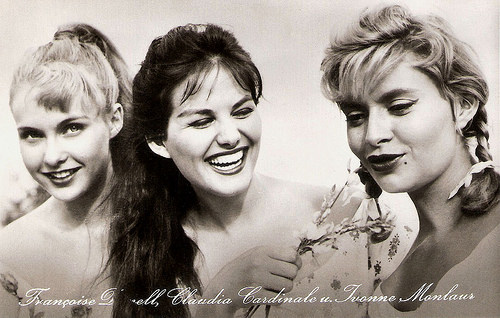
East German postcard by VEB Progress Filmvertrieb, no. 1187, 1960. Publicity still for Tre straniere a Roma / Three Strangers in Rome (Claudio Gora, 1958) with Yvonne Monlaur and Françoise Darnell.
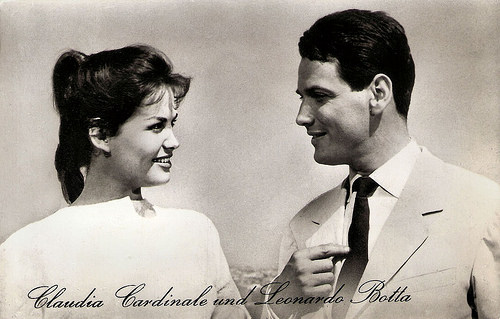
East German postcard by VEB Progress Filmvertrieb. Publicity still for Tre straniere a Roma/Three Strangers in Rome (Claudio Gora, 1958) with Leonardo Botta.
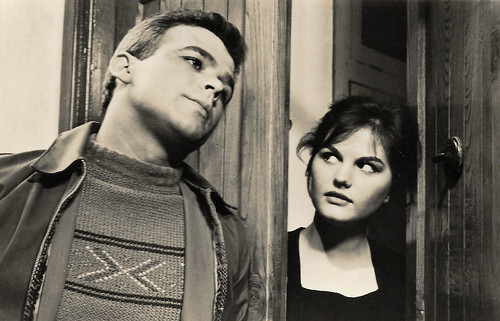
Small Czech collectors card by Pressfoto, Praha (Prague), 1965, no. S 101/3. Photo: Claudia Cardinale and Renato Salvatori in Audace colpo dei soliti ignoti / Fiasco in Milan (Nanni Loy, 1959).
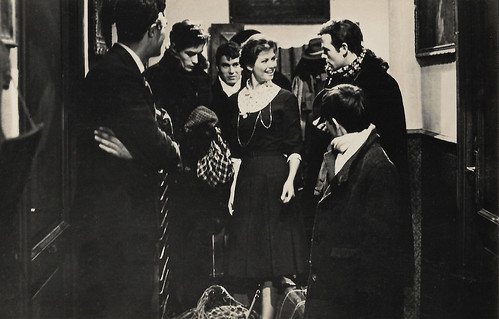
Small Czech collectors card by Pressfoto, Praha (Prague), 1965, no. S 101/5. Photo: Claudia Cardinale , Alain Delon , Max Cartier and Renato Salvatori in Rocco e i suoi fratelli/Rocco and His Brothers (Luchino Visconti, 1960).
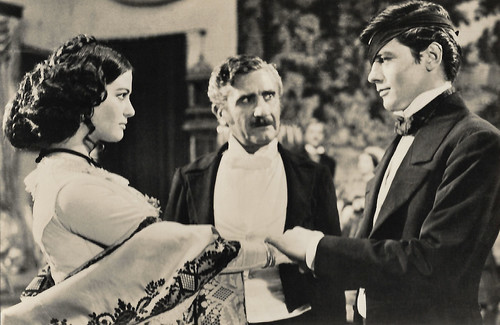
Small Czech collectors card by Pressfoto, Praha (Prague), 1965, no. S 101/6. Photo: G.B. Poletto. Claudia Cardinale , Paolo Stoppa and Alain Delon in Il gattopardo/The Leopard (Luchino Visconti, 1963).
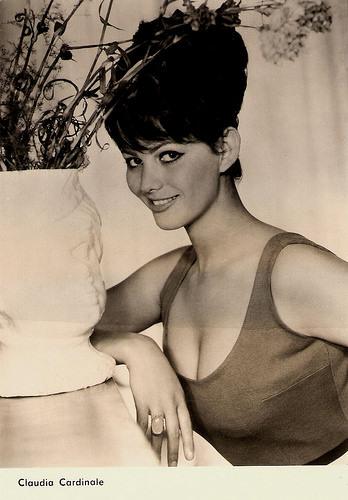
East German postcard by VEB Progress Filmvertrieb, Berlin, no. 2569, 1965.
Manager-producer-husband
Claudia Cardinale's early career was largely managed by producer Franco Cristaldi. Because of her film contract, she told everyone that her son Patrizio was her baby brother. He was born out of wedlock when she was 17. The father was a mysterious Frenchman. She did not reveal to the child that he was her son until he was 19 years old. In 1966, she married Cristaldi, who adopted Patrizio.
In only three years, she made a stream of great films. First, she made three successful comedies, Un Maledetto imbroglio / The Facts of Murder (Pietro Germi, 1959), Il Bell'Antonio / Bell'Antonio (Mauro Bolognini, 1960) featuring Marcello Mastroianni , and Audace colpo dei soliti ignoti / Fiasco in Milan (Nanni Loy, 1960).
Cardinale had a supporting part in the epic drama Rocco e i suoi fratelli / Rocco and His Brothers (Luchino Visconti, 1960) in which she played the sister-in-law of Alain Delon and Renato Salvatori.
And then followed leading parts in La Ragazza con la valigia / Girl with a Suitcase (Valerio Zurlini, 1961), La Viaccia / The Lovemakers (Mauro Bolognini, 1961) with Jean-Paul Belmondo , and Senilità / Careless (Mauro Bolognini, 1961).
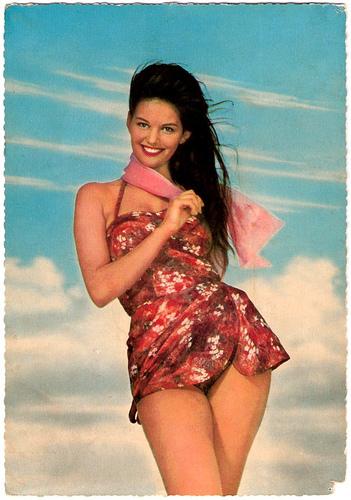
German postcard by Krüger.
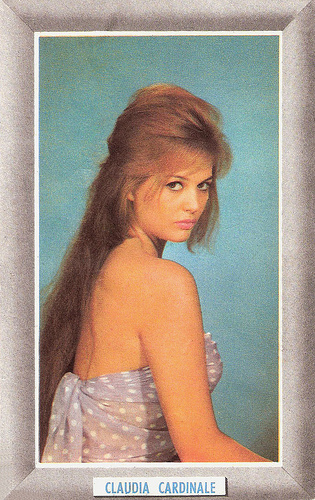
French postcard.
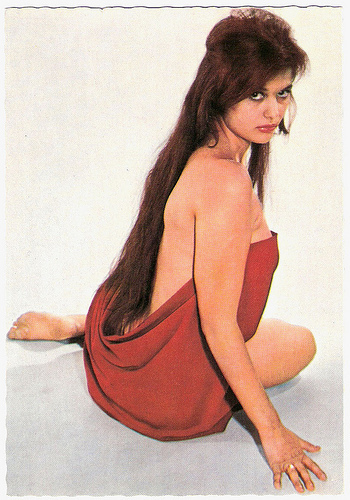
German postcard by ISV, Sort. 10/6.
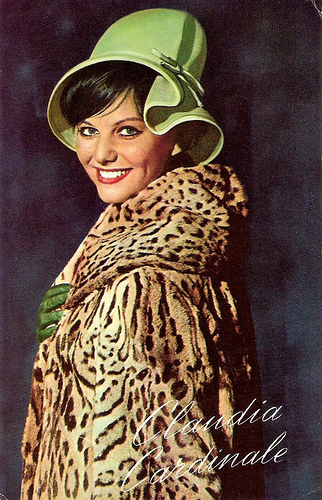
Dutch postcard, Serie 6.
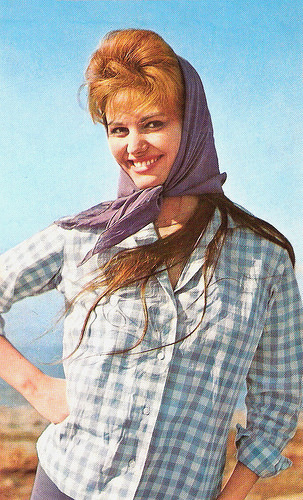
French postcard by Editions P.I., Paris, no. 1084, offered by Corvisart, Epinal. Photo: Ektachrome Anders.
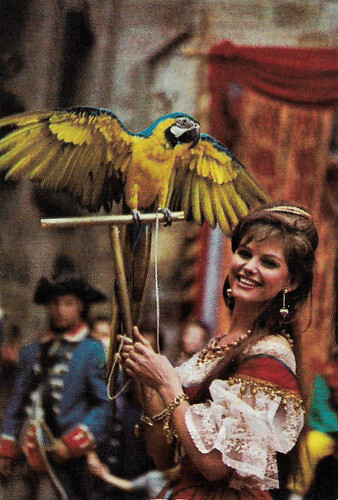
Belgian collector card no. 25 (of 26). Claudia Cardinale in Cartouche (Philippe de Broca, 1962).
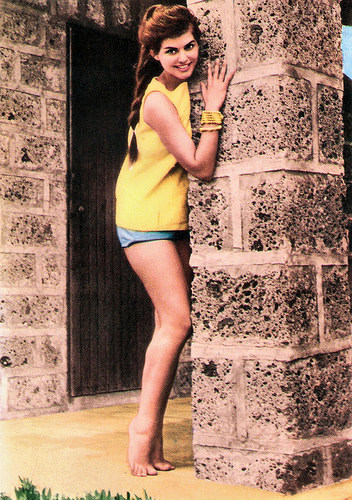
Spanish postcard by Postal Oscar Color, Hospitalet (Barcelona), no. 521, 1963.
Deep voice and heavy accent
Claudia Cardinale had a deep, sultry voice and spoke Italian with a heavy French accent, so her voice was dubbed in her early films.
In Federico Fellini 's 8½ (1963), she was finally allowed to dub her own dialogue. In the film, she plays a dream woman - a character named Claudia, who is the object of the fantasies of the director in the film, played by Marcello Mastroianni . With Fellini's surrealistic masterpiece, she received her widest exposure to date.
That same year, she also appeared in another masterpiece of Italian cinema, the epic Il Gattopardo / The Leopard (Luchino Visconti, 1963) with Burt Lancaster and Alain Delon .
The combined success of these two classic films made her rise to the front ranks of Italian cinema. And it also piqued Hollywood's interest...
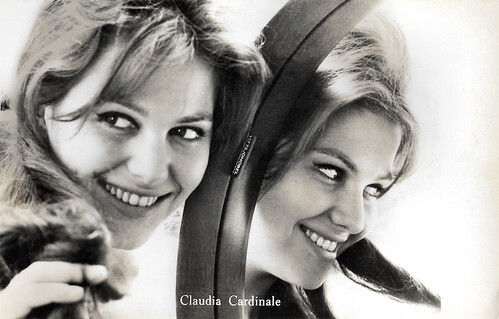
Dutch postcard by Hercules, Haarlem, no. 262.

German postcard by Rüdel Verlag, no. 3561. Photo: PALLAS / Vogelmann. Claudia Cardinale in Cartouche (Philippe de Broca, 1962). Collection: Marlene Pilaete.
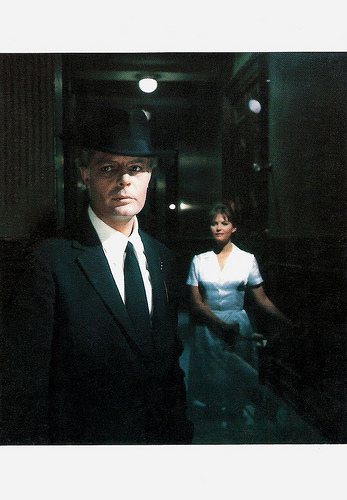
French postcard by Edition La Malibran, Paris, no. MC 38, 1990. Photo: Claude Schwartz. Publicity still for Otto e Mezzo / 8½ (Federico Fellini, 1963) with Marcello Mastroianni .
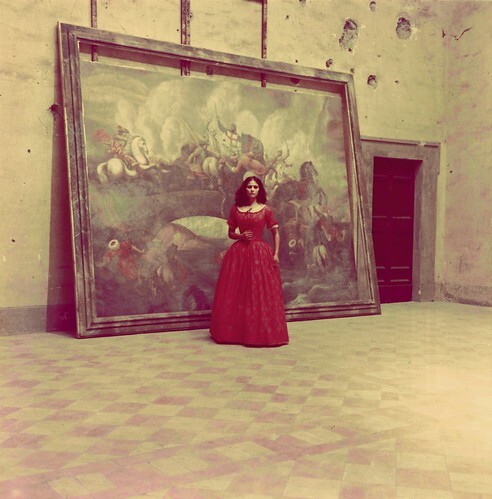
Original film still. Photo: G. B. Poletto. Claudia Cardinale in Il Gattopardo / The Leopard (Luchino Visconti, 1963).
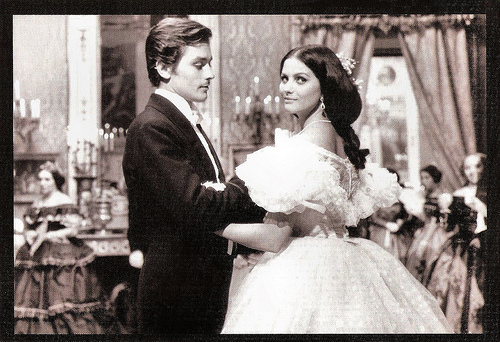
Vintage card. Photo: publicity still for Il Gattopardo / The Leopard (Luchino Visconti, 1963) with Alain Delon .
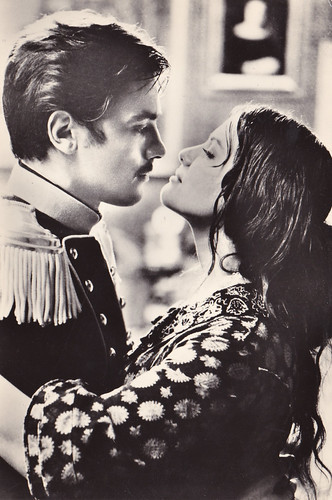
Czech postcard by Pressfoto, Praha (Prague). Photo: G.B. Poletto. Alain Delon and Claudia Cardinale in Il Gattopardo / The Leopard (Luchino Visconti, 1963). Collection: Carla Bosch.
Original Italian trailer of 8½ (1963). Source: Raúl Quintanilla (YouTube).
Original Italian trailer of Il Gattopardo / The Leopard (1963). Source: Blondinka Inoz (YouTube).
Sources: Jason Ankeny (AllMovie - Page now defunct), Roger Fristoe (TCM - now defunct), and Wikipedia.
To be continued tomorrow.

French postcard by E.D.U.G., no. 316. Photo: Sam Lévin.

Italian postcard by Rotalfoto (Rotalcolor), Milano, no. N. 203.

German postcard by Krüger, no. 902/164. Photo: Georg Michalke / UFA.

German postcard by Krüger, no. 902/132. Photo: Sam Levin / Ufa.

French postcard by E.D.U.G., no. 243, offered by Les Carbones Korès Carboplane. Photo: Sam Lévin.

German postcard by Filmbilder-Vertrieb Ernst Freihoff, Essen, no. H 72.

German postcard by Krüger, no. 902/115.
The most beautiful Italian girl in Tunisia
Claude Joséphine Rose Cardinale was born in La Goulette in Tunisia in 1938 (some sources claim 1939). Her mother, Yolande Greco, was born in Tunisia to Italian (Sicilian) emigrants from Trapani, Italy. Her father was an Italian (Sicilian) railway worker, born in Gela, Italy.
Her native languages were Tunisian Arabic and French. She received a French education, and she had to learn Italian once she pursued her acting career.
She had her breakthrough in films after she was voted the most beautiful Italian girl in Tunisia in 1957. The contest of the Italian embassy had as a prize a trip to the Venice Film Festival. She made her film debut in the French-Tunisian coproduction Goha (Jacques Baratier, 1958), starring Omar Sharif.
After attending the Centro Sperimentale di Cinematografia in Rome for two months, she signed a 7-year contract with the Vides studios. The contract forbade her to cut her hair, to marry or to gain weight.
Later that year, she had a role in the heist comedy I soliti ignoti / Big Deal On Madonna Street (Mario Monicelli, 1958) with Vittorio Gassman and Renato Salvatori . The film was an international success, and her film career was off and running.

French postcard by Editions P.I., no. FK 104. Photo: Herbert Fried / Ufa.

German postcard by Kolibri-Verlag. Collection: Meiter.

West German postcard by Ufa/Film-Foto, Berlin-Tempelhof, no. FK 5143. Photo: Herbert Fried / Ufa.

German postcard by Kolibri (W. Sander Verlag, Minden), no. 1865.

German postcard by Kolibri (W. Sander Verlag, Minden), no. 1968.

Dutch postcard.

French postcard by Editions P.I., Paris, French licence holder for Ufa, presented by Les Carbones Korès 'Carboplane', no. FK 99 B. Photo: Gérard Décaux / Ufa.
After BB Comes CC
At this point, the press, noting her initials, announced that CC was the natural successor to BB ( Brigitte Bardot ), and began beating the drum on her behalf.
Dozens of alluring photographs of Claudia Cardinale were displayed in newspapers and magazines throughout the world. According to IMDb , she has appeared on more than 900 magazine covers in over 25 countries.
The contrast between these pictures and those of Marilyn Monroe or Jayne Mansfield is striking. Cardinale never appeared in a nude or fully topless scene. Her pictures promoted an image of a shy family girl who just happened to have a beautiful face and a sexy body.
A photograph of Cardinale was featured in the original gatefold artwork to Bob Dylan's album 'Blonde on Blonde' (1966), but because it was used without Cardinale's permission, the photo was removed from the cover art in later pressings.

East German postcard by VEB Progress Filmvertrieb, Berlin, no. 2949, 1967.

East German postcard by VEB Progress Filmvertrieb, no. 1187, 1960. Publicity still for Tre straniere a Roma / Three Strangers in Rome (Claudio Gora, 1958) with Yvonne Monlaur and Françoise Darnell.

East German postcard by VEB Progress Filmvertrieb. Publicity still for Tre straniere a Roma/Three Strangers in Rome (Claudio Gora, 1958) with Leonardo Botta.

Small Czech collectors card by Pressfoto, Praha (Prague), 1965, no. S 101/3. Photo: Claudia Cardinale and Renato Salvatori in Audace colpo dei soliti ignoti / Fiasco in Milan (Nanni Loy, 1959).

Small Czech collectors card by Pressfoto, Praha (Prague), 1965, no. S 101/5. Photo: Claudia Cardinale , Alain Delon , Max Cartier and Renato Salvatori in Rocco e i suoi fratelli/Rocco and His Brothers (Luchino Visconti, 1960).

Small Czech collectors card by Pressfoto, Praha (Prague), 1965, no. S 101/6. Photo: G.B. Poletto. Claudia Cardinale , Paolo Stoppa and Alain Delon in Il gattopardo/The Leopard (Luchino Visconti, 1963).

East German postcard by VEB Progress Filmvertrieb, Berlin, no. 2569, 1965.
Manager-producer-husband
Claudia Cardinale's early career was largely managed by producer Franco Cristaldi. Because of her film contract, she told everyone that her son Patrizio was her baby brother. He was born out of wedlock when she was 17. The father was a mysterious Frenchman. She did not reveal to the child that he was her son until he was 19 years old. In 1966, she married Cristaldi, who adopted Patrizio.
In only three years, she made a stream of great films. First, she made three successful comedies, Un Maledetto imbroglio / The Facts of Murder (Pietro Germi, 1959), Il Bell'Antonio / Bell'Antonio (Mauro Bolognini, 1960) featuring Marcello Mastroianni , and Audace colpo dei soliti ignoti / Fiasco in Milan (Nanni Loy, 1960).
Cardinale had a supporting part in the epic drama Rocco e i suoi fratelli / Rocco and His Brothers (Luchino Visconti, 1960) in which she played the sister-in-law of Alain Delon and Renato Salvatori.
And then followed leading parts in La Ragazza con la valigia / Girl with a Suitcase (Valerio Zurlini, 1961), La Viaccia / The Lovemakers (Mauro Bolognini, 1961) with Jean-Paul Belmondo , and Senilità / Careless (Mauro Bolognini, 1961).

German postcard by Krüger.

French postcard.

German postcard by ISV, Sort. 10/6.

Dutch postcard, Serie 6.

French postcard by Editions P.I., Paris, no. 1084, offered by Corvisart, Epinal. Photo: Ektachrome Anders.

Belgian collector card no. 25 (of 26). Claudia Cardinale in Cartouche (Philippe de Broca, 1962).

Spanish postcard by Postal Oscar Color, Hospitalet (Barcelona), no. 521, 1963.
Deep voice and heavy accent
Claudia Cardinale had a deep, sultry voice and spoke Italian with a heavy French accent, so her voice was dubbed in her early films.
In Federico Fellini 's 8½ (1963), she was finally allowed to dub her own dialogue. In the film, she plays a dream woman - a character named Claudia, who is the object of the fantasies of the director in the film, played by Marcello Mastroianni . With Fellini's surrealistic masterpiece, she received her widest exposure to date.
That same year, she also appeared in another masterpiece of Italian cinema, the epic Il Gattopardo / The Leopard (Luchino Visconti, 1963) with Burt Lancaster and Alain Delon .
The combined success of these two classic films made her rise to the front ranks of Italian cinema. And it also piqued Hollywood's interest...

Dutch postcard by Hercules, Haarlem, no. 262.

German postcard by Rüdel Verlag, no. 3561. Photo: PALLAS / Vogelmann. Claudia Cardinale in Cartouche (Philippe de Broca, 1962). Collection: Marlene Pilaete.

French postcard by Edition La Malibran, Paris, no. MC 38, 1990. Photo: Claude Schwartz. Publicity still for Otto e Mezzo / 8½ (Federico Fellini, 1963) with Marcello Mastroianni .

Original film still. Photo: G. B. Poletto. Claudia Cardinale in Il Gattopardo / The Leopard (Luchino Visconti, 1963).

Vintage card. Photo: publicity still for Il Gattopardo / The Leopard (Luchino Visconti, 1963) with Alain Delon .

Czech postcard by Pressfoto, Praha (Prague). Photo: G.B. Poletto. Alain Delon and Claudia Cardinale in Il Gattopardo / The Leopard (Luchino Visconti, 1963). Collection: Carla Bosch.
Original Italian trailer of 8½ (1963). Source: Raúl Quintanilla (YouTube).
Original Italian trailer of Il Gattopardo / The Leopard (1963). Source: Blondinka Inoz (YouTube).
Sources: Jason Ankeny (AllMovie - Page now defunct), Roger Fristoe (TCM - now defunct), and Wikipedia.
To be continued tomorrow.
Published on September 24, 2025 22:00
September 23, 2025
Ralph Bellamy
American actor Ralph Bellamy (1904 -1991) was best known for his work in screwball comedies and dramatic stage productions. He never became a major star, but he made a career out of playing second leads in major productions before developing into a character actor.

British postcard, no. 169. Photo: Universal Films.
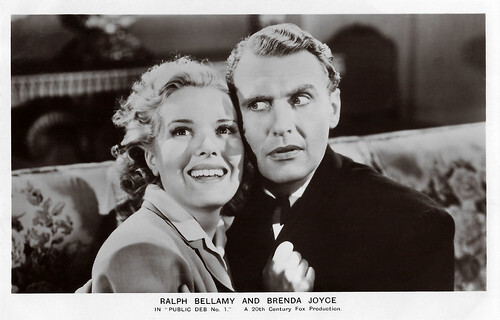
British postcard in the Film Partners Series, London, no. P322. Photo: 20th Century Fox. Ralph Bellamy and Brenda Joyce in Public Deb No. 1 (Gregory Ratoff, 1940).
A master of sophisticated comedy
Ralph Rexford Bellamy was born in 1904 in Chicago, Illinois, and grew up in the Chicago suburb of Winnetka. Ralph was the son of Lilla Louise (Smith) and Charles Rexford Bellamy.
He began his involvement with theatre as a teen. He attended New Trier High School in Winnetka and was president of the Drama Club there. Ralph ran away from home at age 17 to join a travelling band of Shakespearean players. In 1922, he formed his own troupe of actors, the North Shore Players, in the Chicago area.
Later, he performed in repertory, in touring companies, and in multiple roles with his repertory troupe, the Ralph Bellamy Players (1926–1929), which he formed in Des Moines, Iowa. He appeared in two unsuccessful Broadway plays in 1929 and 1930, but this was enough to secure him a film contract in 1930. Overall, he spent nine years in repertory and touring companies, playing over 400 roles, including an average of two or three in each play.
Bellamy’s first film role was as a gangster in the crime picture The Secret 6 (George W. Hill, 1931) starring Wallace Beery . In dozens of films over the coming years, he became a master of sophisticated comedy, often cast as a sympathetic yet naive character who loses the girl to the leading man. Typical films from this period included Hands Across the Table (Mitchell Leisen, 1935), in which he lost Carole Lombard to Fred MacMurray .
Bellamy drew particular praise for The Awful Truth (Leo McCarey, 1937), in which he appeared as an oil baron whom Irene Dunne toys with before returning to Cary Grant . For his performance, Bellamy received his first and only Academy Award nomination. After losing Ginger Rogers to Fred Astaire in Carefree (Mark Sandrich, 1938), he again was bested by Grant in His Girl Friday (Howard Hawks, 1940) with Rosalind Russell . Bellamy also starred as the wealthy detective in four Ellery Queen mystery movies. He also appeared in the Horror films The Wolf Man (George Waggner, 1941) with Lon Chaney Jr. and The Ghost of Frankenstein (Erle C. Kenton, 1942) with Chaney and Bela Lugosi .
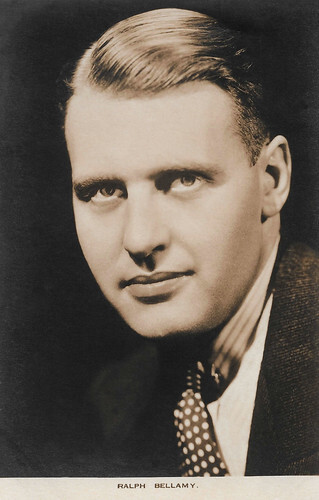
British postcard in the Film Weekly Series, London.
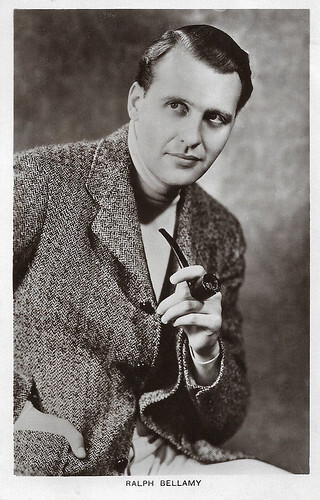
British postcard in the Picturegoer Series, London, no. 683.
A brilliant, emotionally charged portrayal of Franklin D. Roosevelt
By the 1940s, Ralph Bellamy had come to favour acting on Broadway and in 1943 secured his stage reputation as an antifascist professor in 'Tomorrow the World'. He also had a successful run (1945–1947) as the star of the comedy 'State of the Union'. He achieved his greatest acclaim on Broadway with his dramatic, emotionally charged portrayal of Franklin D. Roosevelt as he battled polio in Dore Schary's play 'Sunrise at Campobello' (1958), for which he won a Tony Award.
He reprised his brilliant portrayal of Roosevelt in the film version Sunrise at Campobello (Vincent J. Donehue, 1960) with Greer Garson as Eleanor Roosevelt and again in 1983 for the television miniseries The Winds of War (Dan Curtis, 1983). He also appeared in numerous anthology television shows during the 1950s.
Bellamy later played the satanic doctor in the Horror classic Rosemary’s Baby (Roman Polanski, 1968), and he won a new generation of fans with his performance as one of the wealthy Duke brothers, the other being Don Ameche , in Trading Places (John Landis, 1983), starring Eddie Murphy and Dan Aykroyd .
His last performance was in Pretty Woman (Garry Marshall, 1990) starring Julia Roberts and Richard Gere . Bellamy made more than 100 films during his career, and he also served as president of Actors’ Equity (1952–1964) and was a founder and board member of the Screen Actors Guild. He wrote an autobiography, 'When the Smoke Hit the Fan' (1979), and received an honorary Academy Award in 1987 for the body of his film work.
Ralph Bellamy died in 1991 in Santa Monica, California. He was 87 years old. He was interred at Forest Lawn Memorial Park (Hollywood Hills) in Los Angeles, California. Bellamy was married four times: first to Alice Delbridge (1927–1930), then to Catherine Willard (1931–1945), and to organist Ethel Smith (1945–1947). Bellamy's fourth wife was Alice Murphy (1949–1991; his death). The actor had two children: Lynn Bellamy and Willard Bellamy.
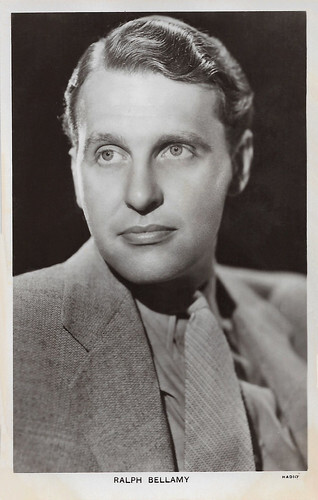
British postcard in the Picturegoer Series, London, no. 683a. Photo: Radio.
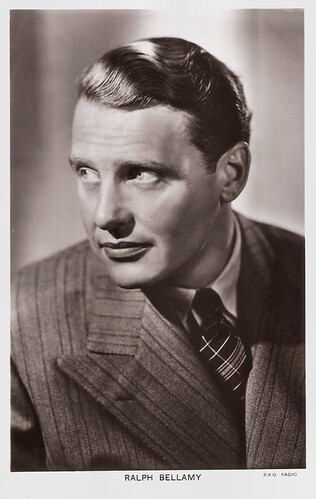
British postcard in the Picturegoer Series, London, no. 683b. Photo: R.K.O. Radio.
Sources: (IMDb), Encyclopaedia Britannica, Wikipedia and .

British postcard, no. 169. Photo: Universal Films.

British postcard in the Film Partners Series, London, no. P322. Photo: 20th Century Fox. Ralph Bellamy and Brenda Joyce in Public Deb No. 1 (Gregory Ratoff, 1940).
A master of sophisticated comedy
Ralph Rexford Bellamy was born in 1904 in Chicago, Illinois, and grew up in the Chicago suburb of Winnetka. Ralph was the son of Lilla Louise (Smith) and Charles Rexford Bellamy.
He began his involvement with theatre as a teen. He attended New Trier High School in Winnetka and was president of the Drama Club there. Ralph ran away from home at age 17 to join a travelling band of Shakespearean players. In 1922, he formed his own troupe of actors, the North Shore Players, in the Chicago area.
Later, he performed in repertory, in touring companies, and in multiple roles with his repertory troupe, the Ralph Bellamy Players (1926–1929), which he formed in Des Moines, Iowa. He appeared in two unsuccessful Broadway plays in 1929 and 1930, but this was enough to secure him a film contract in 1930. Overall, he spent nine years in repertory and touring companies, playing over 400 roles, including an average of two or three in each play.
Bellamy’s first film role was as a gangster in the crime picture The Secret 6 (George W. Hill, 1931) starring Wallace Beery . In dozens of films over the coming years, he became a master of sophisticated comedy, often cast as a sympathetic yet naive character who loses the girl to the leading man. Typical films from this period included Hands Across the Table (Mitchell Leisen, 1935), in which he lost Carole Lombard to Fred MacMurray .
Bellamy drew particular praise for The Awful Truth (Leo McCarey, 1937), in which he appeared as an oil baron whom Irene Dunne toys with before returning to Cary Grant . For his performance, Bellamy received his first and only Academy Award nomination. After losing Ginger Rogers to Fred Astaire in Carefree (Mark Sandrich, 1938), he again was bested by Grant in His Girl Friday (Howard Hawks, 1940) with Rosalind Russell . Bellamy also starred as the wealthy detective in four Ellery Queen mystery movies. He also appeared in the Horror films The Wolf Man (George Waggner, 1941) with Lon Chaney Jr. and The Ghost of Frankenstein (Erle C. Kenton, 1942) with Chaney and Bela Lugosi .

British postcard in the Film Weekly Series, London.

British postcard in the Picturegoer Series, London, no. 683.
A brilliant, emotionally charged portrayal of Franklin D. Roosevelt
By the 1940s, Ralph Bellamy had come to favour acting on Broadway and in 1943 secured his stage reputation as an antifascist professor in 'Tomorrow the World'. He also had a successful run (1945–1947) as the star of the comedy 'State of the Union'. He achieved his greatest acclaim on Broadway with his dramatic, emotionally charged portrayal of Franklin D. Roosevelt as he battled polio in Dore Schary's play 'Sunrise at Campobello' (1958), for which he won a Tony Award.
He reprised his brilliant portrayal of Roosevelt in the film version Sunrise at Campobello (Vincent J. Donehue, 1960) with Greer Garson as Eleanor Roosevelt and again in 1983 for the television miniseries The Winds of War (Dan Curtis, 1983). He also appeared in numerous anthology television shows during the 1950s.
Bellamy later played the satanic doctor in the Horror classic Rosemary’s Baby (Roman Polanski, 1968), and he won a new generation of fans with his performance as one of the wealthy Duke brothers, the other being Don Ameche , in Trading Places (John Landis, 1983), starring Eddie Murphy and Dan Aykroyd .
His last performance was in Pretty Woman (Garry Marshall, 1990) starring Julia Roberts and Richard Gere . Bellamy made more than 100 films during his career, and he also served as president of Actors’ Equity (1952–1964) and was a founder and board member of the Screen Actors Guild. He wrote an autobiography, 'When the Smoke Hit the Fan' (1979), and received an honorary Academy Award in 1987 for the body of his film work.
Ralph Bellamy died in 1991 in Santa Monica, California. He was 87 years old. He was interred at Forest Lawn Memorial Park (Hollywood Hills) in Los Angeles, California. Bellamy was married four times: first to Alice Delbridge (1927–1930), then to Catherine Willard (1931–1945), and to organist Ethel Smith (1945–1947). Bellamy's fourth wife was Alice Murphy (1949–1991; his death). The actor had two children: Lynn Bellamy and Willard Bellamy.

British postcard in the Picturegoer Series, London, no. 683a. Photo: Radio.

British postcard in the Picturegoer Series, London, no. 683b. Photo: R.K.O. Radio.
Sources: (IMDb), Encyclopaedia Britannica, Wikipedia and .
Published on September 23, 2025 22:00
Paul van Yperen's Blog
- Paul van Yperen's profile
- 13 followers
Paul van Yperen isn't a Goodreads Author
(yet),
but they
do have a blog,
so here are some recent posts imported from
their feed.



